Introduction
In today’s rapidly evolving technological landscape, operational efficiency is paramount for organizations striving to maintain a competitive edge. As automation technologies continue to transform business processes, mastering these tools has become a critical skill set. This article explores a comprehensive range of automation courses designed to equip professionals with the knowledge and expertise needed to excel in this dynamic field.
From foundational courses that cover the basics of robotic process automation (RPA) and workflow design to advanced programs for programmers and developers, and specialized training tailored to specific industries, there is a wealth of opportunities for continuous learning. Additionally, the availability of free AI and automation courses from reputable universities and targeted automation testing courses ensures that quality assurance professionals can keep pace with the latest advancements. By engaging in these educational opportunities, individuals can significantly enhance their operational efficiency, reduce errors, and streamline processes, ultimately driving their organizations toward greater success.
Foundational Automation Courses
Fundamental training programs are essential for anyone striving to master the core principles of automated technologies. These courses explore essential subjects such as robotic process automation (RPA), workflow design, and the transformative effect of technology on business operations. By understanding these foundational elements, participants can anticipate significant improvements in operational efficiency, error reduction, and streamlined processes.
For instance, the Postman Academy’s workshops have demonstrated how foundational learning can lead to substantial productivity gains. After attending the API/QA Engineer 101 workshop, users tripled the number of collections they created and updated collections 31 times more frequently in just three months. This highlights the tangible benefits of engaging in structured learning environments.
Furthermore, the significance of the field’s growth is highlighted by data indicating that ticket sizes fell by an average of 16% among firms utilizing automated tools, with an 8% decrease in cycle times. This illustrates the efficiency improvements attainable through proper training in automated processes.
Industry leaders also emphasize the value of continuous learning and certification. As one report indicates, over 50% of surveyed professionals in the technology sector already hold certifications, with many more intending to pursue further qualifications. This commitment to ongoing education is vital for staying competitive in an evolving technological landscape.
Participating in basic training programs not only establishes the basis for additional specialization but also provides individuals with the abilities required to navigate and thrive in a future influenced by automated processes.
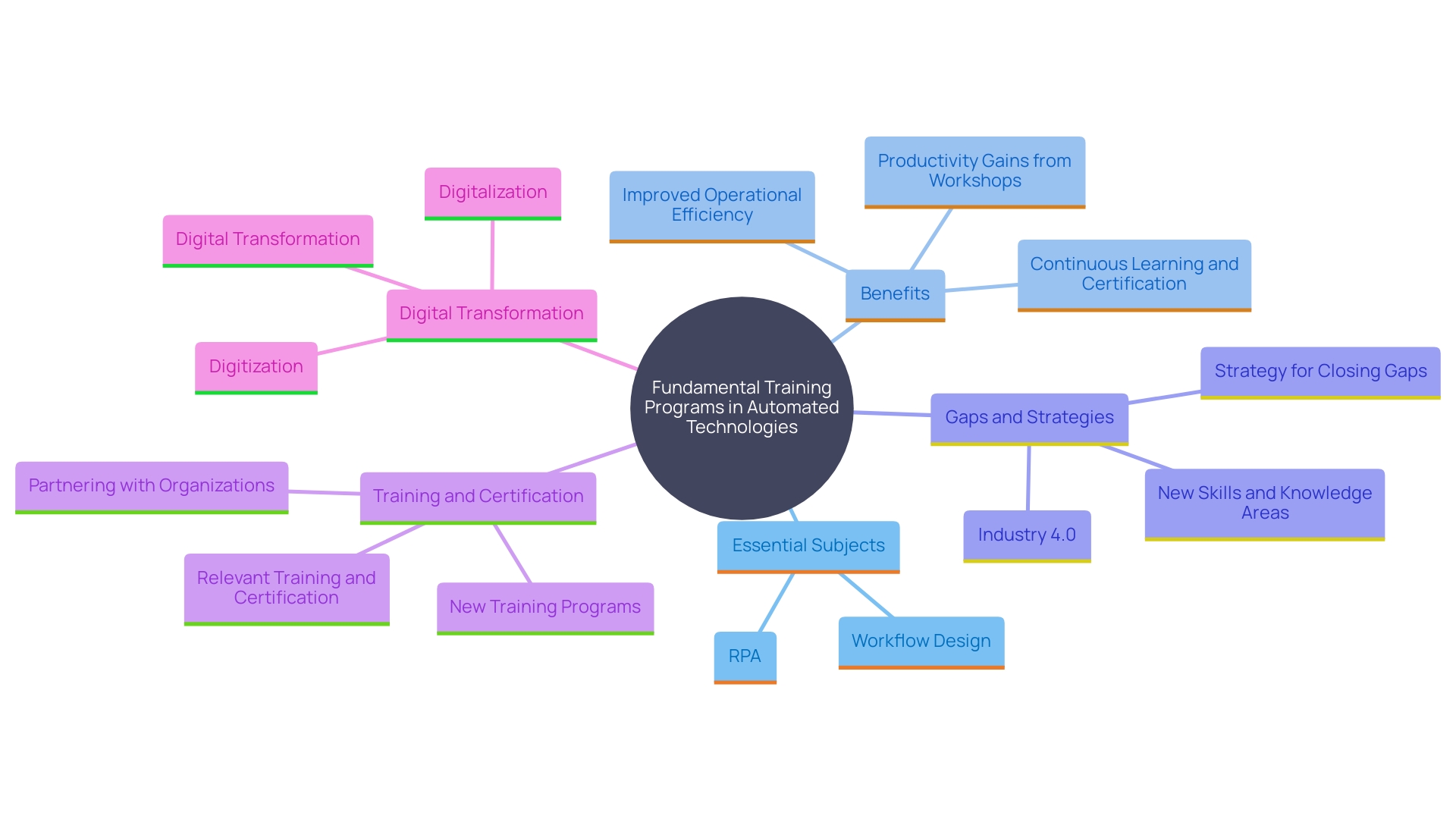
Advanced Automation Courses for Programmers and Developers
For individuals with a programming background, advanced training sessions provide a thorough examination of technical processes. These courses often emphasize best coding practices, sophisticated RPA tools, and seamless integration of automated solutions within existing IT infrastructures. Participants gain expertise in crafting custom scripts for automated processes, implementing AI-driven solutions, and optimizing workflows using various programming languages. This knowledge is essential for developing sophisticated systems that address intricate business challenges. By utilizing advanced mechanization technology, programmers can create more efficient, precise, and dependable processes, ultimately freeing up time and resources for more strategic tasks.
Free AI and Automation Courses from Reputable Universities
Renowned institutions worldwide now provide complimentary online classes in AI and technology, granting access to top-notch education guided by professionals in the field. These courses encompass a wide range of subjects, from machine learning and data analysis to specific automation methods and techniques, and include lectures, practical exercises, and evaluations. For instance, researchers carried out an extensive study involving 5,831 students from 146 nations enrolled in an online coding class, analyzing the effect of AI systems like GPT-4 on student performance and engagement. While results showed mixed outcomes, those who actively used the AI chat application demonstrated potential improvements in exam scores.
The availability of AI-driven resources is expanding rapidly, yet research on their impact on student learning, particularly in technical fields like coding, remains limited. Studies suggest that providing students with AI resources can support their learning and engagement, though further investigation is needed to optimize their integration into educational settings.
In a recent survey by EdTech company Anthology, it was revealed that U.S. university students have been slower to adopt generative AI resources compared to their global counterparts. This indicates an opportunity for educators to prepare for increased usage and to better understand the capabilities and limitations of these AI tools. By leveraging these free online resources, individuals can gain valuable skills that are increasingly in demand in the job market, enhancing their career prospects.
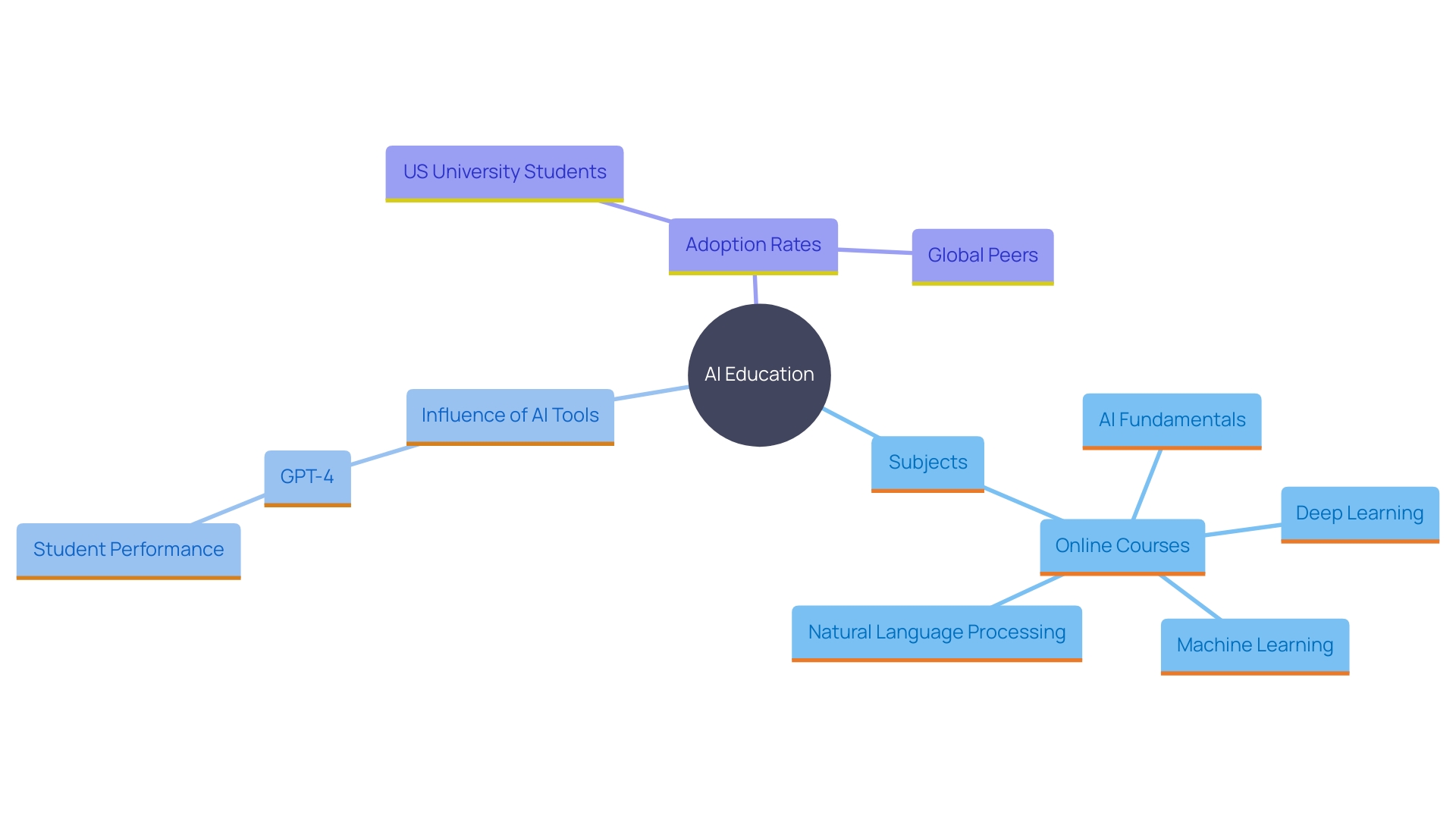
Specialized Automation Courses
Tailored training programs are carefully crafted to satisfy the distinct requirements of different sectors, such as healthcare, finance, and manufacturing. These programs equip professionals with the essential abilities to execute automated solutions customized for their particular industries. Participants will gain insights into industry-specific technology tools, compliance regulations, and best practices, ensuring successful and efficient implementation. As Karmela Peček, an instructional designer at eWyse Agency, notes, “One of the challenges in developing this project was trying to figure out different ways of showing all the technical data in a way that was easy to follow. Our goal was to transform all the tables and schemes into new forms that would be interesting enough to motivate users to discover information on their own.” This targeted approach is crucial, especially in sectors like finance and banking, where international regulations around fraud protection and Anti-Money Laundering necessitate thorough training. By concentrating on particular applications and compliance requirements, these programs enable professionals to utilize automation effectively within their roles, resulting in reduced operational expenses, enhanced precision in repetitive tasks, and more streamlined workflows. This specialization not only enhances individual competencies but also aligns with global and local market requirements, ensuring that businesses remain competitive in the rapidly evolving technological landscape.
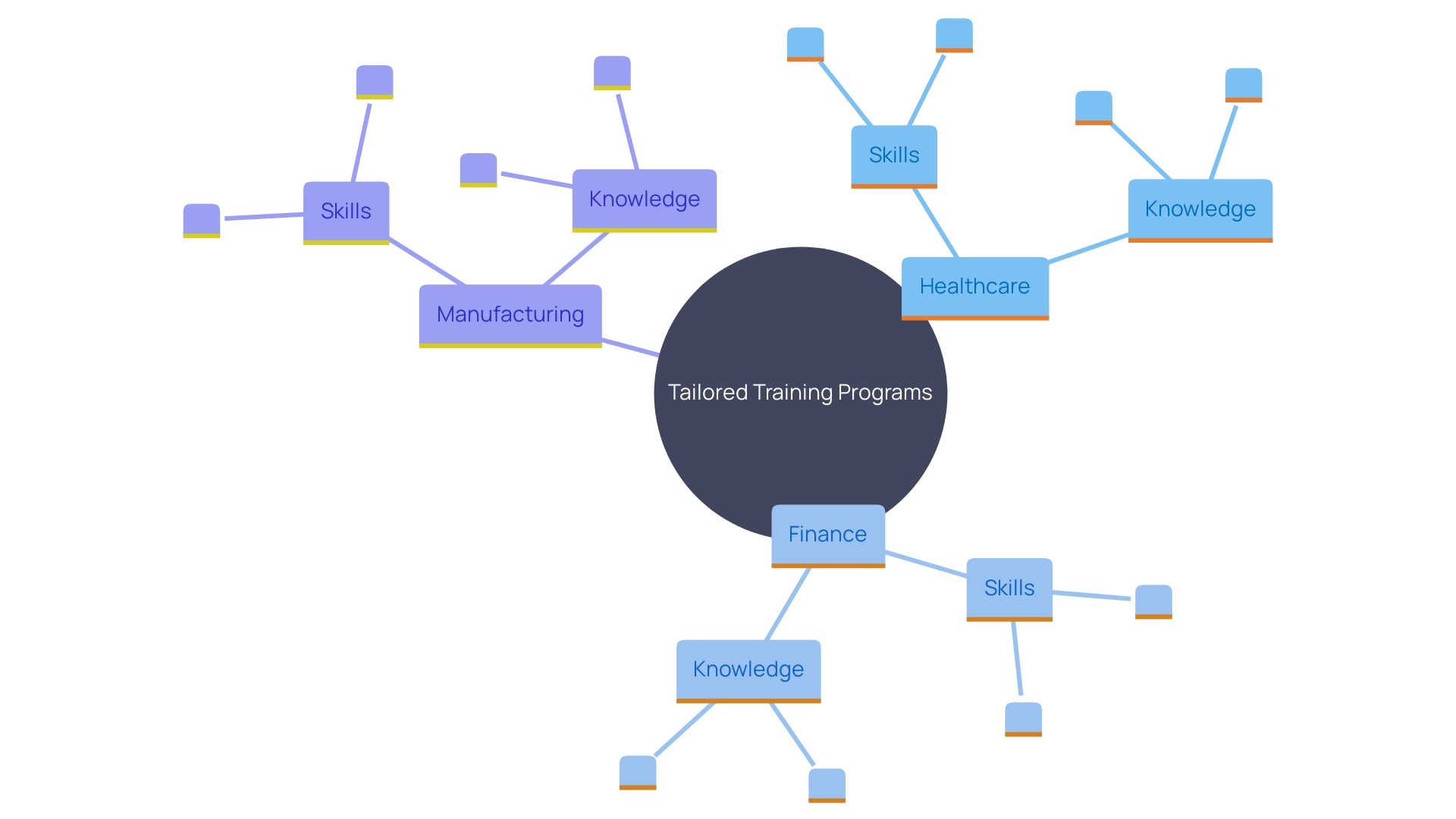
Automation Testing Courses
Automation evaluation programs are crucial for quality assurance specialists aiming to optimize their assessment procedures. These courses explore different evaluation frameworks, resources, and approaches, allowing participants to automate test scenarios, manage test settings, and efficiently employ assessment resources. For instance, the use of tools like Postman has shown to eliminate repetitive steps, saving significant time and effort. Furthermore, including AI technologies such as Natural Language Processing (NLP) improves test coverage and accelerates the evaluation process by automating repetitive tasks like test execution and result analysis.
The practical benefits of these courses are evident in real-world applications. For example, at California State University, using Postman in a structured manner has streamlined their processes, allowing for better collaboration and transparency within large teams. Furthermore, incorporating AI into software evaluation has demonstrated an increase in efficiency and a decrease in the number of bugs in production by as much as 60%, according to industry statistics.
Participants also gain from practical experiences, such as developing Selenium/Java test cases and utilizing tools like ChatGPT for automated processes. These practical components ensure that learners can apply their knowledge directly to their work environments, enhancing their ability to deliver high-quality software products efficiently.
In today’s fast-paced software development environment, utilizing automation evaluation is not just advantageous but crucial. By adopting these advanced testing techniques, quality assurance professionals can significantly reduce testing time, improve software quality, and stay ahead in the competitive market.
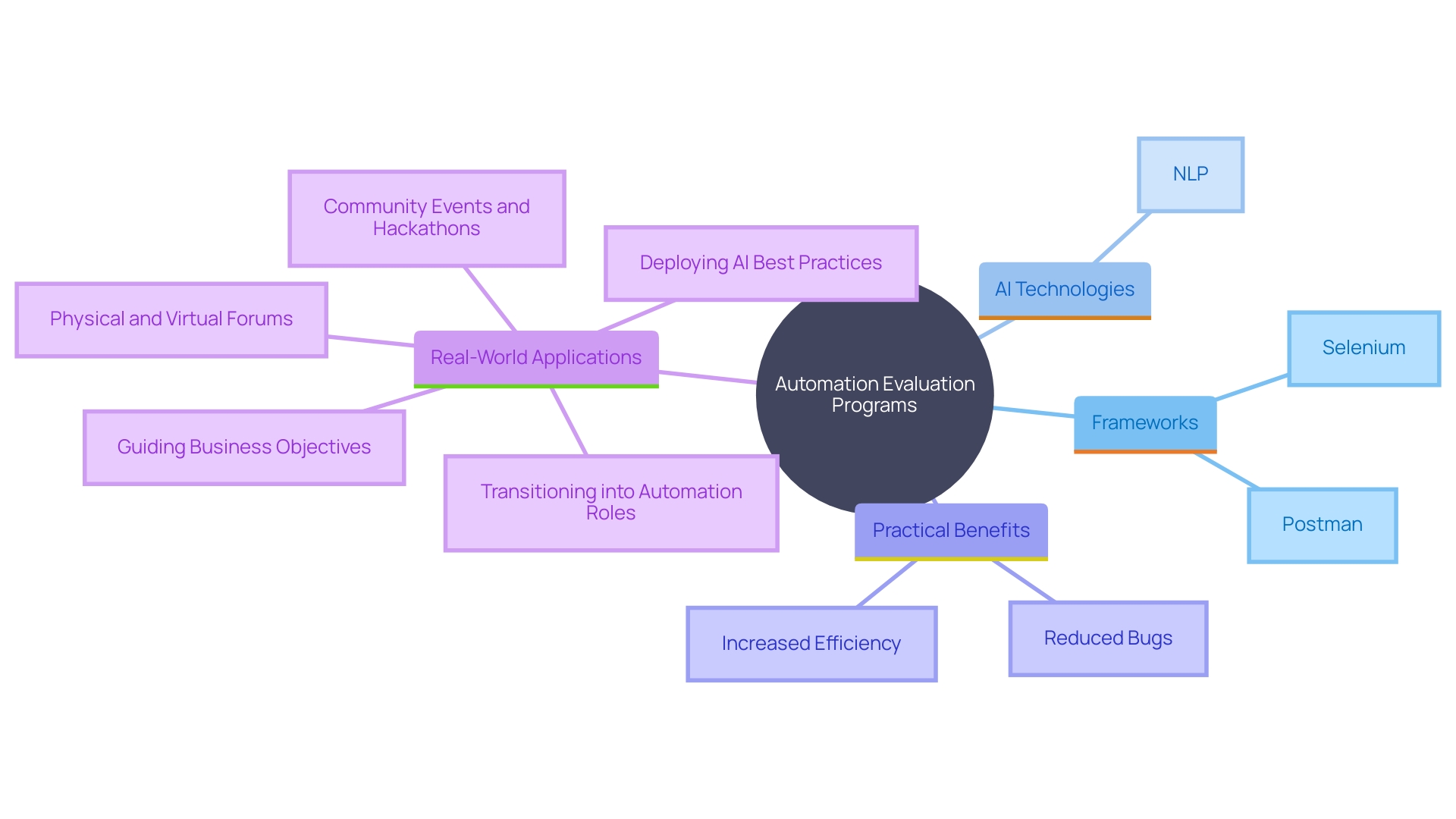
Conclusion
The exploration of automation courses reveals a multifaceted approach to enhancing operational efficiency across various sectors. Foundational courses provide critical insights into the principles of automation, empowering individuals to improve productivity and streamline processes. The tangible benefits of such education, as seen through increased output and reduced operational costs, underscore the importance of investing in foundational knowledge to thrive in an automation-driven landscape.
Advanced automation courses cater specifically to programmers and developers, equipping them with the technical skills necessary to tackle complex challenges through sophisticated automation solutions. This specialization not only enhances individual capabilities but also fosters the creation of more efficient workflows, ultimately allowing organizations to allocate resources toward strategic initiatives.
The availability of free courses from reputable universities further democratizes access to high-quality education in AI and automation. By embracing these resources, individuals can develop in-demand skills that enhance their career prospects while contributing to the ongoing evolution of the workforce in a technology-centric economy.
Specialized and automation testing courses round out the educational landscape by addressing specific industry needs and quality assurance processes. These courses ensure that professionals are well-equipped to implement tailored automation solutions and adopt advanced testing methodologies, leading to significant improvements in accuracy and efficiency.
In summary, engaging in a diverse array of automation courses is essential for professionals seeking to enhance their operational efficiency and stay competitive in an ever-evolving technological environment. By prioritizing continuous learning and specialization, organizations can harness the full potential of automation, driving sustainable success and innovation.
Introduction
The transition from traditional data management methods to automation fabrics marks a significant transformation in how businesses utilize technology. Automation fabrics unify various automation tools and technologies, creating a seamless framework that enhances operational efficiency and responsiveness to changing business landscapes. This shift is part of the broader Industry 4.0 movement, where the digital transformation of manufacturing operations and the deployment of autonomous systems are becoming the standard.
These systems, powered by massive datasets through machine learning, enable comprehensive predictions across the manufacturing process. The integration of AI and centralized data platforms in manufacturing is not merely a trend but a crucial evolution towards more intelligent and efficient production environments. For instance, the manufacturing industry, as highlighted during the Automate 2024 show, is leveraging AI to revolutionize procurement and design processes, significantly reducing redundancy and inefficiencies.
The necessity for systems that centralize and utilize historical data is becoming increasingly evident as companies strive to optimize operations. This approach not only reduces manual efforts but also significantly enhances overall productivity, aligning with the operational goals focused on customer satisfaction and revenue growth. Furthermore, the adoption of cloud-based systems for data management underscores the importance of cybersecurity measures to protect against digital threats, ensuring the resilience and security of sensitive data.
The Evolution from Data Fabrics to Automation Fabrics
The shift from traditional data management techniques to automated systems signifies a major change in the way companies leverage technology. Automation fabrics unify various automation tools and technologies, creating a seamless framework that enhances operational efficiency and responsiveness to changing business landscapes. This change is part of the wider Industry 4.0 movement, where the digital transformation of manufacturing operations and the implementation of autonomous technologies are becoming the norm. These frameworks, fueled by extensive datasets via machine learning, allow for thorough forecasts throughout the manufacturing workflow. The integration of AI and centralized data platforms in manufacturing is not merely a trend but a crucial evolution towards more intelligent and efficient production environments. For instance, the manufacturing industry, as highlighted during the Automate 2024 show, is leveraging AI to revolutionize procurement and design processes, significantly reducing redundancy and inefficiencies. ‘The necessity for structures that centralize and utilize historical data is becoming increasingly evident as companies strive to optimize operations.’. This approach not only reduces manual efforts but also significantly enhances overall productivity, aligning with the operational goals focused on customer satisfaction and revenue growth. Furthermore, the adoption of cloud-based systems for data management underscores the importance of cybersecurity measures to protect against digital threats, ensuring the resilience and security of sensitive data.
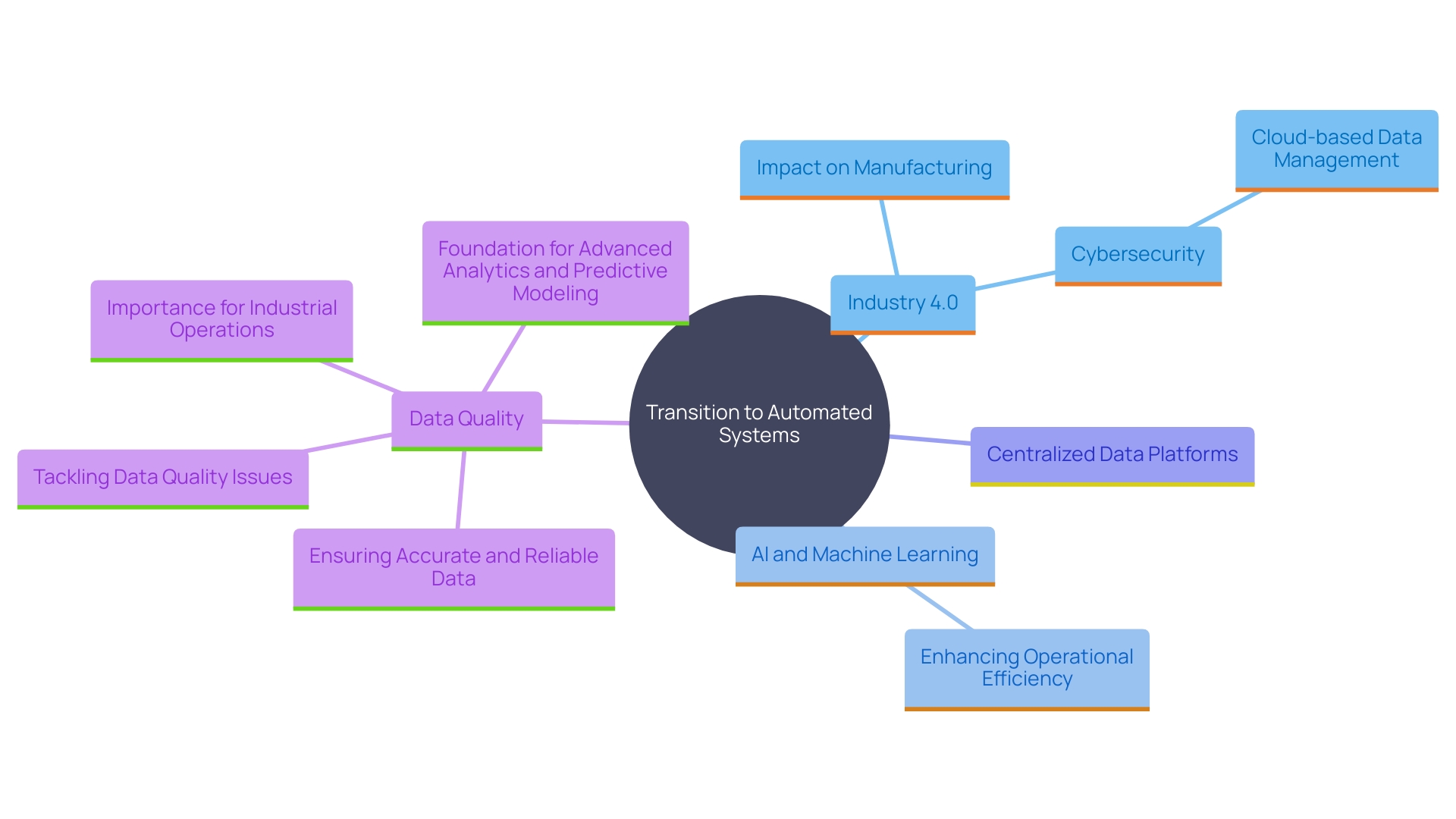
Key Components of an Automation Fabric
A strong integration framework combines several crucial elements: orchestration, integration, and monitoring resources. Orchestration software enhances the coordination among different automation activities, ensuring seamless workflows. Integration instruments connect the divide between various frameworks, establishing a unified operational environment. Monitoring tools offer real-time insights into automated processes, empowering organizations to make data-driven adjustments and optimizations. For instance, remote monitoring setups can significantly decrease downtime, as integrators can rectify errors and modify parameters from any location, enhancing efficiency without being physically present. The global market for such systems is projected to grow from $23 billion in 2020 to $31.7 billion by 2026, reflecting their increasing importance in modern operations. Additionally, these tools not only improve productivity but also address safety concerns in high-risk environments, such as metalworking facilities, by enabling remote control and error correction.
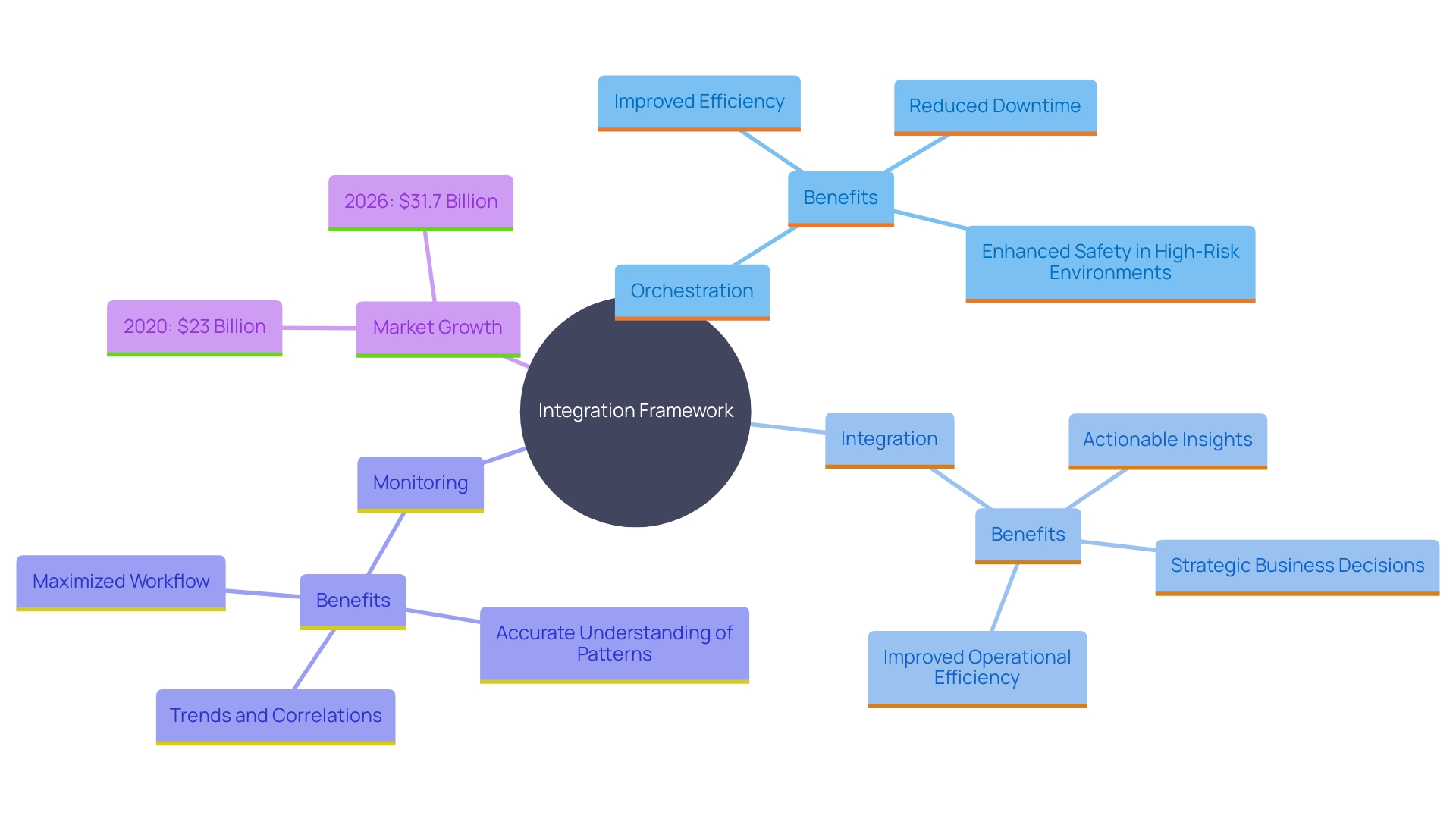
Benefits of Implementing an Automation Fabric
Establishing an automated framework provides various advantages for contemporary businesses. By automating repetitive tasks, it enhances operational efficiency and frees up resources for more strategic activities. For example, Cass County, North Dakota, employed mechanization to improve network management and reduce downtime, significantly enhancing service delivery. Likewise, Delivery Hero optimized their account recovery procedure, saving considerable time and enabling employees to concentrate on their primary duties.
Automation also improves accuracy by minimizing human error, which is crucial in maintaining high standards in operations. ‘The incorporation of various mechanization tools promotes teamwork across departments, resulting in quicker decision-making and enhanced flexibility in reacting to market changes.’. As emphasized by industry specialists, utilizing the most recent software for workflow enhancement can make teams more efficient, lower expenses, and boost competitiveness.
Furthermore, standardizing mechanization methods decreases cognitive load on teams, enhancing skill transferability and reducing the barrier to entry. This unified strategy supports the enterprise’s broader business objectives, enabling better risk management and adaptability to new technologies, as seen in the transformative impact on Cass County’s and Delivery Hero’s operations.
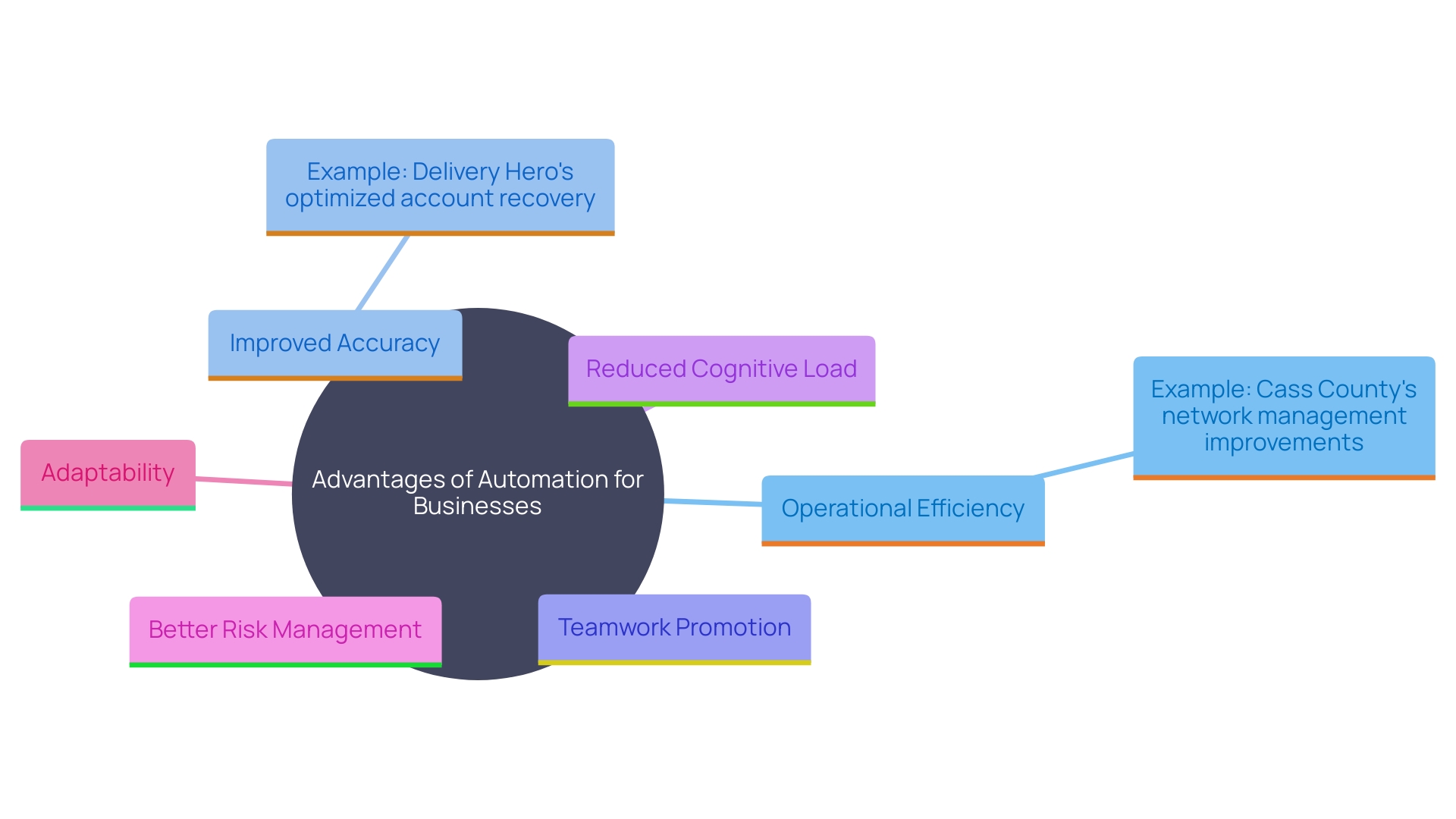
Best Practices for Building an Efficient Automation Fabric
To create an effective automated system, organizations must first clearly outline their business goals and pinpoint the essential processes for mechanization. This approach ensures alignment with overall business goals and can significantly enhance productivity and competitiveness. Working together with cross-disciplinary groups is vital to effectively incorporate technological strategies across various areas, including networking, compute, and virtualization. According to expert findings, aligning these diverse teams towards a common objective is crucial for overcoming organizational silos and fostering a unified approach to automation.
Choosing the right technology stack is another critical step. It should support scalability and flexibility to adapt to future needs. As the industry moves towards more advanced technological solutions like AI and Machine Learning, the chosen tools must enable seamless integration and evolution. Bosch’s innovative approach to sustainability with their solid oxide fuel cell (SOFC) system exemplifies how leveraging deep engineering expertise can drive efficiency and innovation.
Regularly reviewing and optimizing automated processes based on performance data is vital. This continuous improvement loop helps maintain efficiency and adapt to evolving business needs. The successful adoption of these strategies involves establishing a Center of Excellence (CODE) to provide governance and support across the organization, ensuring that technological efforts are aligned with the company’s data culture and regulatory requirements. By adhering to these principles, organizations can navigate the complexities of automation and achieve significant operational improvements.
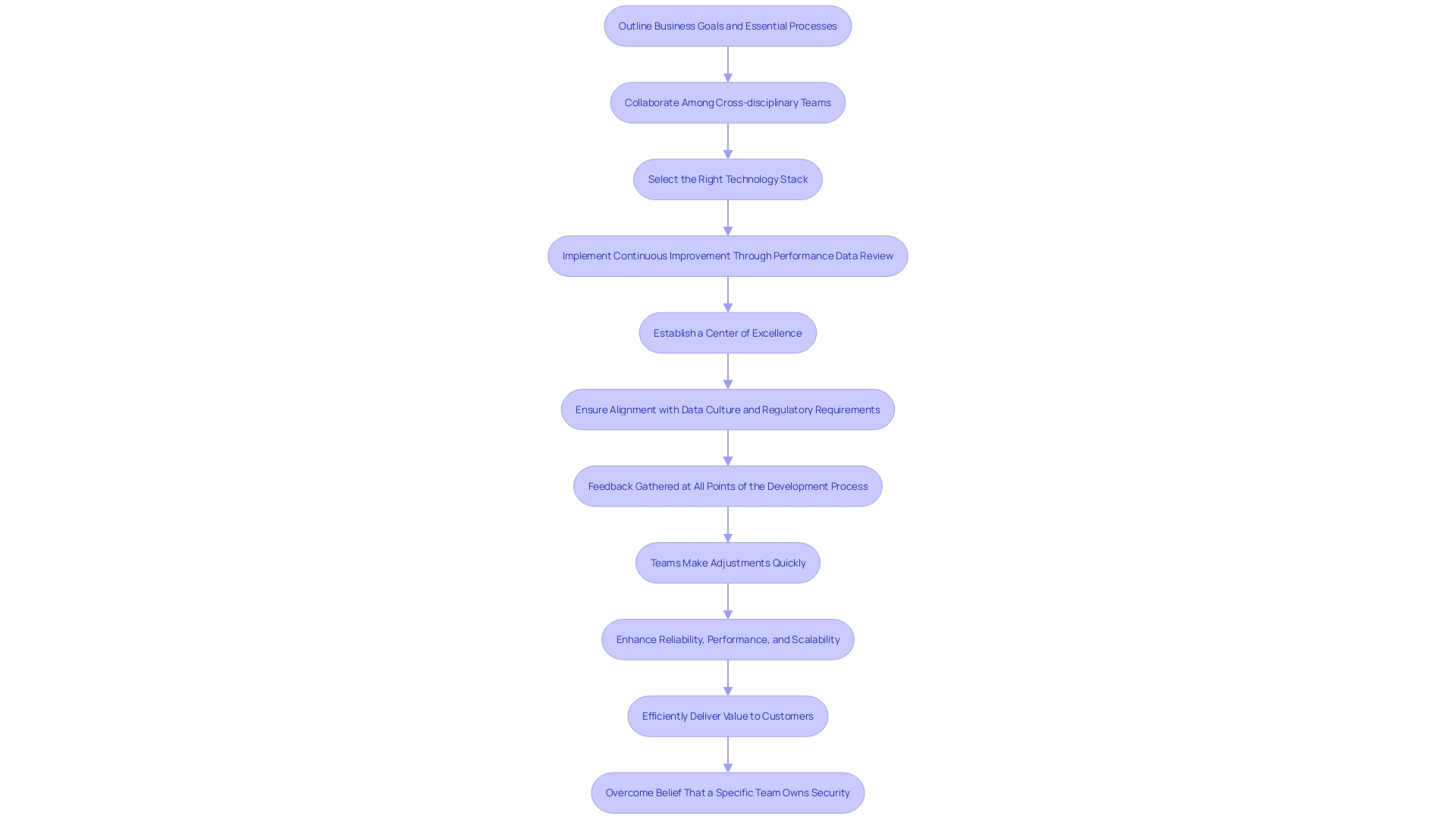
Conclusion
The transition to automation fabrics represents a pivotal advancement in modern data management, driven by the need for enhanced operational efficiency and responsiveness. By unifying various automation tools, organizations can streamline processes and adapt more readily to the evolving demands of the market. This integration is not just a response to technological trends; it is a fundamental shift that enables businesses to harness the power of AI and machine learning, leading to smarter manufacturing practices and improved productivity.
Key components of an automation fabric—such as orchestration, integration, and monitoring tools—play a crucial role in facilitating this transformation. These tools not only optimize workflows and enhance collaboration but also provide real-time insights that empower organizations to make informed decisions. The benefits of implementing such systems are evident in case studies from diverse industries, where automation has led to increased efficiency, reduced costs, and improved service delivery.
To maximize the potential of automation fabrics, organizations should adopt best practices that include clearly defined objectives, cross-functional collaboration, and the right technology stack. By establishing a Center of Excellence and committing to continuous improvement, businesses can ensure that their automation strategies align with overarching goals and adapt to future challenges. Embracing these principles will not only drive operational improvements but also position organizations for sustained success in an increasingly automated landscape.
Introduction
In an era where efficiency and agility are paramount, Business Process as a Service (BPaaS) emerges as a compelling solution for organizations aiming to streamline operations and drive innovation. By leveraging cloud-based services, BPaaS allows businesses to outsource and optimize specific functions, thus reducing costs and enhancing scalability. This model not only integrates various processes and technologies but also provides flexible, tailored solutions that cater to the dynamic needs of modern enterprises.
It’s no wonder that industries, particularly in the BFSI sector, are rapidly adopting BPaaS to stay competitive and meet evolving customer expectations. Through practical examples, such as Delivery Hero’s significant reduction in downtime and Bosch’s sustainable energy innovations, the transformative power of BPaaS becomes evident. This article delves into the definition, key characteristics, benefits, and real-world applications of BPaaS, illustrating how it can revolutionize business processes and drive operational excellence.
Definition of BPaaS
Commercial operations as a service enables organizations to provide workflows through cloud services, enhancing efficiency and lowering expenses. This model enables businesses to outsource specific functions, leveraging cloud-based applications and infrastructure. Business Process as a Service connects different processes, tools, and technologies, offering adaptable and scalable solutions customized to operational requirements.
Based on sector analysis, business process as a service is gaining more popularity because of its capability to simplify operations and improve client experiences. For instance, the BFSI segment is expected to dominate in the next six years, with banks and financial institutions adopting cloud-based solutions to meet customer expectations and remain competitive. This shift is driven by the need for agility and the rising volume of data requiring secure management.
Delivery Hero’s situation illustrates the advantages of business process as a service. The company, with over 53,000 employees, faced challenges with account lockouts, leading to significant downtime. By applying business process as a service, they streamlined the recovery process, reducing downtime and improving productivity.
As Melissa Twiningdavis from Accenture points out, “In recent years, supply chains have risen to one of the most important business functions on the CEO agenda. The challenge is to drive cost efficiency while continuing to embed and accelerate resiliency. This approach addresses this by offering cost-effective, resilient solutions that adapt to changing market demands.
Moreover, the business process as a service model supports sustainability initiatives, as evidenced by Bosch’s development of their solid oxide fuel cell (SOFC) system, which leverages digital engineering to create efficient, low-emission energy solutions. ‘This combination of business process as a service and sustainability highlights its ability to foster innovation and address worldwide issues.’.
In summary, this service represents a transformative approach that combines technology, scalability, and efficiency, making it a powerful tool for contemporary enterprises seeking to optimize their operations and remain competitive in a dynamic market.
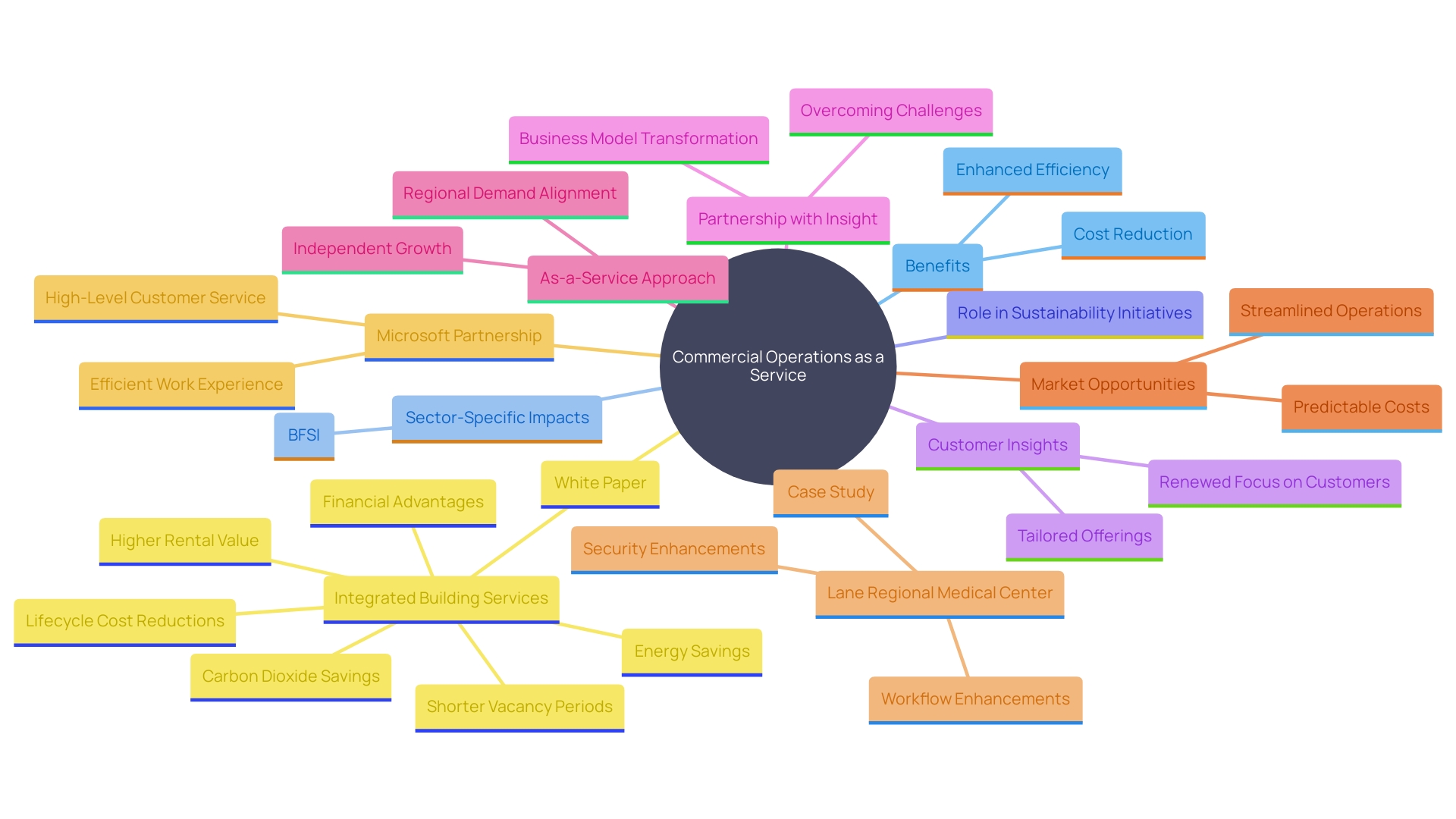
Key Characteristics of BPaaS
Business Process as a Service is notable for its cloud-based delivery, scalability, and exceptional flexibility. This creative service framework offers organizations with immediate access to operational activities, enabling them to modify resources based on their changing needs. Notably, business process as a service solutions come equipped with automated features that streamline workflows and significantly enhance operational efficiency. Consequently, businesses can focus more on their core competencies rather than getting bogged down by routine processes.
For example, Delivery Hero, a global leader in local delivery platforms, faced significant challenges due to employees frequently getting locked out of their accounts. The IT team, led by Dennis Zahrt, implemented a business process as a service solution that eliminated IT as a bottleneck, drastically reducing the time employees spent locked out and unable to work. This automated solution resulted in a more efficient workflow and allowed the company to maintain productivity levels across its extensive workforce.
Furthermore, in the competitive cloud services market, a leading provider collaborated with Insight to expand effectively across a worldwide clientele. By adopting a flexible cloud service delivery approach, the company opened 18 new data centers worldwide, focusing strategically on cost, management, and capacity planning. This transition from hardware oversight to grasping customer usage needs illustrates the flexibility and expandability that this service provides.
Statistics show that BPM software, which supports BP as a Service, simplifies and automates organizational operations, resulting in enhanced efficiency and productivity. Top BPM software solutions, such as Jira Work Management, provide advanced tools for monitoring, tracking, and reporting, allowing organizations to gain deeper insights into their operations and implement necessary improvements.
Specialists such as José Aurelio Medina-Garrido underline the financial influence of workflow management, stressing the interdisciplinary aspect and scholarly interest in business operations as a service. The systematic review of literature over the last decade underscores the importance of resource allocation and scheduling in optimizing business processes. Real-world applications, such as those seen with Delivery Hero and prominent cloud providers, demonstrate the capability of business process as a service to drive efficiency and scalability in diverse operational contexts.
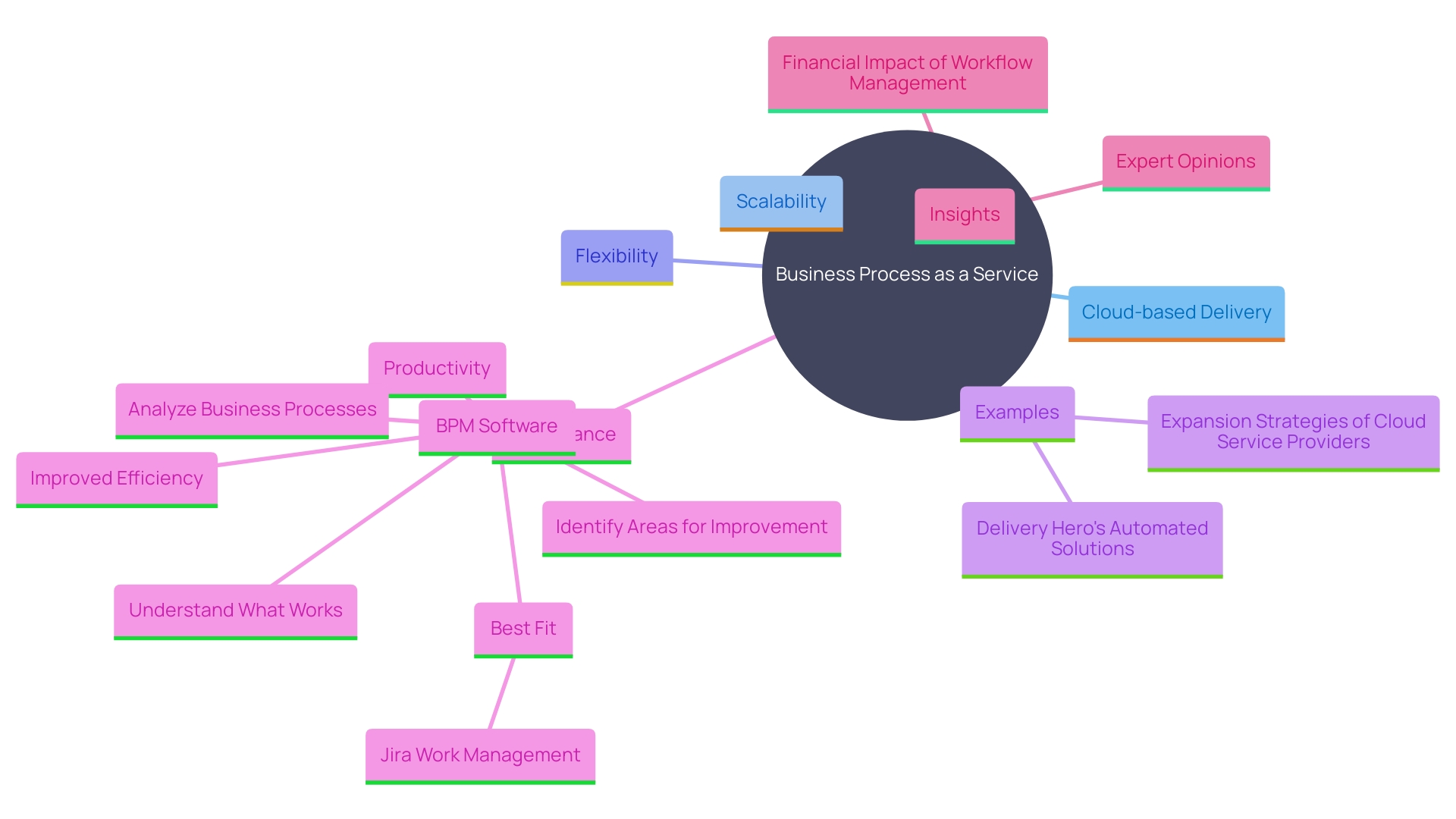
Benefits of BPaaS
Adopting business process as a service can result in substantial financial savings and improved operational efficiencies. Organizations can reduce overhead expenses related to maintaining internal systems and infrastructure. For instance, Delivery Hero, a local delivery platform operating in over 70 countries, faced challenges with account lockouts, which were time-consuming and hindered productivity. By optimizing their processes, they removed IT barriers, demonstrating how business process as a service can address inefficiencies.
This model also enhances agility, enabling companies to swiftly adapt to market changes, improve service delivery, and innovate more rapidly by leveraging the latest technologies. According to a study, 24% of companies experienced a 16% to 20% reduction in time to market for new products, and 27% saw improvements ranging from 11% to 15%. This agility is crucial in a competitive landscape, as demonstrated by a prominent cloud provider that scaled their services efficiently by partnering with Insight to drive flexibility and differentiation.
Adopting business process as a service enables companies to optimize operations, reduce costs, and provide more attractive prices, promoting heightened sales and client loyalty. This approach not only enhances operational efficiency but also positions companies to better meet the evolving needs of their clients and stay ahead in the market.
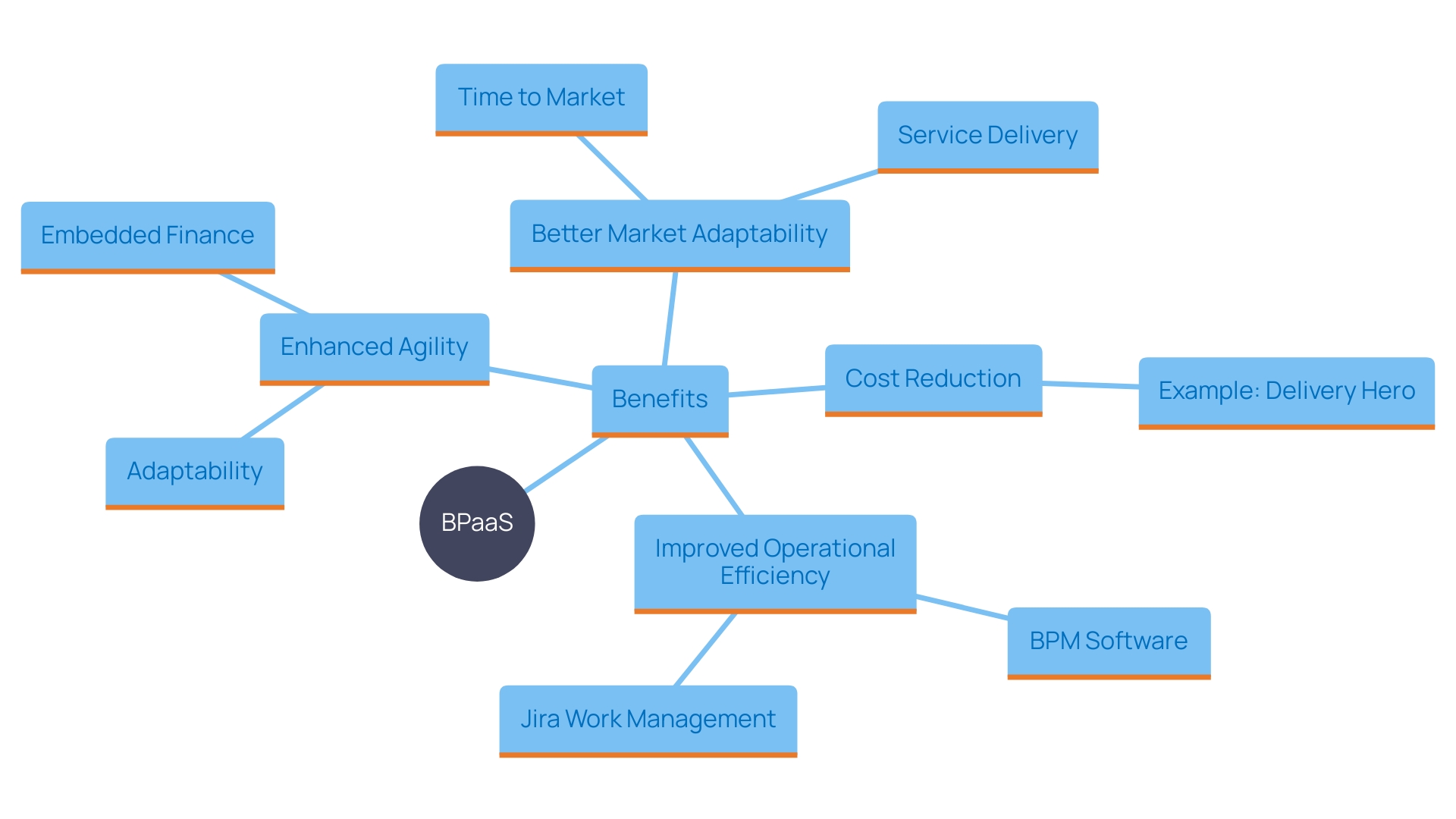
Examples of BPaaS Applications
Business Process as a Service can be effortlessly incorporated across different areas, including finance, support services, and human resources, to boost efficiency and improve client experiences. In the banking sector, business process as a service can dramatically streamline loan processing, automate regulatory compliance tasks, and elevate customer relationship management (CRM). For instance, Capital One, one of the largest retail banks in the U.S., has utilized Business Process as a Service to innovate and transform its offerings. By moving entirely to the cloud and using platforms like Slack to automate workflows and enhance collaboration among over 50,000 employees, Capital One has set a benchmark in digital transformation.
Furthermore, APIs (Application Programming Interfaces) play a crucial role in business process as a service, enabling seamless data and functionality exchange between diverse software systems. This integration is pivotal in open banking, allowing secure data sharing between banks and authorized third-party providers. As per a recent study by McKinsey, 88% of IT leaders at top banks recognize the increasing significance of APIs, with 81% marking them as a priority for both operational and IT functions.
BPaaS also offers substantial improvements in efficiency and client engagement. By automating business processes and minimizing manual intervention, banks can process large volumes of data quickly and accurately. Automated data processing, whether through batch or real-time processing, ensures up-to-date information is readily available for timely decision-making. This not only boosts productivity but also enhances the overall customer experience.
Furthermore, industry leaders like Moody’s Analytics emphasize the transformative potential of Business Process as a Service in the financial sector. By integrating data, analysis, and innovative technology, BPaaS providers help financial institutions navigate the complexities of modern banking with confidence. Leveraging these advanced tools, banks can streamline operations, reduce risks, and deliver exceptional services to their customers, ultimately fostering customer loyalty and satisfaction.
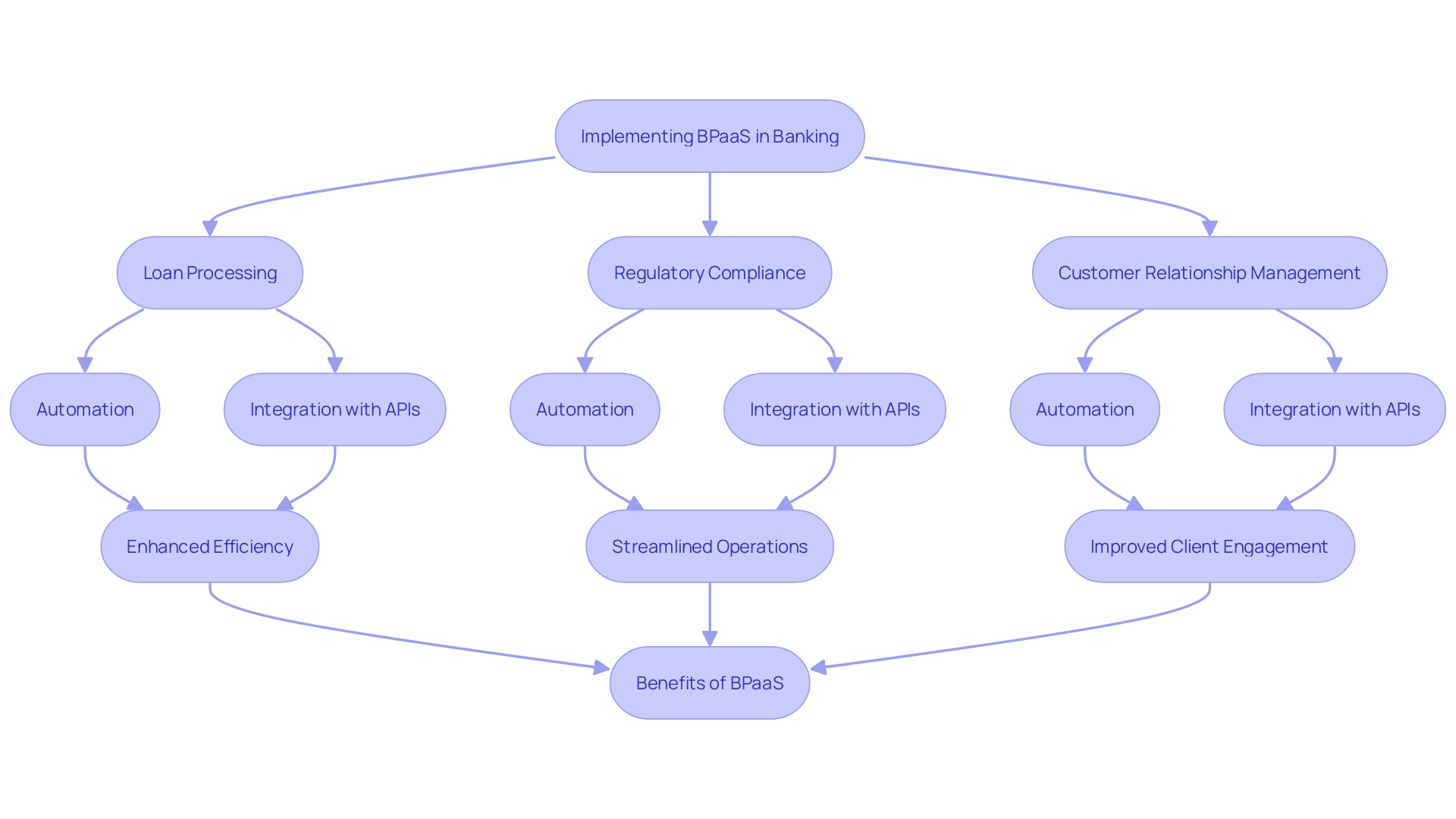
Conclusion
The exploration of Business Process as a Service (BPaaS) reveals its significant potential for transforming organizational operations. By enabling businesses to outsource and optimize specific functions through cloud-based solutions, BPaaS not only enhances efficiency but also reduces operational costs. The integration of various processes and technologies allows organizations to remain agile and responsive to market demands, particularly in sectors like BFSI, where maintaining a competitive edge is crucial.
Real-world applications, such as those demonstrated by Delivery Hero and Capital One, underscore the effectiveness of BPaaS in addressing operational challenges. These examples illustrate how BPaaS can streamline workflows, enhance productivity, and foster innovation. Moreover, the flexibility and scalability inherent in BPaaS solutions empower organizations to adapt swiftly to evolving customer expectations and market trends, ultimately driving customer loyalty and satisfaction.
In conclusion, embracing BPaaS offers a pathway to operational excellence, enabling organizations to focus on core competencies while leveraging advanced technologies for improved service delivery. The strategic adoption of BPaaS not only positions companies for immediate benefits but also equips them with the tools necessary to thrive in an increasingly competitive landscape. The future of business efficiency lies in the hands of those who recognize and harness the transformative power of BPaaS.
Introduction
Artificial intelligence (AI) has become a cornerstone of modern technological advancement, and Microsoft stands at the forefront of this revolution. By leveraging both large and small language models, Microsoft has developed scalable AI solutions that cater to a wide range of operational needs. These models, capable of understanding and generating human-like text, are transforming industries by processing vast amounts of information and delivering smarter, more responsive systems.
The company’s strategic shift towards cost-effective small language models, like the renowned Phi-3, exemplifies Microsoft’s commitment to making AI more accessible and practical for diverse applications, including those with limited resources. This article delves into Microsoft’s innovative AI platform, groundbreaking research, and the impactful integration of AI in its products and services, demonstrating how these advancements are driving efficiency and productivity across various sectors.
AI at Scale: Leveraging Large Language Models
The company has made significant progress in utilizing large and small linguistic frameworks to improve its AI capabilities, ensuring a scalable solution for diverse operational needs. These systems are created to comprehend and produce human-like text, making them essential for various applications. By utilizing vast datasets and advanced algorithms, the company’s AI can process and analyze massive amounts of information, leading to smarter, more responsive systems that cater to user needs.
For example, Microsoft’s Phi-3 systems are renowned for being the most proficient and economical small linguistic frameworks currently accessible. ‘This transition towards compact linguistic frameworks (CLFs) is propelled by the necessity to reduce expenses and hardware demands, rendering AI more attainable and functional for diverse uses, including resource-limited settings such as mobile gadgets and integrated systems.’. A case study revealed that smaller structures could achieve competitive performance on specific tasks while using significantly fewer computational resources than their larger counterparts.
This approach aligns with the industry’s trend towards specialized systems designed for particular tasks, rather than the one-size-fits-all strategy of large language systems (Loss). As the investments from the technology giant in SLMs demonstrate, these smaller systems can offer more effective and focused responses for particular tasks, such as examining consumer behavior for targeted advertising. The focus on smaller versions is further backed by findings that indicate AI systems’ abilities increase with the number of parameters, but the practical advantages of smaller versions cannot be ignored.
The dedication to the advancement of both large and small language systems suggests a future where AI solutions can be customized to meet the distinct needs of different organizations, improving productivity and operational effectiveness across various fields.
Microsoft’s AI Platform and Innovations
The company’s commitment to enhancing AI technology is evident in its strong platform that effortlessly incorporates a range of AI tools and services. This comprehensive platform empowers developers and businesses to efficiently build, train, and deploy models, transforming the way they operate. With innovations like Azure AI and Cognitive Services, users can effortlessly incorporate AI into their applications, democratizing access to advanced technology.
For instance, Ally leveraged the Azure OpenAI Service to develop robust, reliable, and secure AI capabilities. Scott Richardson, Chief Information Officer of Enterprise Data and Analytics at Ally, emphasizes, “The massive investment made by the tech giant in OpenAI helped move things forward, but the key thing is that they really understand our need to implement robust, reliable, and secure capabilities.” Ally’s collaborative approach, involving business, technical, and customer service teams, ensured that their AI offerings were fine-tuned to meet specific needs, demonstrating the transformative potential of these AI tools.
Furthermore, the tech giant’s strategic alliance with the London Stock Exchange Group (LSEG) exemplifies the significant impact of AI in reshaping industries. By merging the horizontal software strengths of the tech giant with LSEG’s financial market infrastructure and analytics, they provide AI-driven offerings designed to fulfill the unique requirements of financial services organizations. This collaboration enables customers to realize increased value faster, with streamlined workflows, ultimately generating reliable, trusted, and relevant insights.
Investing in AI tools such as 365 Copilot has demonstrated significant benefits for companies. According to a Forrester study, businesses can experience a return on investment (ROI) ranging from 132% to 353% over three years. Early adopters have already seen transformative impacts, highlighting the strategic importance of AI in driving long-term growth and efficiency.
As the tech giant continues to innovate, it remains committed to safe and responsible AI development. This commitment ensures that organizations of all sizes can harness the power of AI, overcoming challenges like talent shortages and complex software development needs. By embracing AI and low-code solutions, businesses can boost productivity, enhance security, and remain competitive in an increasingly data-driven world.
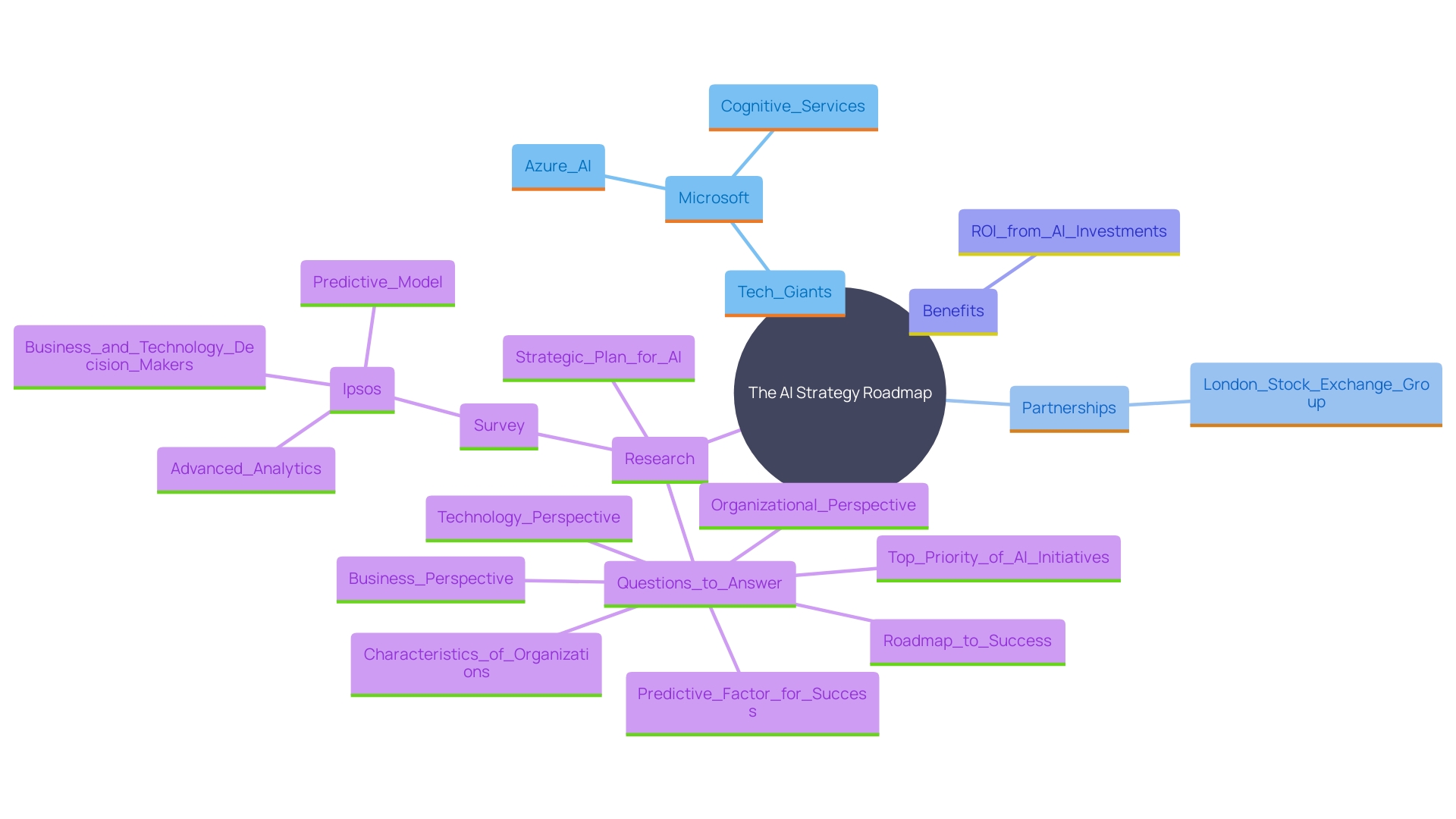
Advancements in AI Research and Model Development
Microsoft’s ongoing research plays a crucial role in advancing AI technology, continuously pushing the boundaries of what AI can achieve. The company invests significantly in developing new designs that enhance reasoning capabilities and contextual understanding. For instance, the InsightPilot system simplifies data exploration by leveraging large language frameworks to streamline the analysis process, demonstrating the practical applications of AI in data-driven decision-making.
Collaboration with academic institutions and industry leaders further amplifies the company’s research efforts. The Accelerate Foundation Models Research (AFMR) initiative, for example, supports over 200 projects across universities globally, providing access to powerful foundation models via Azure. This initiative aims to align AI with human goals, values, and preferences while ensuring rapid progress through innovative evaluation methods. As Peter Lee, Corporate Vice President of Microsoft Research & Incubations, highlights, “A vibrant and diverse research ecosystem is essential to realizing the promise of AI to benefit each individual, organization, and society worldwide.”
These collaborations have led to remarkable breakthroughs, such as the development of an AI-powered pipeline in partnership with Pacific Northwest National Laboratories, which identified a novel battery storage solution that can replace up to 70% of lithium in batteries. This advancement showcases AI’s potential in discovering new materials for sustainability and other fields.
Furthermore, the company’s dedication to responsible AI research is clear in their continuous efforts to improve transparency and safety. Recent work includes exploring the intersection of AI and society, transforming healthcare, and evolving foundational AI technologies. Chris Bishop, Technical Fellow and Director of Research AI4Science, emphasizes the transformative impact of AI on scientific discovery, noting that it is through understanding the natural world and applying technology that humanity has achieved significant progress.
These advancements not only improve existing products but also pave the way for unforeseen applications of AI, reinforcing the company’s position at the forefront of AI innovation.

AI Applications in Microsoft Products and Services
The company has revolutionized its product suite by embedding AI across Office 365 and Dynamics 365, transforming how businesses operate. Through features like intelligent search, automated insights, and natural language processing, AI enhances user experience and drives productivity. For instance, the introduction of Copilot for 365 integrates generative AI features into applications such as Word, Excel, PowerPoint, Outlook, and Teams, significantly reducing the time and energy required for numerous routine tasks. A survey of 297 early adopters revealed that the most efficient users saved up to 30 minutes per day, equating to 10 hours a month.
The impact of AI is evident across various industries. In the financial sector, Ally Financial utilizes Azure and Azure OpenAI Service to automate manual tasks for its customer service associates, reducing post-call effort by 30% and capturing critical information with over 85% accuracy. Similarly, Amadeus, a worldwide travel technology provider, deployed Copilot for Office 365 to empower its workforce, starting with early adoption among a subset of employees.
Moreover, the aviation industry is experiencing a transformation driven by generative AI. Research indicates that AI-powered decision-making can reduce flight delays by up to 35%, enhancing safety and efficiency for travelers and staff. These advancements illustrate the practical benefits of AI, making it an indispensable ally in improving operational processes and elevating productivity across sectors.
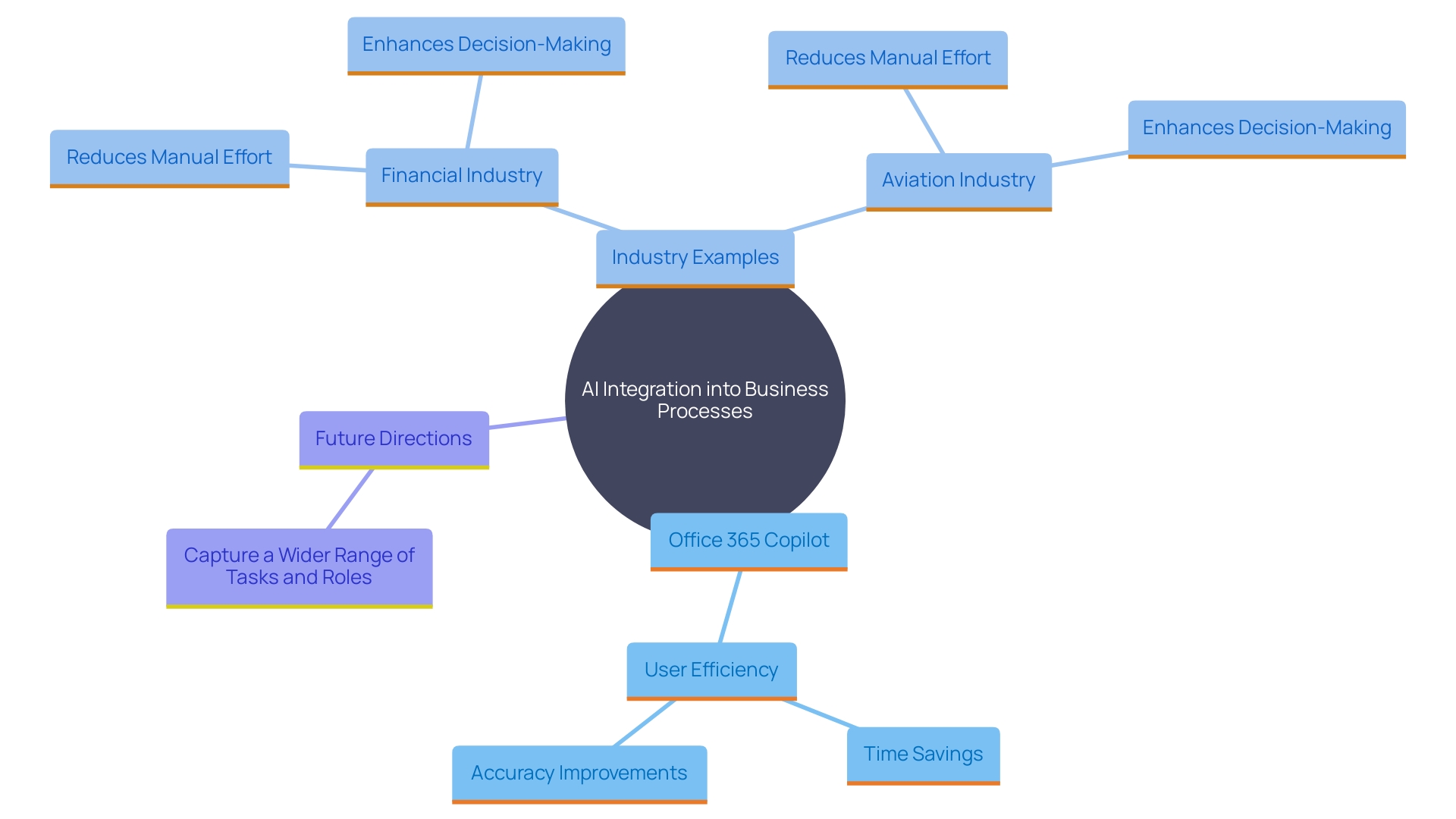
Future Directions and Impact of AI Innovations
Looking ahead, the company is poised to redefine the landscape of AI with its innovative strategies. The focus is not only on enhancing existing technologies but also on exploring new paradigms such as ethical AI and responsible AI deployment. By prioritizing transparency and user trust, the company aims to shape a future where AI serves as a positive force for societal advancement. This forward-thinking approach positions Microsoft as a leader in the responsible evolution of AI, ensuring that its innovations contribute meaningfully to businesses and society.
Conclusion
Microsoft’s integration of AI has significantly transformed various sectors by utilizing both large and small language models. This focus on cost-effective small language models, such as the Phi-3, illustrates the commitment to making advanced AI accessible, particularly in resource-constrained environments. Organizations can customize AI applications to meet specific needs, resulting in smarter and more responsive systems.
The comprehensive AI platform, featuring innovations like Azure AI and Microsoft Cognitive Services, empowers businesses to leverage AI effectively. Collaborations with partners such as Ally and the London Stock Exchange Group demonstrate the tangible benefits of these technologies, yielding substantial returns on investment and enhanced operational workflows. A commitment to responsible AI development ensures that advancements are not only impactful but also aligned with ethical standards.
Research initiatives like the Accelerate Foundation Models Research underscore Microsoft’s dedication to advancing AI capabilities through partnerships with academic institutions and industry leaders. This collaboration drives breakthroughs that address real-world challenges while maintaining a focus on transparency and ethical considerations.
As Microsoft continues to innovate, the potential for AI to reshape industries and drive long-term growth is significant. The integration of AI across Microsoft products enhances user experiences and streamlines processes, setting a standard for technology that serves the greater good. With a forward-looking approach, Microsoft is leading the AI revolution and ensuring that its innovations contribute meaningfully to businesses and society.
Introduction
In the ever-evolving landscape of business operations, the pursuit of efficiency and effectiveness is paramount. Business Process Management (BPM) and Business Process Automation (BPA) emerge as critical strategies for organizations aiming to streamline workflows, reduce errors, and enhance productivity. This article delves into the intricacies of BPM and BPA, highlighting their definitions, benefits, practical applications, and future potential.
By exploring real-world examples and industry insights, it offers valuable guidance for directors of operations efficiency seeking to implement these powerful tools. Embracing BPM and BPA not only fosters continuous improvement but also equips organizations to adapt swiftly to market changes, ensuring sustained growth and a competitive edge.
What is Business Process Management (BPM)?
Business Process Management (BPM) is a strategic approach to enhancing an organization’s workflows by leveraging various methodologies and tools. It involves modeling, analyzing, and optimizing existing processes to boost efficiency and effectiveness. BPM aligns operational processes with organizational objectives, fostering continuous improvement and adaptability to market changes. For instance, TBC Bank’s agile transformation aimed at reducing organizational complexity and enhancing operational speed highlights the critical role of BPM in achieving company growth. BPM software, like Jira Work Management, simplifies and automates tasks, thus enhancing productivity and effectiveness. By engaging stakeholders early and setting clear objectives, organizations can achieve measurable outcomes like cost reduction and improved customer service. The integration of behavioral nudging into BPM phases also offers a human-centric approach, making processes more sustainable and adaptable.
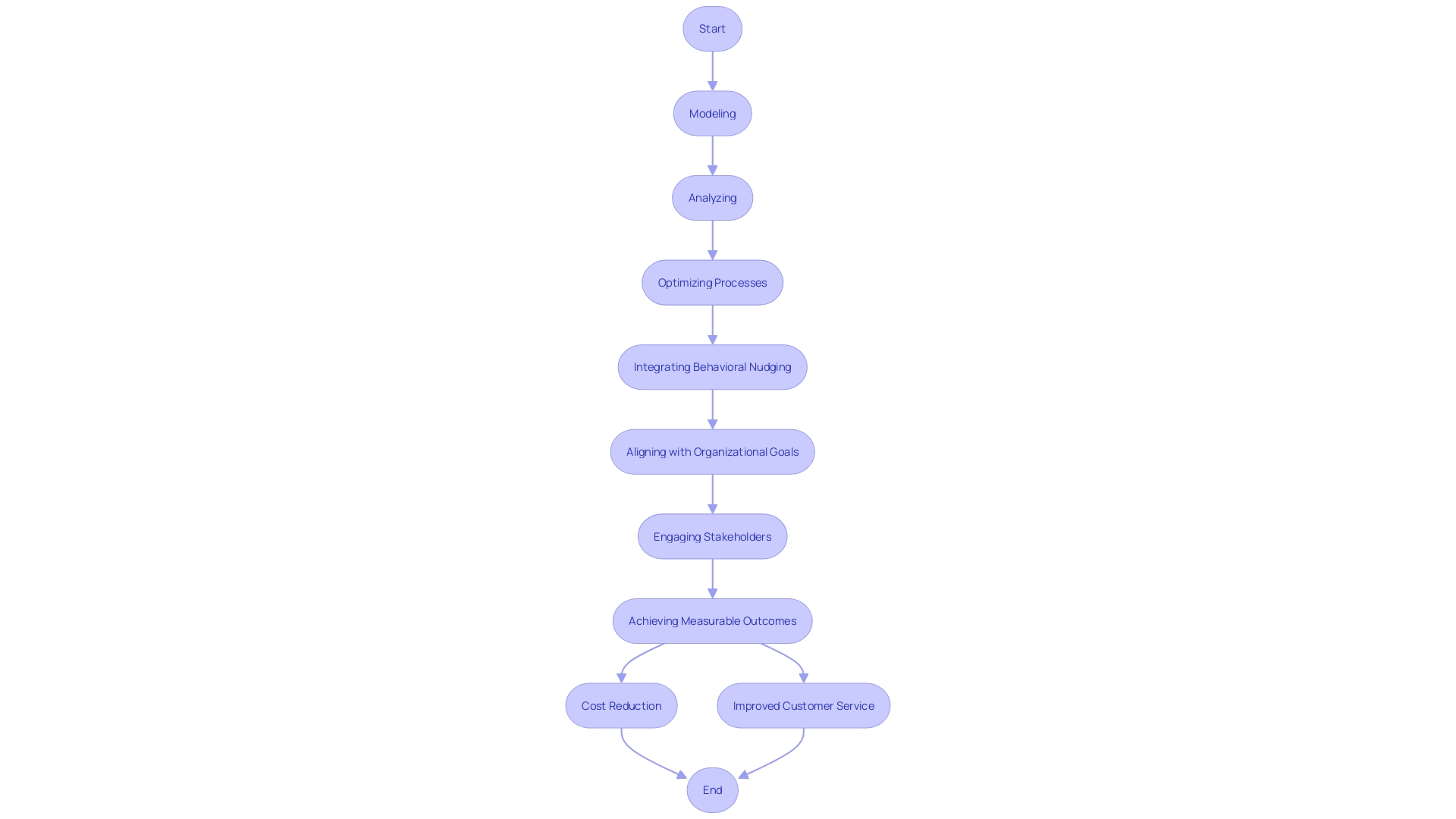
What is Business Process Automation (BPA)?
Business Process Automation (BPA) leverages technology to streamline and automate repetitive tasks within business workflows. This approach aims to improve productivity, minimize manual intervention, and significantly reduce error rates. By implementing BPA, organizations can boost productivity, accelerate operations, and optimize resource allocation, leading to superior service delivery and heightened customer satisfaction.
For instance, St. James Winery, a leading U.S. wine producer, turned to automation to manage increased growth and labor shortages. This strategic move not only improved production speeds but also enhanced their margins and overall effectiveness. The winery measures ROI in terms of labor per case, showcasing tangible benefits from automation.
BPA is particularly beneficial across various industries for automating processes like data entry, administrative tasks, customer relationship management, and supply chain management. The market for Industrial Automation Services is projected to grow from $147.06 billion in 2019 to $264.69 billion by 2026, reflecting the increasing adoption of automation technologies.
Moreover, statistics indicate that while automation can lead to job displacement, it also offers opportunities for improved job satisfaction and operational agility. For example, 69% of managerial work is expected to be automated by 2024, highlighting a shift towards more strategic roles for human workers.
‘Business Workflow Management (BPM) tools are essential to BPA, providing features like drag-and-drop builders, real-time analytics, and workflow automation.’. These tools not only improve effectiveness and productivity but also aid informed decision-making and cost reduction. As companies continue to evolve, adopting BPA becomes crucial for maintaining competitive advantage and meeting market demands effectively.
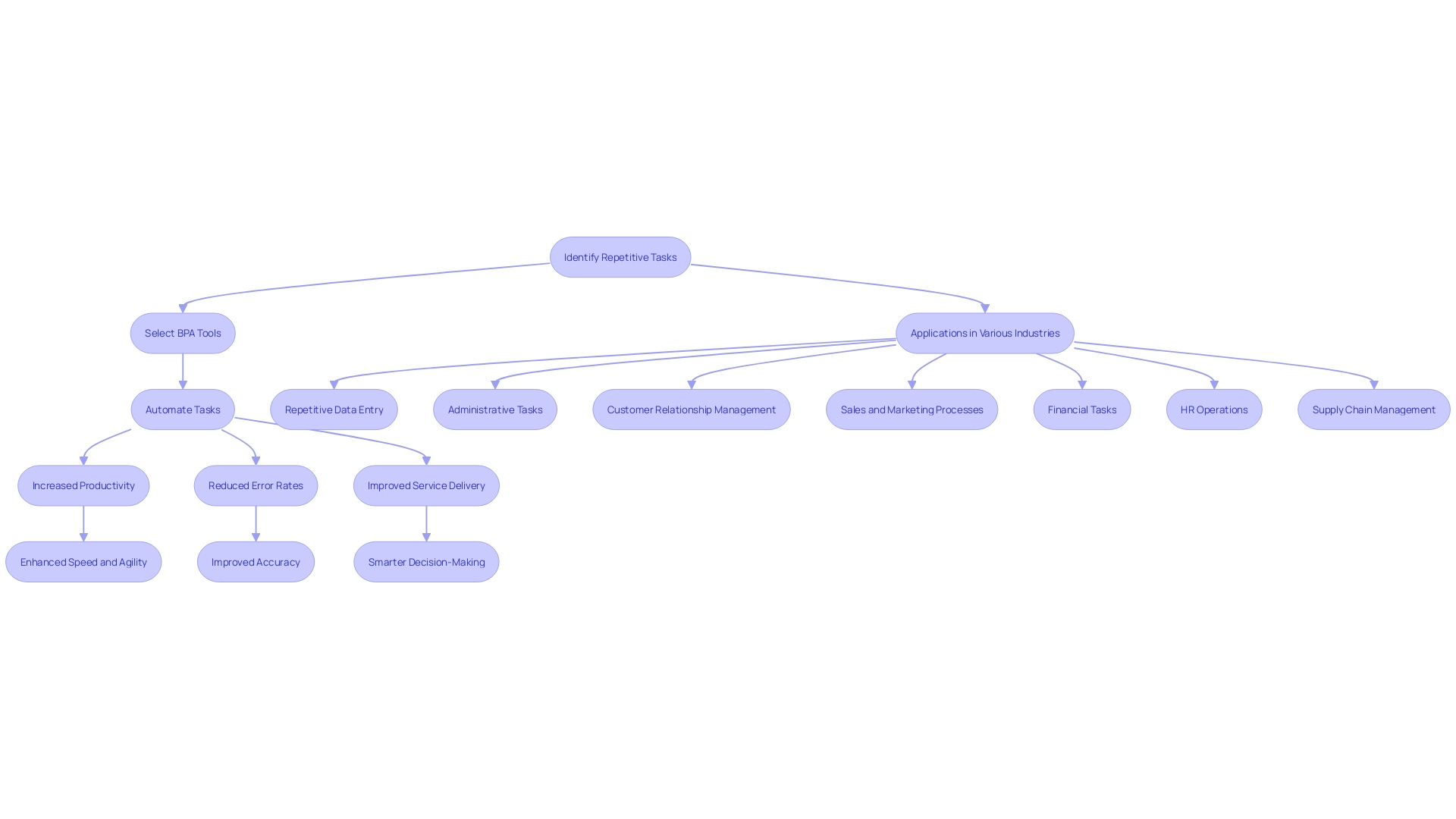
Benefits of Business Process Automation
Business Process Automation (BPA) offers an array of benefits that can transform operations. By automating routine tasks, BPA significantly enhances operational efficiency, leading to faster service delivery. A key advantage is the reduction of human errors, which ensures higher quality outcomes. For instance, St. James Winery, a leading wine producer in the U.S., has seen higher production speeds and better margins through automation, realizing ROI in terms of labor per case.
Moreover, BPA allows employees to redirect their efforts towards more strategic initiatives, fostering innovation and creativity within the organization. This change not only improves employee satisfaction but also fuels company growth. Automation technology allows companies to scale operations efficiently, managing more transactions swiftly and enhancing competitiveness.
Cost savings are another major advantage. Automating processes can lower labor costs and reduce wasted resources. A study highlighted that small businesses could significantly reduce operational costs by automating repetitive, time-consuming tasks. Furthermore, efficient data processing methods such as batch and real-time processing maximize the benefits of automation, providing timely access to crucial information for decision-making.
As highlighted by specialists, “Executing tactics, clarifying misunderstandings, and acquiring a deeper insight into the benefits are crucial to unlocking all the possibilities in intelligent automation.” Business Workflow Automation is not merely about productivity; it represents a strategic method for attaining digital transformation and maintaining an edge in a competitive landscape.
Practical Applications of BPA
Business Process Automation (BPA) is transforming various sectors such as finance, healthcare, manufacturing, and customer service by automating repetitive and time-consuming tasks. In finance, for instance, BPA is pivotal in invoice processing and compliance reporting. A leading financial institution leveraged advanced fraud detection algorithms to identify suspicious transactions, significantly reducing fraudulent activities and bolstering customer trust.
In healthcare, BPA enhances patient care through automated scheduling and efficient record management. A healthcare organization implemented predictive analytics to forecast patient admission rates, optimize resource allocation, and ultimately improve patient outcomes. This resulted in lowered operational expenses and increased overall effectiveness in healthcare delivery.
Manufacturing also reaps substantial benefits from BPA. By automating inventory management and quality control, manufacturers can streamline workflows and reduce downtime. A manufacturing company adopted smart manufacturing capabilities to monitor machine performance, identify bottlenecks, and enhance productivity, resulting in increased profitability.
Each application of BPA demonstrates its potential to elevate operational efficiency and effectiveness, driving smarter decision-making and agility in today’s fast-paced business environment.
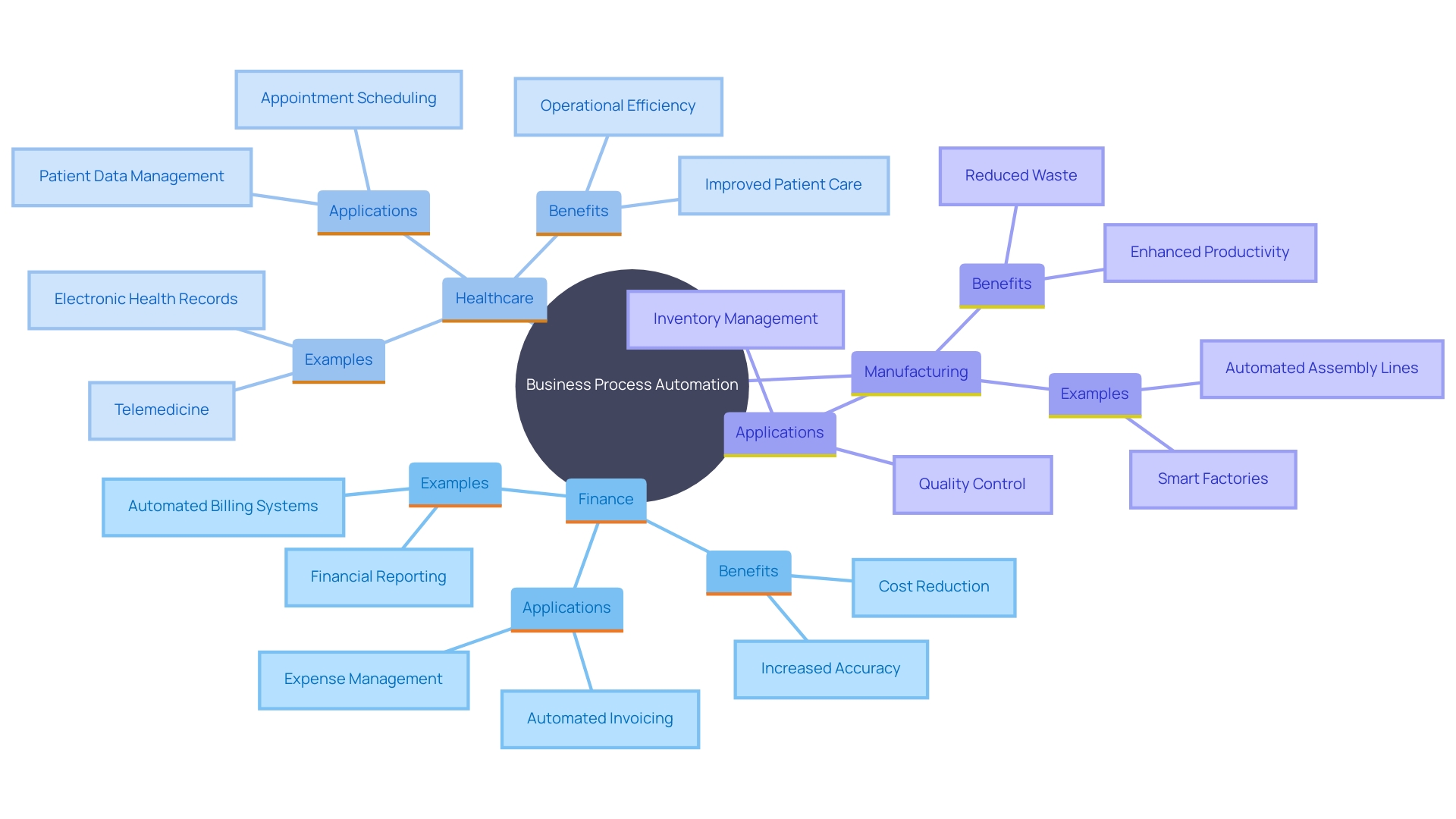
Future of Business Process Automation
‘The future of Business Automation (BPA) is increasingly bright, driven by advancements in artificial intelligence, machine learning, and robotic automation.’. These technologies are enabling organizations to automate more complex processes, offering greater scalability and flexibility. As Ludovic Doudard, General Manager Process Engineering Supply Chain at Renault, noted, the company’s AI tools development is expected to generate 45 million euros in digital value through 25 projects. This rapid deployment showcases how BPA can transform decision-making, amplifying precision and speed in organizational operations.
The Industrial Automation Services Market is projected to grow from $147.06 billion in 2019 to $264.69 billion by 2026. Such growth underscores the importance of BPA in achieving operational excellence and sustaining competitive advantage. As companies continue their digital transformation journeys, BPA will be pivotal. For instance, Renault’s use of AI to automate the extraction of key values from over 2,000 PDF documents has freed up employees for more meaningful work, demonstrating the real-world impact of BPA.
Furthermore, the trend toward digital and AI transformation is reshaping corporate strategies. Companies are increasingly recognizing that every worker is becoming a knowledge worker, and advanced AI capabilities are becoming integral to their roles. The capacity to utilize data efficiently is essential for creating operational value. As highlighted by industry leaders, a digital and AI transformation is a journey to continuously enhance competitiveness by quickly incorporating new technologies.
‘The ongoing shift in corporate strategies, as companies adapt to changing market dynamics, further illustrates the transformative power of BPA.’. By focusing on long-term metrics, objectives, and key results, organizations can ensure that their digital transformations have a lasting impact. This alignment of technology and business strategy is essential for maintaining a competitive edge in today’s rapidly evolving market landscape.
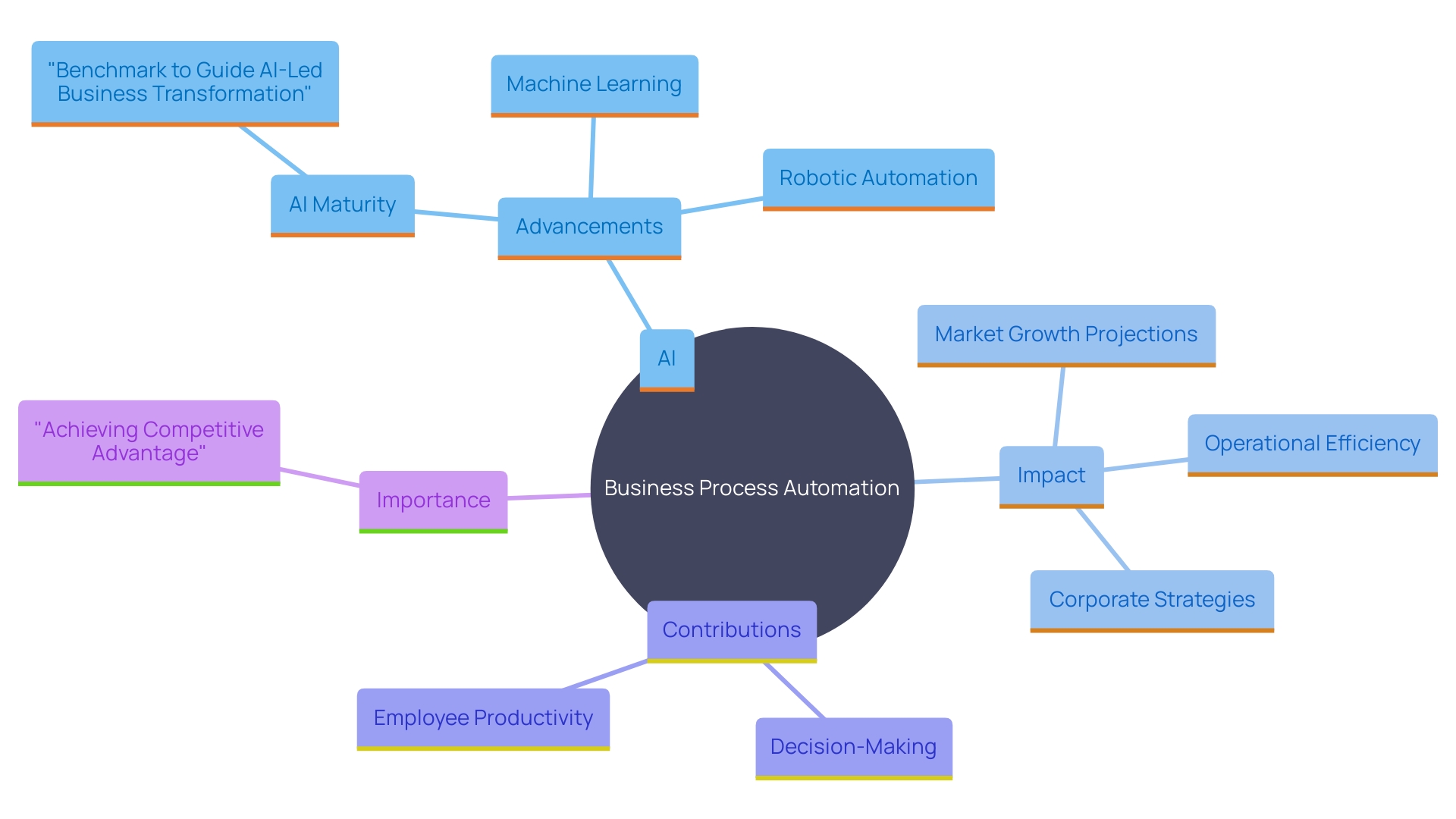
Conclusion
In summary, the integration of Business Process Management (BPM) and Business Process Automation (BPA) represents a strategic imperative for organizations striving for operational excellence. BPM serves as a foundational framework for identifying inefficiencies and aligning processes with broader business goals, while BPA complements this by automating repetitive tasks to enhance productivity and reduce error rates. Together, these methodologies empower organizations to streamline workflows, foster innovation, and ultimately drive growth.
The practical applications of BPM and BPA across various sectors underscore their transformative potential. From automating financial processes to improving patient care in healthcare, the benefits are clear: increased efficiency, reduced operational costs, and improved service delivery. As demonstrated by successful case studies, organizations that embrace these practices not only achieve immediate operational gains but also position themselves for long-term success in an increasingly competitive landscape.
Looking ahead, the future of BPA is bright, bolstered by advancements in technology such as artificial intelligence and machine learning. As businesses navigate digital transformation, the ability to automate complex processes will become essential for maintaining competitive advantage. By prioritizing BPM and BPA, organizations can ensure they remain agile, responsive, and well-equipped to meet the demands of an evolving market.
Embracing these strategies is not merely a choice; it is a necessity for any organization aiming to thrive in today’s dynamic business environment.
Introduction
In an era where efficiency and precision are paramount, software automation has emerged as a pivotal force in transforming business operations. This article delves into the essential concepts of software automation, illustrating how leveraging advanced tools and technologies can streamline repetitive processes, enhance productivity, and reduce human error. It explores various types of automation, including Robotic Process Automation (RPA) and AI-powered test automation, highlighting their roles in optimizing workflows and accelerating software development.
Additionally, the article discusses the profound benefits of automation, such as significant cost savings, improved compliance, and the shift towards more strategic tasks. However, it also addresses the challenges and limitations, such as employee resistance and the risks of over-automation, while providing real-world examples of successful implementation across different sectors. Finally, the article looks forward to the future of software automation, driven by artificial intelligence and machine learning, and how these technologies promise to further revolutionize industries by making processes smarter and more efficient.
Key Concepts of Software Automation
Software mechanization leverages technology to perform activities with minimal human involvement, employing a variety of tools and methods to simplify repetitive processes, improve efficiency, and reduce human error. This technological advancement focuses on refining operational workflows by automating routine activities, allowing teams to concentrate on strategic and value-adding tasks.
Automation offers consistency and accuracy, providing reliable results and eliminating the risk of human error. For instance, Louvre Hotels Group, through collaboration with RobosizeME, significantly enhanced its rate code maintenance process, saving 188 hours per month on rate code headers and 386 hours per month on rate code details. Similarly, Xavo’s advanced AI for lab automation has accelerated scientific discovery by improving sample management, materials, and workflow efficiency.
‘Continuous Integration and Continuous Delivery (CI/CD) solutions such as Jenkins, CircleCI, and GitLab, along with version control systems like Git, are crucial for optimizing the software development lifecycle.’. Configuration management solutions such as Puppet, Chef, and Ansible ensure consistency and reliability, with Ansible’s simplicity and agentless architecture making it particularly effective.
The strategic emphasis on mechanization frees the workforce from repetitive duties, enhancing morale and fostering innovation and development. Companies utilizing AI tools have reported completing tasks 30% faster on average, highlighting the substantial positive impact on development speed and efficiency. Furthermore, the industrial control services market is expected to expand from $147.06 billion in 2019 to $264.69 billion by 2026, highlighting the increasing significance of mechanization in today’s competitive environment.
In conclusion, the trajectory towards workflow automation is not just a trend; it is a strategic move towards smarter, more efficient business practices. Automation is becoming a necessity for organizations navigating the complexities of the modern business environment, ensuring they remain competitive and future-ready.
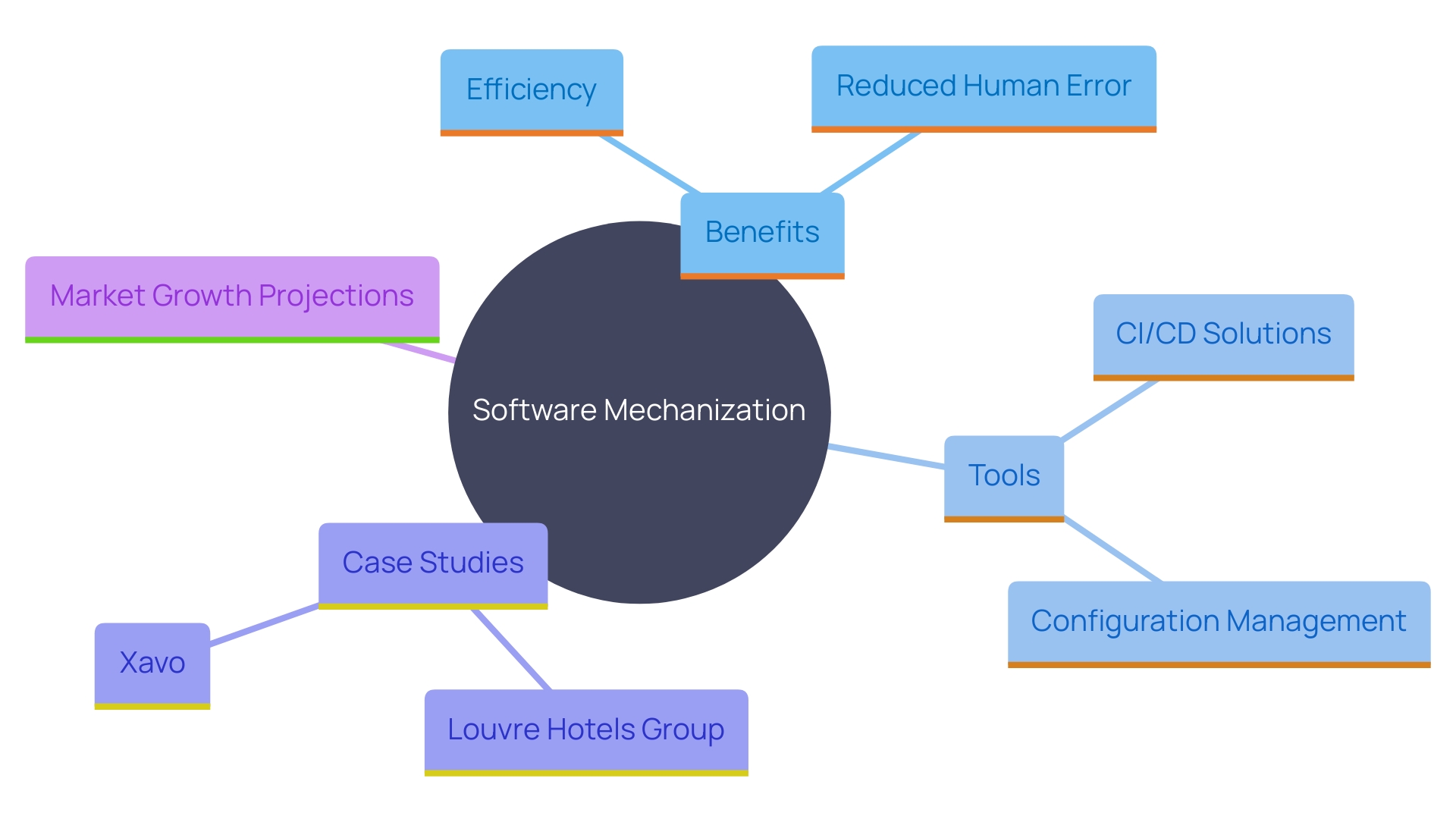
Types of Software Automation
Automation tools have become indispensable in today’s business landscape. Robotic Process Automation (RPA) is a prominent example, deploying software robots to handle rule-based activities across various applications, significantly reducing manual workload. By emulating human actions, RPA bots streamline processes such as data entry and transaction processing, enhancing overall efficiency.
In the realm of software development, test mechanization is crucial. Integrating AI into testing with Natural Language Processing (NLP) ensures that requirements and test cases are thoroughly analyzed, overcoming the limitations of traditional methods. AI-driven solutions automate repetitive tasks such as test execution and result analysis, speeding up the delivery of high-quality software.
Workflow management solutions provide an additional level of effectiveness by handling intricate procedures and approvals effortlessly. No-code platforms, with their user-friendly drag-and-drop interfaces, enable users to develop workflows without prior coding experience, linking to various data sources such as databases and APIs. These tools help companies streamline workflows, make better use of data, and save both time and money.
The adoption of mechanization technologies is a game-changer for businesses aiming to boost productivity and operational efficiency. However, it’s essential to address potential challenges, such as resistance to change and implementation costs, to fully realize the advantages of mechanization.
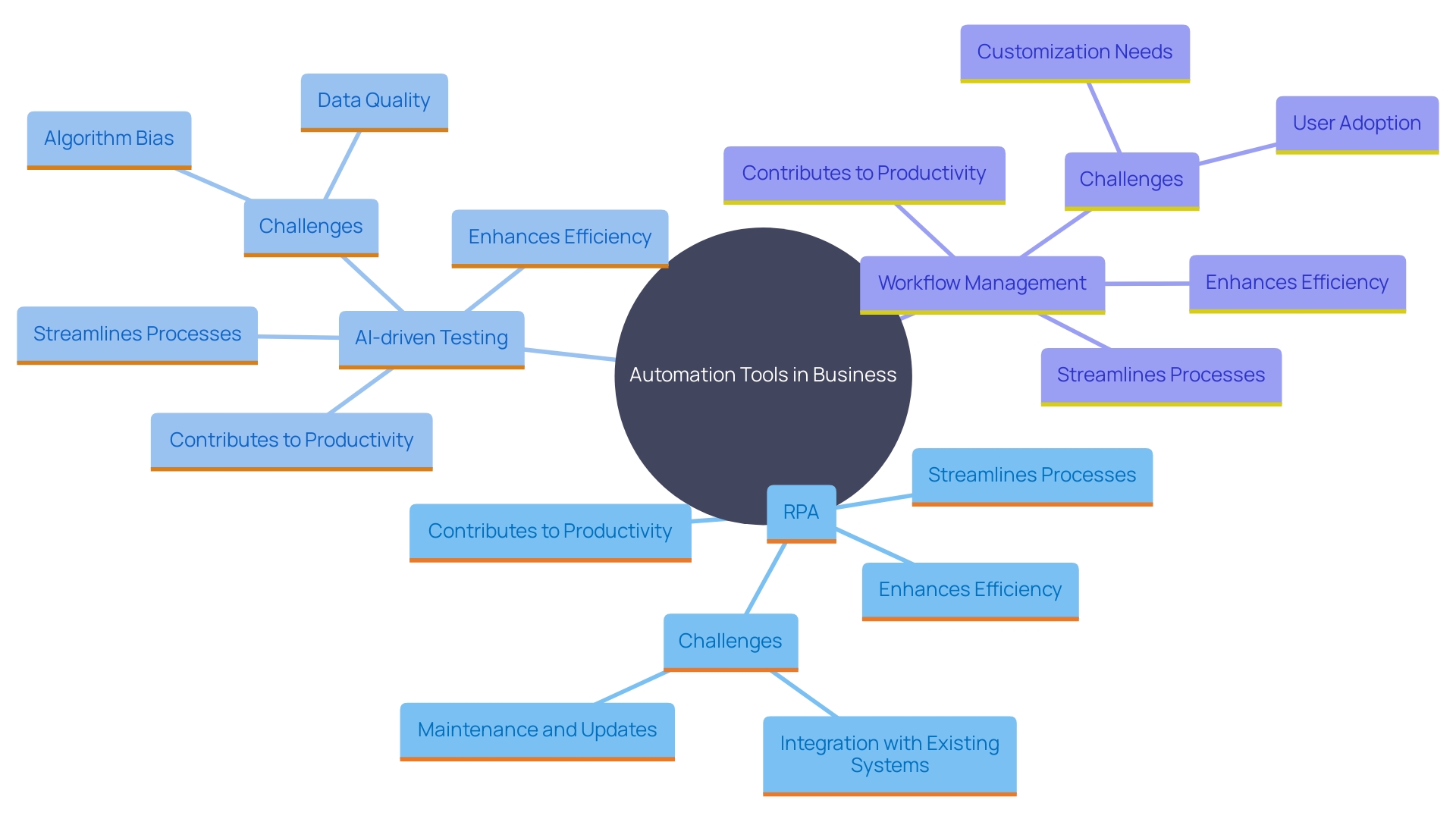
Benefits of Software Automation
The advantages of software mechanization are extensive and transformative across various industries. By automating routine tasks, organizations can significantly enhance productivity, completing tasks faster and with greater accuracy. This shift allows employees to focus on higher-level initiatives that drive innovation and growth, a change that is crucial as 69% of all managerial work is projected to be automated by 2024. The economic benefits are substantial as well. Automation leads to considerable cost savings through streamlined processes and improved resource allocation.
Furthermore, mechanization aids in preserving consistency and adherence throughout processes by reducing human mistakes. A study by Forrester Consulting highlighted that companies adopting AI-augmented testing processes experienced substantial cost savings and return on investment, dispelling the notion that software testing is merely a cost center. Furthermore, automated systems are becoming progressively essential in areas like laboratory processes, where advanced AI innovations are transforming workflows, resulting in quicker and more effective data analysis.
The execution of mechanization technology also addresses concerns about job displacement by emphasizing the importance of upskilling and reskilling initiatives. Embracing education and training helps individuals adapt to new roles, aligning with the changing job market. As mechanization continues to expand, with the market anticipated to increase from $147.06 billion in 2019 to $264.69 billion by 2026, its role in transforming business operations and driving economic growth becomes ever more critical.
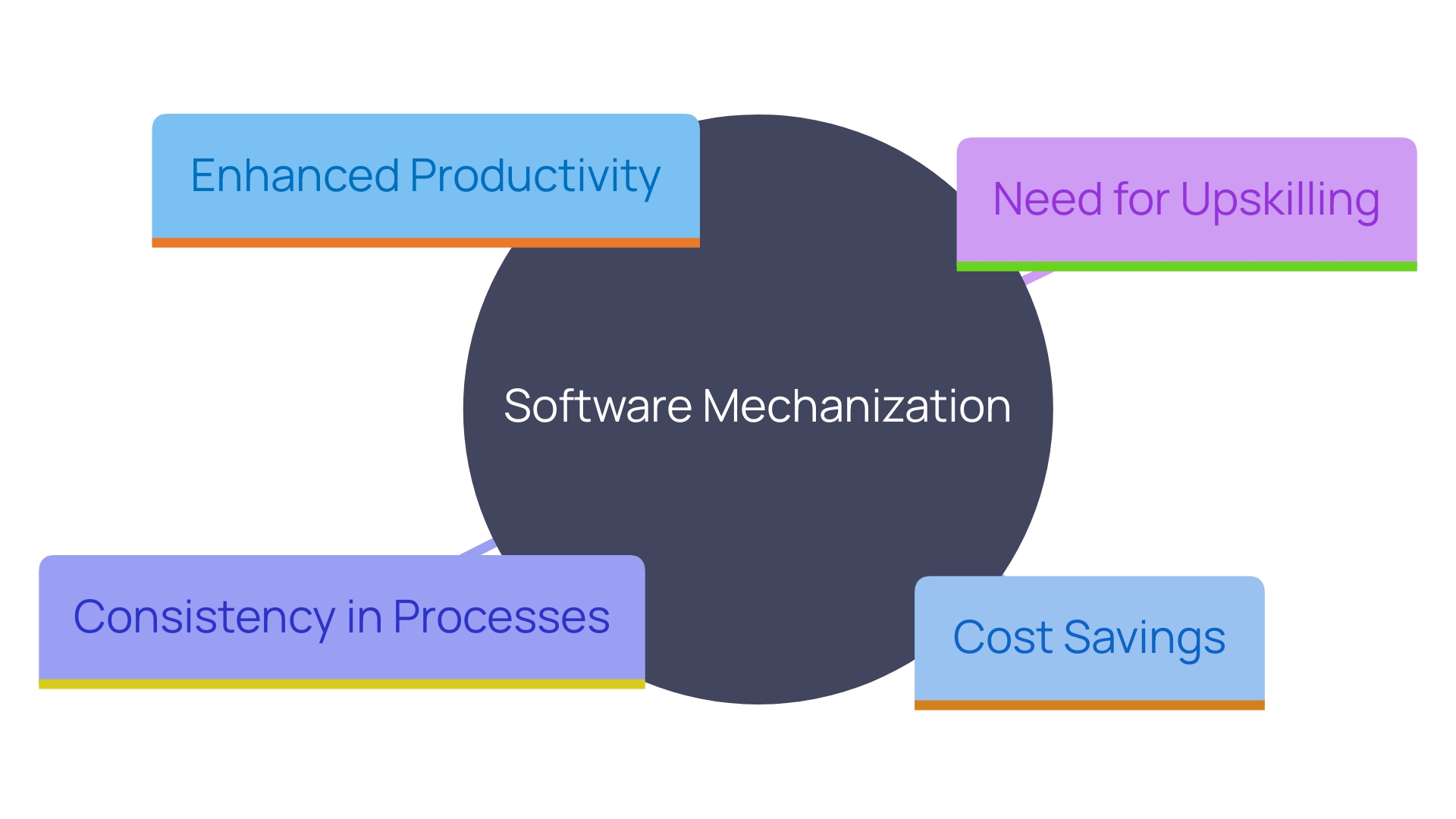
Challenges and Limitations of Software Automation
Despite its advantages, software automation comes with its fair share of challenges. One significant hurdle is employee resistance to change, especially from those accustomed to traditional processes. This resistance isn’t unusual, as the introduction of advanced innovations such as AI and robotics often sparks concerns about job security. However, a recent survey from MIT found that 60% of workers who interact with these technologies foresee positive impacts on their productivity, job satisfaction, and safety.
The initial execution of mechanization instruments also requires a significant commitment of time and resources. This was clear in the situation of the Mass General Brigham hospital system, which needed to hire developers and a process specialist to reorganize their workflow and create efficiency solutions. These instruments ultimately freed front-line finance personnel to engage in more valuable activities, illustrating that the immediate expenses can lead to long-term benefits.
Moreover, there’s the risk of over-automation, where automating too many processes can lead to inflexibility. A balanced approach is essential. Organizations must evaluate which activities truly gain from mechanization while steering clear of the drawbacks of overdependence on technology. Comprehending these constraints and strategically maneuvering through them is essential for the successful incorporation of technological tools.
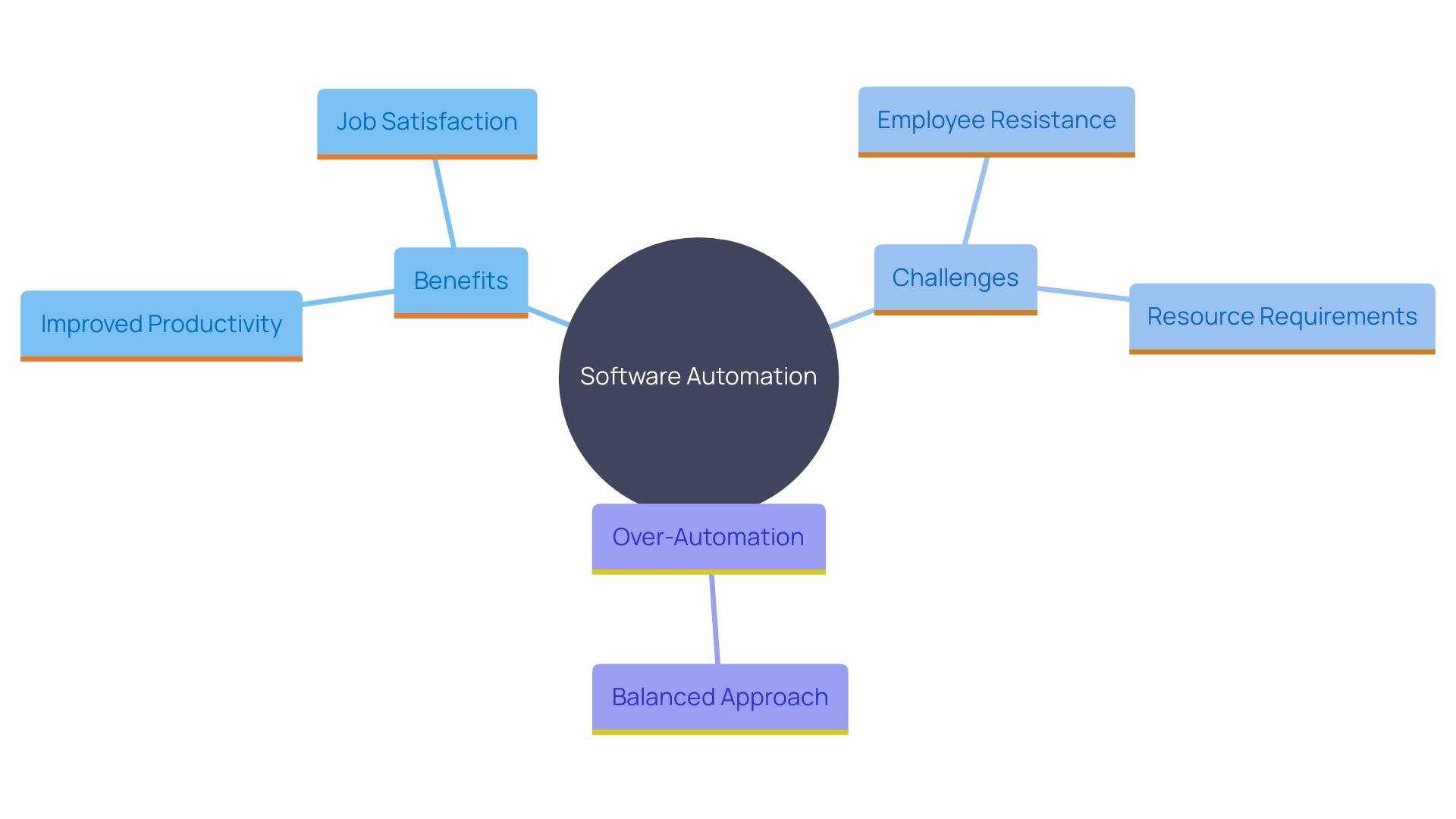
Real-World Applications of Software Automation
Software mechanization is revolutionizing industries by making processes quicker, more intelligent, and increasingly efficient. In the finance sector, for example, M&T Bank has adopted technology to maintain the highest level of security and compliance with stringent regulatory requirements. This transformation allows for efficient handling of sensitive data and transactions, significantly reducing the risk of security breaches and financial losses. In healthcare, the Mass General Brigham hospital system in Boston faced significant bottlenecks in managing provider information. By forming a team focused on automated processes, they created tools that simplified data gathering and structured information, resulting in more efficient workflows and enhanced service delivery. Manufacturing has also experienced considerable advantages from mechanization, with automated controls and monitoring systems enhancing production lines. ‘AI-driven mechanization is changing how work gets done, combining machine learning, natural language processing, computer vision, and robotics to automate tasks traditionally requiring human effort.’. Prompt acceptance of these advancements positions companies to lead in their sectors, fostering innovation and competitive edge.
Future of Software Automation
The future of software innovation is poised for remarkable growth as cutting-edge technologies continue to evolve. Artificial intelligence (AI) and machine learning (ML) are leading this transformation, making automation resources smarter and more adaptable. AI involves intelligent agents that enable computers to carry out activities with human levels of accuracy and intelligence. Key AI concepts relevant to software development include Machine Learning (ML), which uses data to forecast and make decisions, and Deep Learning, which uses deep neural networks to mimic the human brain’s capabilities.
Automation instruments enhanced by these innovations are already addressing intricate tasks with impressive effectiveness. For instance, deep learning algorithms are being used to develop chatbots, facial identification systems, and voice recognition applications. Natural Language Processing (NLP) enables computers to understand, manipulate, and generate natural human languages, making it the primary technology behind digital assistants like Siri and Alexa.
The rapid adoption and constant advancement of AI resources for developers highlight their transformative impact on the industry. According to a worldwide survey of 1,639 professionals and students in the field, nearly half (49%) of leaders believe advanced AI tools will result in efficiency gains or cost reductions, while 20% anticipate enhanced throughput or quicker time to market. This shift is not merely theoretical; AI-driven mechanization is already enhancing efficiency and operational agility in real-time decision-making processes.
As companies aim for improved efficiency, the need for creative mechanization solutions will only increase. The autonomous AI and autonomous agents market is expected to grow significantly, with revenue forecasts extending into billions of dollars. This burgeoning field is reshaping industries by enabling organizations to automate increasingly complex tasks and enhancing their operational capabilities. The future of software automation, driven by AI and ML, is not just promising; it is inevitable.
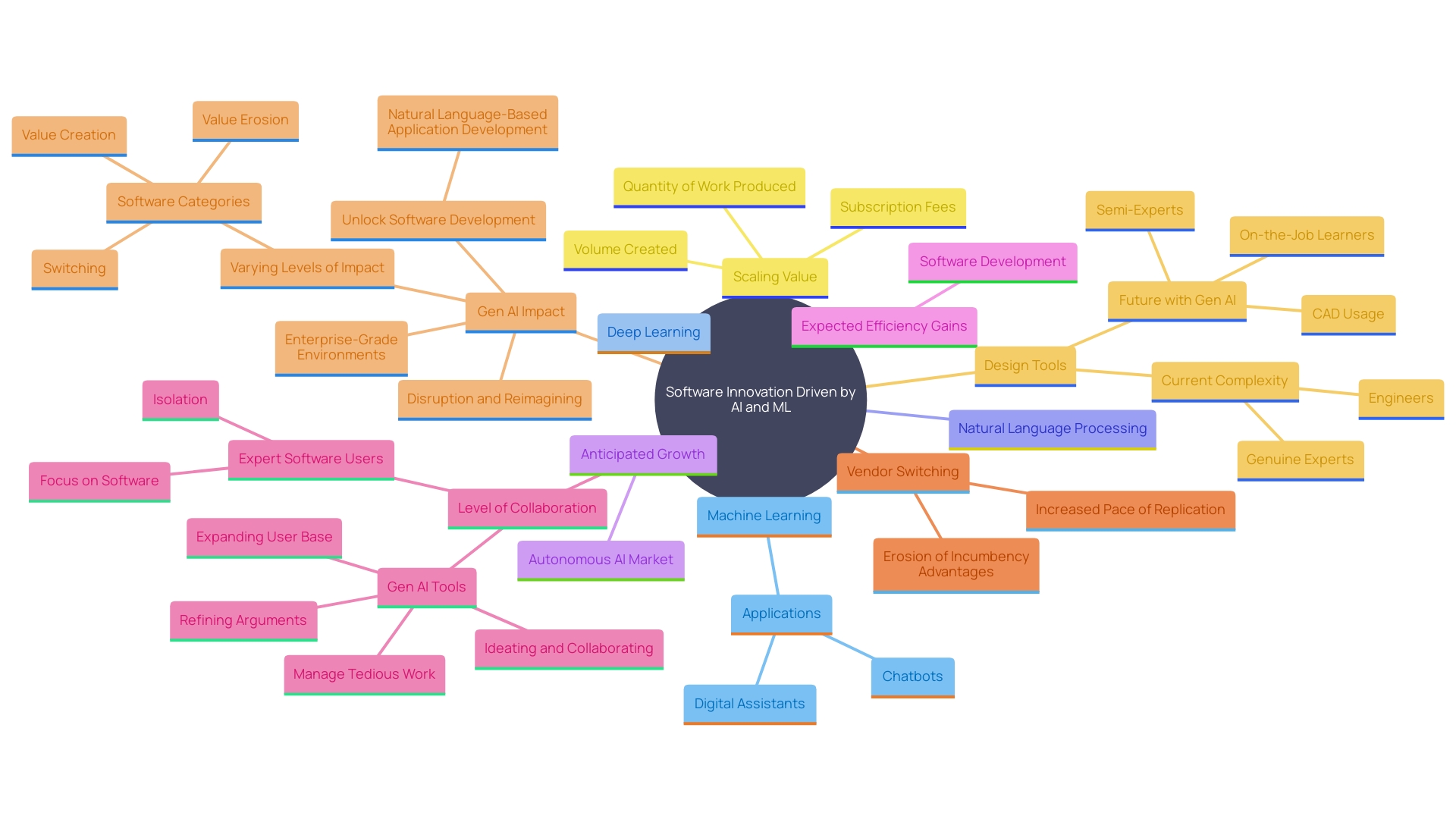
Conclusion
Software automation stands as a cornerstone in the evolution of business operations, offering a multitude of advantages that significantly enhance productivity and efficiency. By streamlining repetitive tasks through tools like Robotic Process Automation and AI-powered test automation, organizations can focus their human resources on strategic initiatives that add value. The evidence is clear: companies leveraging automation report faster task completion and substantial cost savings, illustrating its transformative potential across various sectors.
However, the journey to successful automation is not without challenges. Employee resistance and the initial investment in technology can pose hurdles. Addressing these concerns through effective change management and upskilling initiatives is essential to foster a culture of acceptance and innovation.
A balanced approach to automation, one that avoids over-reliance on technology, ensures that businesses can reap the benefits while maintaining flexibility in their operations.
Looking ahead, the future of software automation is poised for unprecedented growth, driven by advancements in artificial intelligence and machine learning. These technologies will not only enhance existing automation tools but will also enable the tackling of increasingly complex tasks with greater accuracy and efficiency. As organizations continue to embrace these innovations, the potential for enhanced operational capabilities and competitive advantage becomes ever more attainable.
In summary, the strategic implementation of software automation is crucial for organizations aiming to thrive in a rapidly changing business landscape. Emphasizing the importance of addressing challenges and leveraging future technologies will empower businesses to navigate this transformative journey successfully.
Introduction
Robotic Process Automation (RPA) is transforming industries by automating repetitive, rule-based tasks with software robots, or ‘bots.’ These bots interact with various applications to perform functions traditionally handled by humans, such as data entry and transaction processing. The benefits of RPA are substantial, ranging from increased operational efficiency and cost savings to improved accuracy and compliance.
By reducing human error and speeding up workflows, RPA enables businesses to optimize their operations and focus on strategic initiatives.
This article delves into how RPA works, its key benefits across different industries, and the challenges that organizations may encounter during its implementation. It also explores the future of RPA, particularly its integration with Artificial Intelligence (AI) and Intelligent Process Automation (IPA), which promises to automate even more complex tasks and drive further innovation. Discover how RPA can be a game-changer for your organization, offering practical solutions to streamline processes and enhance productivity.
What is Robotic Process Automation?
Robotic Process Automation (RPA) utilizes software robots, or ‘bots,’ to automate repetitive, rule-based activities traditionally managed by humans. These bots engage with different applications and systems in a manner similar to a human, performing activities such as data entry, processing transactions, and managing records.
One of the primary benefits of RPA is the significant increase in operational efficiency it brings. For instance, software bots can carry out repetitive activities at a much faster pace than humans, without the need for breaks or rest. This efficiency was demonstrated by St. James Winery, which achieved higher production speeds and better margins after implementing RPA, measuring their return on investment in terms of labor per case.
RPA also offers substantial cost savings. Companies can lower labor expenses as the software manages activities that would otherwise necessitate extra personnel. Moreover, RPA can work 24/7, eliminating the need for overtime pay or temporary staff during peak seasons. This was the situation for MMCI, a company specializing in material handling and warehouse efficiency, which has leveraged RPA to improve performance and increase productivity.
Improved accuracy is another key advantage of RPA. Human errors can be costly, leading to financial losses and customer dissatisfaction. RPA greatly lowers the likelihood of mistakes in activities like information input and report creation, thereby improving the overall quality of work. ‘According to Aston University, innovations in automation, large information sets, and intelligent systems can enable automated information collection, creating real-time, information-driven dashboards to further enhance accuracy and efficiency.’.
In summary, RPA is designed to enhance efficiency by reducing human error and increasing speed, making it an essential tool for businesses looking to optimize their operations and stay competitive.
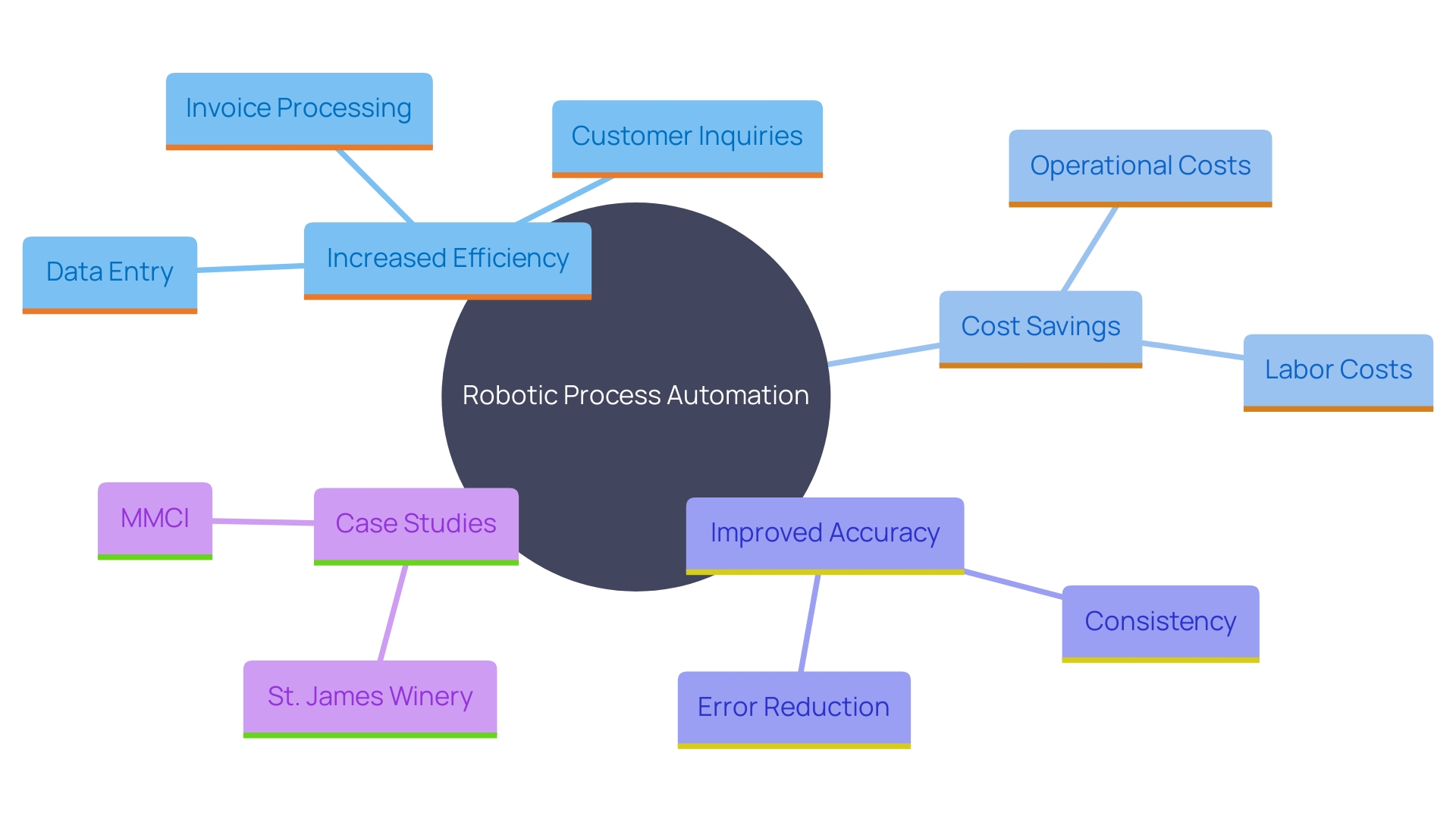
How RPA Works
Robotic Process Automation (RPA) functions by replicating human actions within digital environments. It utilizes a combination of user interface interactions, APIs, and information scraping to execute tasks across various software applications. For example, RPA bots can engage with applications by clicking buttons, entering information, extracting details, and navigating between various systems, much like a human user would.
RPA bots follow predefined workflows or rules, enabling them to manage structured information with high accuracy. This technology is designed to integrate seamlessly with existing systems, eliminating the need for significant changes. Consequently, RPA is highly adaptable and scalable, making it ideal for diverse business environments.
An example of advanced RPA technology is SmartFlow, which utilizes pre-trained large language models (LLMs) and deep-learning-based image understanding. SmartFlow can adjust to new situations, including changes in the user interface and variations in input information, without human intervention. It employs computer vision and natural language processing to understand visible elements on the graphical user interface (GUI) and convert them into textual representations. These representations are then utilized by LLMs to produce a series of actions that a scripting engine carries out to accomplish designated assignments.
The effectiveness of SmartFlow has been demonstrated through evaluations on a dataset of generic enterprise applications with diverse layouts. These evaluations highlight SmartFlow’s robustness across different layouts and applications, showcasing its ability to handle varying scenarios effectively.
Incorporating RPA into business processes offers numerous benefits, such as improved accuracy and efficiency. RPA can operate around the clock, removing the necessity for overtime compensation or temporary personnel during busy periods, and significantly decreasing human mistakes in activities such as data entry and report creation. This increased accuracy not only saves money but also enhances the overall quality of work, positioning RPA as a valuable asset for any organization looking to optimize its operations.

Benefits of Implementing RPA in Business
Implementing Robotic Process Automation (RPA) brings a multitude of benefits, such as enhanced operational efficiency, improved accuracy, and notable cost reductions. By automating repetitive tasks, organizations can reallocate human resources to focus on strategic initiatives and innovative projects. This shift not only fosters growth but also keeps employees engaged in more meaningful work. For instance, St. James Winery, a leading wine producer in St. James, MO, saw higher production speeds and better margins after implementing automated processes, showing tangible ROI in terms of labor per case.
Moreover, RPA’s consistent adherence to established protocols enhances compliance and reporting capabilities. The bots maintain detailed logs of their activities, ensuring that every step follows the required guidelines. As per a study conducted by the Federal Reserve Bank of Atlanta, 54.7% of businesses plan to lower labor expenses via AI in the upcoming year, motivated by the precision and productivity enhancements that mechanization provides. These enhancements also relate to controlled pricing pressures, as mechanization aids in managing input expenses and staff salaries.
In addition, RPA’s role in business processes is not entirely hands-off; continuous monitoring, management, and upgrades are essential. Automation has evolved from early mechanical innovations to sophisticated digital solutions, yet it remains a partnership between technology and human oversight. The incorporation of RPA into high-volume, repetitive processes allows for substantial efficiency gains, while more complex tasks may benefit from Intelligent Automation, which adds cognitive abilities to the integration mix.
In summary, the strategic implementation of RPA can lead to improved operational metrics, cost savings, and enhanced compliance, making it an invaluable tool in modern business operations.

Key Industries Benefiting from RPA
Robotic Process Automation (RPA) is revolutionizing various industries, notably finance, healthcare, manufacturing, and retail. In finance, companies like Capital One utilize RPA to enhance efficiency in processes such as invoice processing and account reconciliation. Capital One’s dedication to digital transformation is clear through its extensive use of Slack for collaboration, affecting over 50,000 employees. In the same way, Market Financial Solutions utilizes marketing technology to simplify operations and boost customer inquiries, emphasizing the wider financial industry’s acceptance of automated processes.
Healthcare is another field greatly gaining from RPA, with 93% of hospitals utilizing workflow processes to handle patient information and scheduling more efficiently. This transition not only improves operational efficiency but also enhances patient care by reducing manual errors.
In manufacturing, RPA is employed for inventory management and quality control. Companies gain granular, real-time visibility into their processes, enabling better decision-making and faster responses to operational challenges. This visibility is crucial for maintaining high standards in production and ensuring timely fulfillment of orders.
Retail businesses are also leveraging RPA to streamline order processing and enhance customer service interactions. Automated systems can handle customer inquiries and process orders more efficiently, freeing up staff to focus on more strategic tasks. For instance, automated tools can recognize trends and suggest solutions, enabling teams to dedicate more time to customer engagement and less on manual data entry.
By continuously observing and recording outcomes, organizations can enhance their strategies, ensuring ongoing advancements in efficiency and productivity across all sectors.
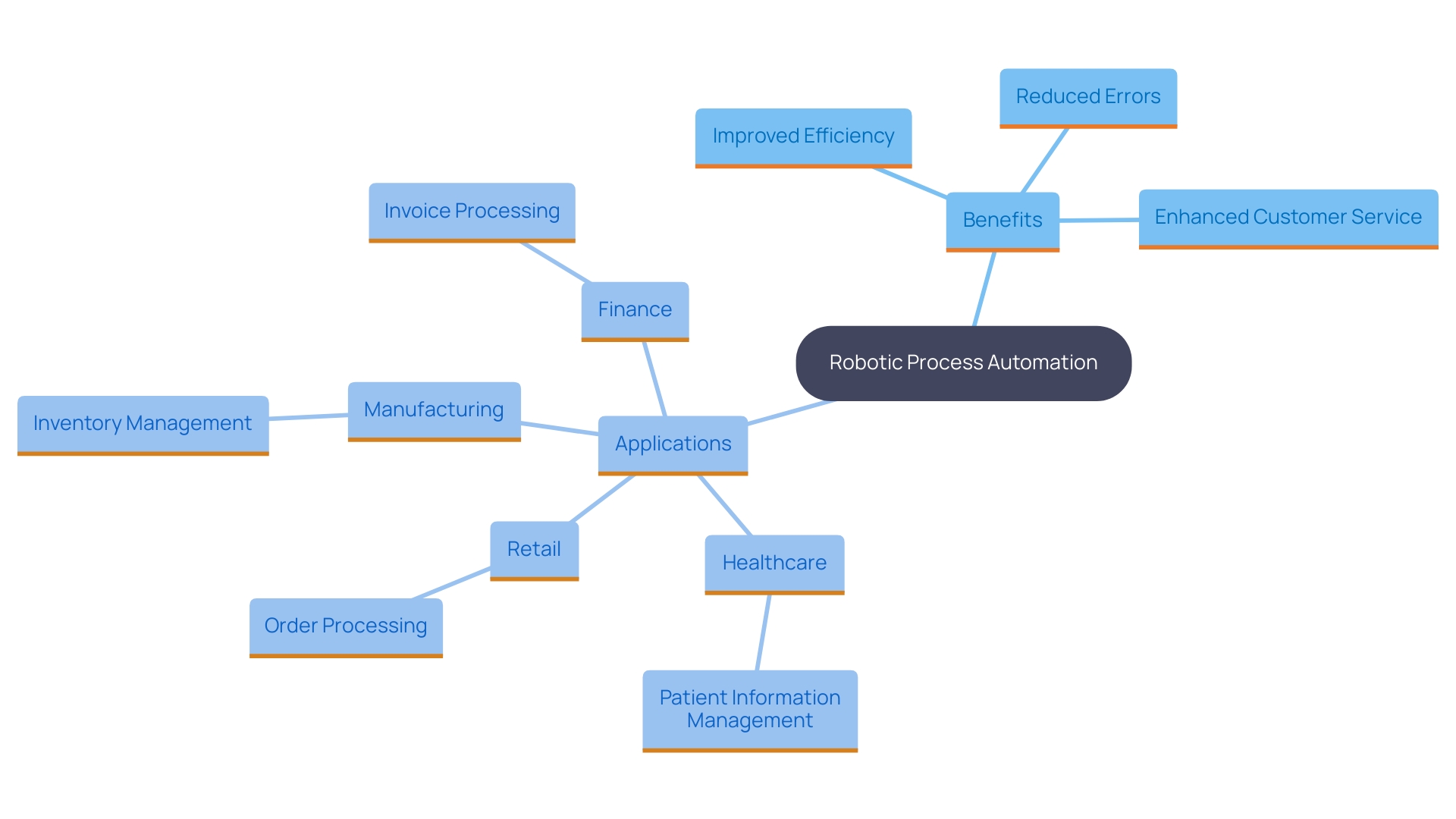
Challenges and Considerations for RPA Adoption
While RPA offers substantial advantages, organizations may face challenges during its adoption. Common obstacles include resistance from employees, inadequate training, and the need for robust change management strategies. For example, the RESEA program in California found that about a third of participants did not attend the initial session despite the program’s clear benefits. This highlights the importance of addressing mental models and friction points that hinder acceptance.
To overcome these hurdles, businesses should focus on upskilling their workforce to complement new technological systems. According to a Deloitte survey, 90% of executives are placing more importance on training, with more than half focusing on skills-based hiring in 2024. Companies like Nets have successfully transitioned from traditional face-to-face training to more flexible and timely approaches, ensuring employees are well-prepared for new responsibilities.
Moreover, continuous improvement is key. Hyperautomation, which combines RPA with AI, should be seen as a journey rather than a one-time project. Regularly monitoring and refining processes can maximize benefits and keep the workforce engaged.
Investing in the right tools and fostering a culture of acceptance are also crucial. For instance, the rapid deployment of an RPA bot by HUD to automate housing contract monitoring showcased how quickly and efficiently RPA solutions can be implemented, even within complex procurement and regulatory environments. This not only improved operational resilience but also set a precedent for future technology adoption.
By addressing these challenges head-on and providing the necessary resources and support, businesses can ensure the successful implementation of RPA and unlock its full potential.
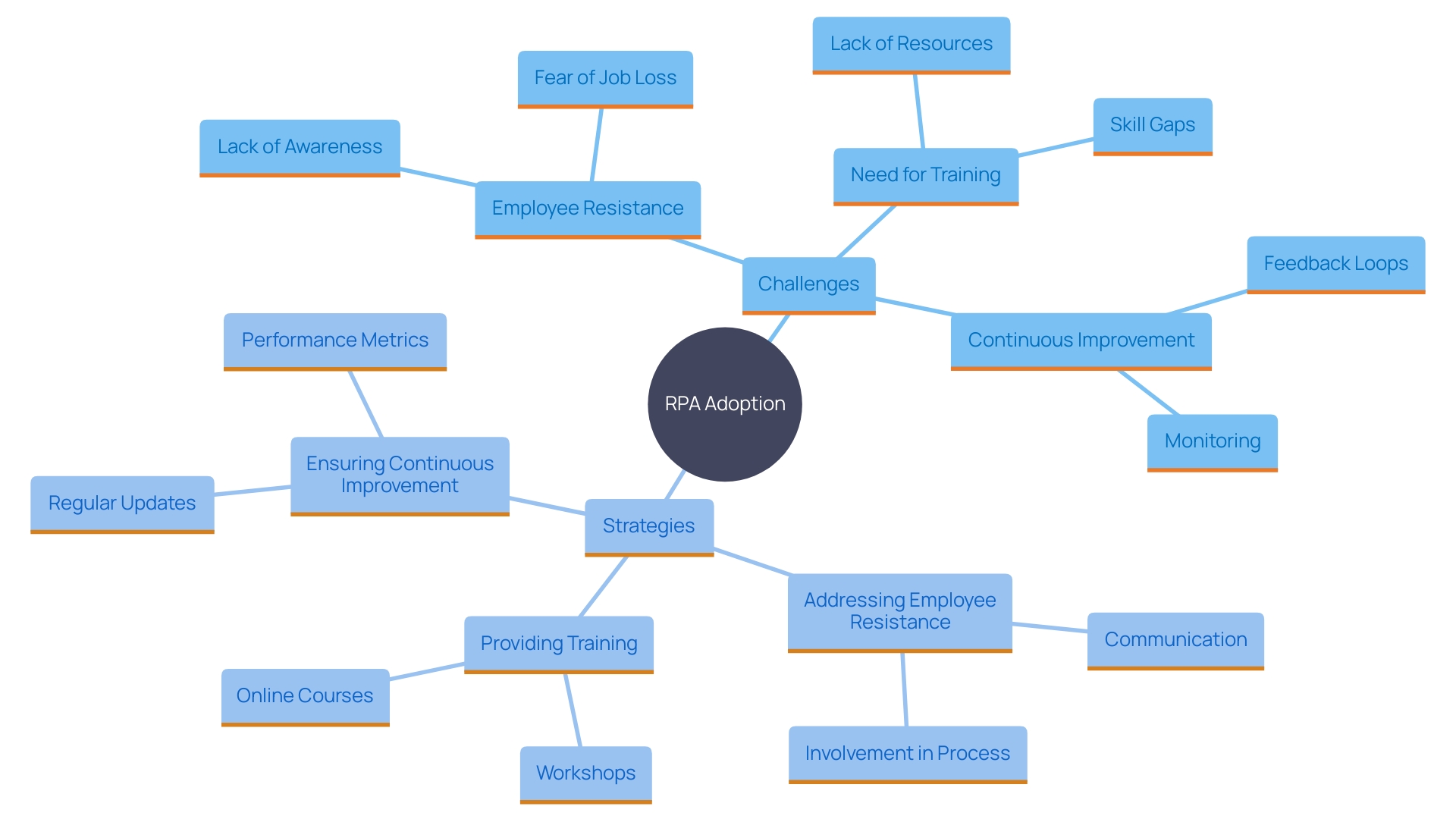
The Future of RPA: Integration with AI and IPA
The future of RPA lies in its integration with Artificial Intelligence (AI) and Intelligent Process Automation (IPA). This evolution will enable organizations to automate more complex activities that require cognitive abilities, such as decision-making and problem-solving. By combining RPA with AI, businesses can unlock greater insights from their information, enhance automation capabilities, and drive innovation in their operations.
Picture a group of AI workers collaborating to perform requests made by users, utilizing personalized information and engaging with the most essential applications. To realize this vision, Lindy required to incorporate a large network of applications and services to allow their AI assistants to carry out functions efficiently. The complexity and breadth of these integrations presented a significant challenge. Developing them from scratch would require extensive research, planning, and development time, and threatened to extend the timeline to a full year. This would have significantly delayed Lindy’s market entry or reduced its range of available activities at launch. Lindy chose n8n to overcome this challenge.
Fast-forward to today, and the meshing of RPA with AI technology—hyperautomation, or the marriage of multiple automation capabilities—has opened a whole new world of automation. Much of the pre-AI trouble with RPA comes down to the complexity or variability of seemingly simple activities. For example, say you want a bot to analyze invoices and send them to the right contacts at your organization. Seems simple enough, right? Think again. Before the bot can manage the job, you’d need to standardize every invoice, or you’d have to program the bot to know how to handle dozens of different document variations.
In this context, we present SmartFlow, an AI-based RPA system that uses pre-trained large language models (LLMs) coupled with deep-learning based image understanding. Our system can adapt to new scenarios, including changes in the user interface and variations in input data, without the need for human intervention. SmartFlow uses computer vision and natural language processing to perceive visible elements on the graphical user interface (GUI) and convert them into a textual representation. This information is then utilized by LLMs to generate a sequence of actions that are executed by a scripting engine to complete an assigned objective. Our evaluations on this dataset demonstrate that SmartFlow exhibits robustness across different layouts and applications.
The choice between the two depends on the specific requirements of an organization, balancing the need for efficiency in routine tasks with the demand for adaptability and cognitive capabilities. In this journey, the integration of advanced technologies and the guidance of experienced consultants is paramount. Entities that adopt a comprehensive perspective, merging the advantages of RPA and IA, prepare themselves for achievement in the constantly changing environment of technology. A thoughtful approach, guided by a seasoned cloud and leveraging the benefits of cloud and DevOps services in USA, ensures not only efficiency in automation but also optimal performance aligned with business objectives. Navigating the Future with Cutting-Edge Automation As we delve into the intricate realm of Robotic Process Automation (RPA) and Intelligent Automation (IA), it’s evident that the technological landscape is rapidly evolving.
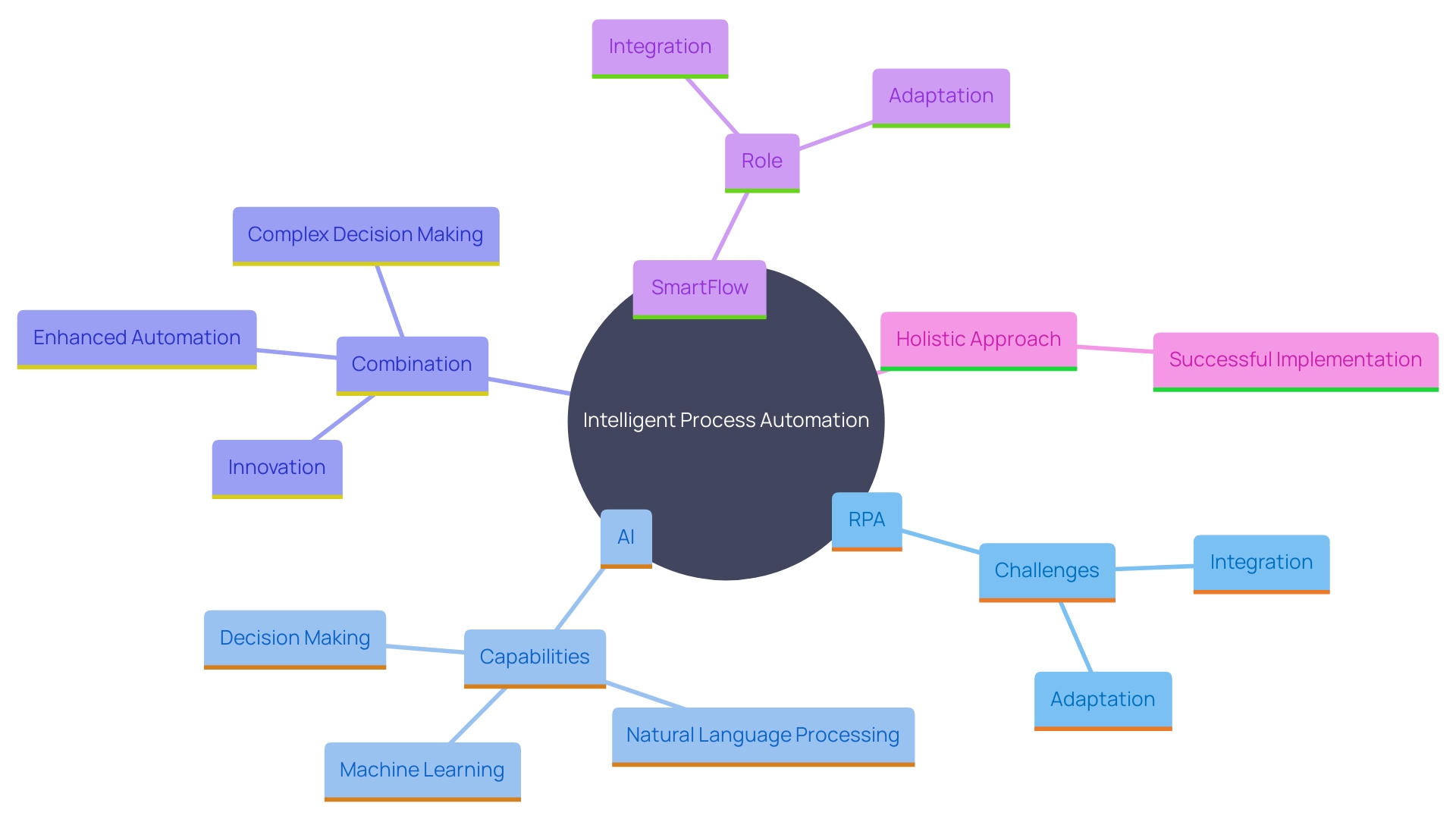
Conclusion
The transformative power of Robotic Process Automation (RPA) is evident across various industries, delivering substantial benefits such as increased operational efficiency, cost savings, and improved accuracy. By automating repetitive tasks, organizations can redirect human resources to more strategic initiatives, fostering innovation and enhancing employee engagement. The case studies of companies like St. James Winery and Capital One illustrate the tangible returns on investment achieved through RPA adoption, showcasing its potential to streamline processes and enhance productivity.
However, successful implementation of RPA is not without challenges. Resistance from employees, inadequate training, and the need for robust change management strategies can impede progress. Addressing these hurdles through upskilling, continuous monitoring, and fostering a culture of acceptance is essential.
Companies that invest in the right tools and provide adequate support can unlock the full potential of RPA, ensuring sustained improvements in efficiency and operational resilience.
Looking ahead, the future of RPA lies in its integration with Artificial Intelligence (AI) and Intelligent Process Automation (IPA). This evolution will enable organizations to tackle more complex tasks that require cognitive abilities, ultimately driving deeper insights and innovation. By embracing a holistic approach that combines RPA with advanced technologies, businesses position themselves for success in an ever-evolving landscape.
Organizations that prioritize thoughtful integration and strategic guidance can navigate the future of automation effectively, ensuring alignment with their broader business objectives.
Introduction
Navigating the complexities of the procure-to-pay (P2P) process is crucial for any organization aiming to enhance operational efficiency and maintain strong supplier relationships. This comprehensive overview delves into the intricacies of the P2P cycle, starting from the initial identification of needs to the final payment execution. Understanding each phase of this process can lead to significant improvements in cash flow management, error reduction, and transparency.
The article also explores the transformative power of automation in the P2P process. By adopting advanced technologies such as artificial intelligence and machine learning, businesses can optimize workflows, reduce manual errors, and gain valuable insights for strategic decision-making. Real-world case studies underscore the tangible benefits of automation, showcasing how it can lead to higher production speeds, better margins, and enhanced compliance with financial regulations.
Moreover, the article provides practical steps for selecting and implementing the right P2P automation software, ensuring seamless integration with existing systems. It highlights best practices and addresses common challenges, offering solutions to overcome resistance, integration issues, and data quality concerns. As the procurement landscape continues to evolve, staying ahead with strategic automation and continuous improvement will be key to maintaining a competitive edge and achieving operational excellence.
Understanding the Procure-to-Pay Process
The procure-to-pay (P2P) procedure encompasses the entire cycle of acquiring goods and services, starting from identifying needs to making payments. ‘This procedure is vital for organizations as it directly influences cash flow, supplier relationships, and overall operational efficiency.’. Comprehending each stage of the P2P workflow allows companies to optimize activities, minimize mistakes, and improve clarity.
‘Purchase requisitions, usually created by staff or divisions, signify the initial step in the P2P cycle.’. These requisitions go through an approval process to ensure alignment with the company’s budget and purchasing policies. Following approval, a Request for Quotation (RFQ) is issued to potential suppliers to gather information on pricing, terms, and other relevant details. Suppliers then review the RFQ and submit their quotations, which are evaluated based on price, quality, delivery time, and supplier reliability.
‘The digital transformation of businesses is driving the need for real-time solutions and advanced business intelligence in purchasing activities.’. As mentioned by Technavio, contemporary companies need effective and precise acquisition methods to achieve a competitive advantage. Incorporating artificial intelligence (AI) into purchasing software can further optimize workflows and offer valuable insights, such as virtual agents, chatbots, pattern recognition, and automatic scheduling.
Case studies highlight the tangible benefits of automation in the P2P process. For instance, St. James Winery achieved higher production speeds and better margins by automating parts of their operations. This move not only improved their ROI in terms of labor per case but also positioned them to meet increasing demands efficiently.
However, challenges persist in achieving seamless integration of purchasing solutions. Compatibility issues, particularly with outdated systems, can hinder the growth of the global purchasing software market. Supplier integration is also problematic, as some may lack the resources or knowledge to integrate with new software, leading to delays and significant problems for organizations.
Despite these challenges, the strategic development of purchasing is evident. The function of acquiring goods is shifting from a purely cost-reduction focus to a more strategic entity driving enterprise-wide value. This transformation demands updated methodologies and strategies to deliver sustainable business value.
In conclusion, the P2P system, when effectively managed and automated, offers significant advantages. By utilizing advanced technologies and addressing integration challenges, companies can improve their purchasing efficiency, supplier relationships, and overall operational performance.
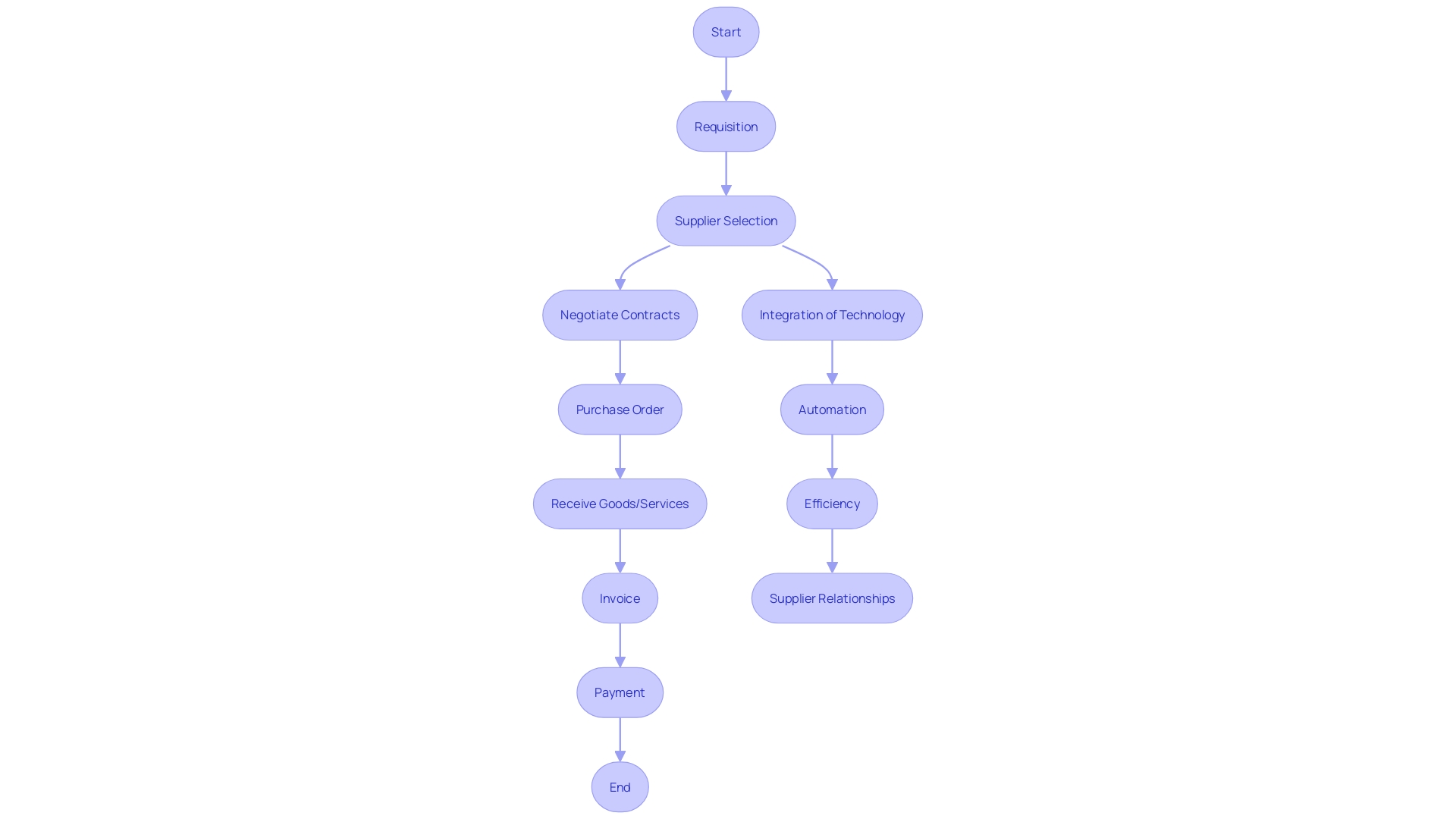
Benefits of Procure-to-Pay Automation
‘Automating the procure-to-pay workflow is a transformative measure for companies aiming to improve efficiency and productivity.’. By implementing automated workflows, businesses can significantly reduce manual errors and achieve faster processing times. This optimization not only ensures better compliance with financial regulations but also provides enhanced visibility into spending patterns.
Incorporating AI and machine learning into procurement processes can offer a competitive edge. These technologies enable organizations to leverage data analytics for informed decision-making, driving strategic value creation. As mentioned in industry reports, complete mechanization of accounts payable can stimulate business growth, enhance financial management, and result in substantial cost savings.
“Amy Raymond, Senior Vice President of Revenue Cycle Operations and Deployments at AKASA, emphasizes that ‘mechanization is no longer simply an option in the revenue cycle — it is an imperative.’ This sentiment is echoed across various sectors, where mechanization frees up staff from routine tasks, allowing them to focus on more strategic initiatives.”.
Additionally, automation in purchasing allows entities to rethink comprehensive processes, capturing full value by utilizing advanced technologies. As companies invest in developing AI-powered purchasing abilities, they set themselves up to attain enhanced efficiency and creativity. The future of acquiring goods is intelligent, data-driven, and transformative, with businesses that embrace these changes leading the way.

Key Steps in the Procure-to-Pay Process
-
Needs Identification and Requisitioning: The process begins with identifying the specific requirements of the entity. Employees or departments create purchase requisitions detailing the needed goods or services. These requisitions undergo an approval workflow to ensure alignment with the company’s budget and procurement policies.
-
Supplier Selection and Purchase Order Creation: Once requisitions are approved, the next step is evaluating potential suppliers. A Request for Quotation (RFQ) is issued to gather pricing, terms, and other relevant details. Suppliers submit their quotations, which are evaluated based on factors such as price, quality, and delivery time. The group then chooses the supplier providing the most advantageous conditions and creates purchase orders.
-
Goods Receipt and Verification: Upon delivery, goods or services are received and verified to ensure they meet the specified quality standards. This step is crucial in maintaining product quality and delivery performance, as evidenced by a major public sector entity that improved its product quality and delivery performance significantly.
-
Invoice Processing and Verification: Invoices received from suppliers are matched with the respective purchase orders and goods receipts for accuracy. This method ensures that the organization only pays for what was ordered and received, enhancing financial accuracy and accountability.
-
Payment Authorization and Execution: Verified invoices are then processed for payment. This step includes authorizing payments and maintaining detailed records for future audits. Automation solutions, like those offered by firms such as Basware and Coupa, simplify this task, lowering expenses and enhancing efficiency. ‘The digital transformation within procurement activities is driving the need for real-time solutions and advanced business intelligence, making this step more efficient and accurate.’.
How to Automate Your Procure-to-Pay Process
To streamline your procure-to-pay (P2P) workflow efficiently, start by choosing the appropriate tools designed for your organizational requirements. Implement a robust software solution that integrates seamlessly with your existing systems. Define your workflow meticulously to ensure every step, from requisition to payment, is automated.
Take the example of Mass General Brigham hospital system in Boston. In 2018, they faced significant inefficiencies in tracking healthcare providers. By forming a dedicated automation team and reorganizing their workflow, they developed a tool that automatically gathered and arranged provider data, drastically enhancing their system.
Training your team on the new system is crucial, as is establishing clear protocols for handling exceptions. Regularly review and refine the process for continuous improvement. As contemporary purchasing divisions have demonstrated, adopting these technologies can result in advantages such as decreased expenses, enhanced efficiencies, minimized risk, and better adherence. According to Technavio, the procurement software market is expected to grow by 10.77% annually over the next four years, reaching an additional value of $5.72 billion.
These tools not only streamline processes but also provide real-time spend analysis and reporting, which is invaluable for optimizing business spending. However, be prepared for potential challenges during initial setup and integration. Surmounting these obstacles can result in considerable competitive benefits, as illustrated by firms such as St. James Winery, which experienced greater margins and enhanced efficiency by utilizing technology.
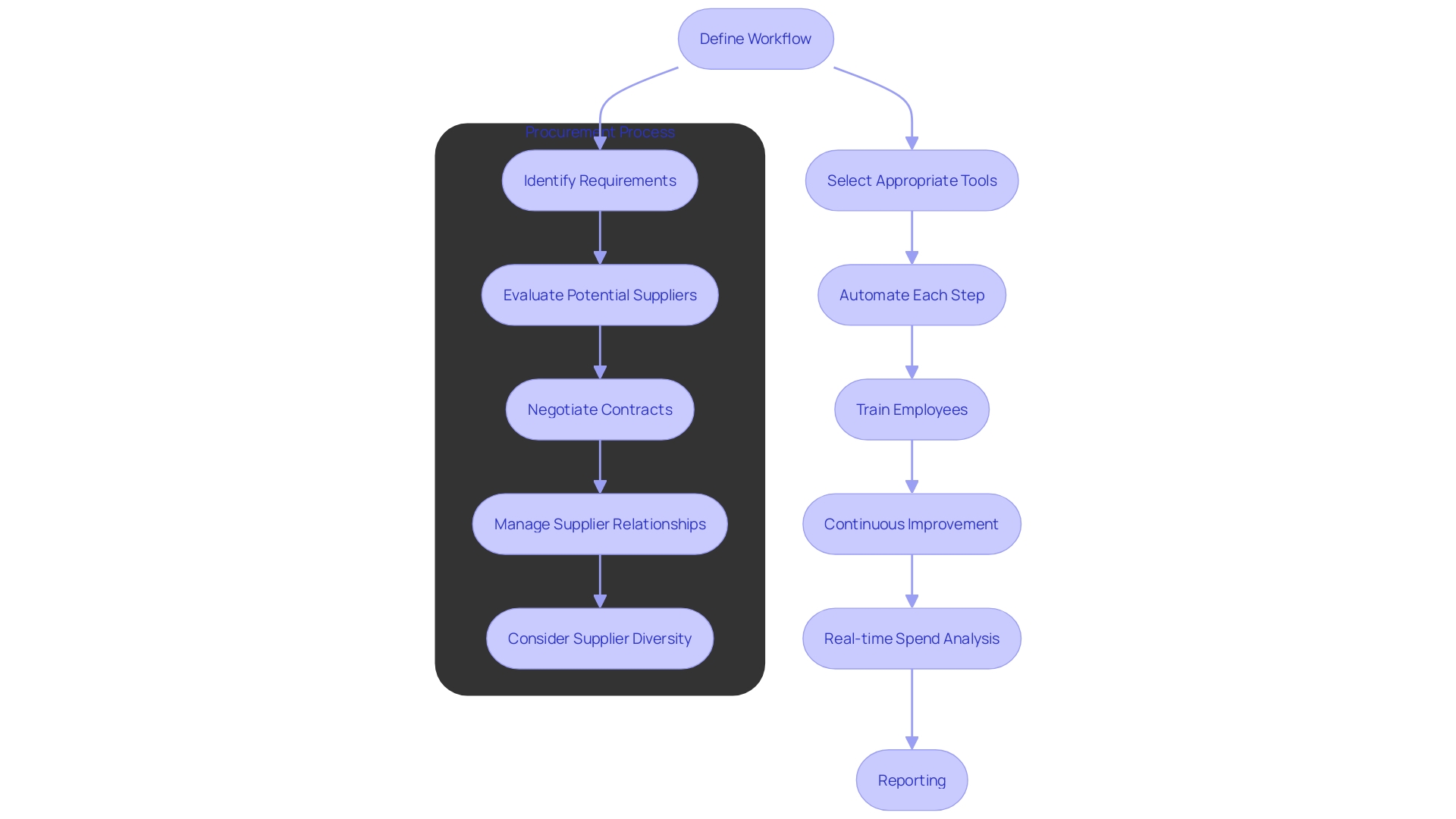
Choosing the Right Procure-to-Pay Automation Software
When selecting P2P automation software, it’s crucial to evaluate several key factors to ensure the solution aligns with your organization’s needs. Scalability is essential for growing businesses, while user-friendliness ensures ease of adoption and reduces training time. Integration capabilities with existing systems, such as accounting software, HRIS, and payment applications, are vital for seamless operations. ‘Vendor assistance and adaptability in payment conditions also play an important part, as emphasized by a recent study indicating that 22% of participants prioritize flexible payment conditions and 20% appreciate streamlined procedures.’.
Look for features like automated invoice matching, real-time reporting, and compliance management to enhance your workflows. For instance, Hyatt Hotels Corporation enhanced its procurement function by choosing BirchStreet Systems, which provided comprehensive solutions tailored to the hospitality industry. This move enabled Hyatt to improve spend visibility, control, and compliance, demonstrating the impact of well-chosen software.
Additionally, conducting demos and gathering feedback from end-users can provide valuable insights into the software’s practical application and effectiveness. Practical instances, like Hyatt’s effective execution, further highlight the significance of comprehensive assessment and user participation in the selection procedure.
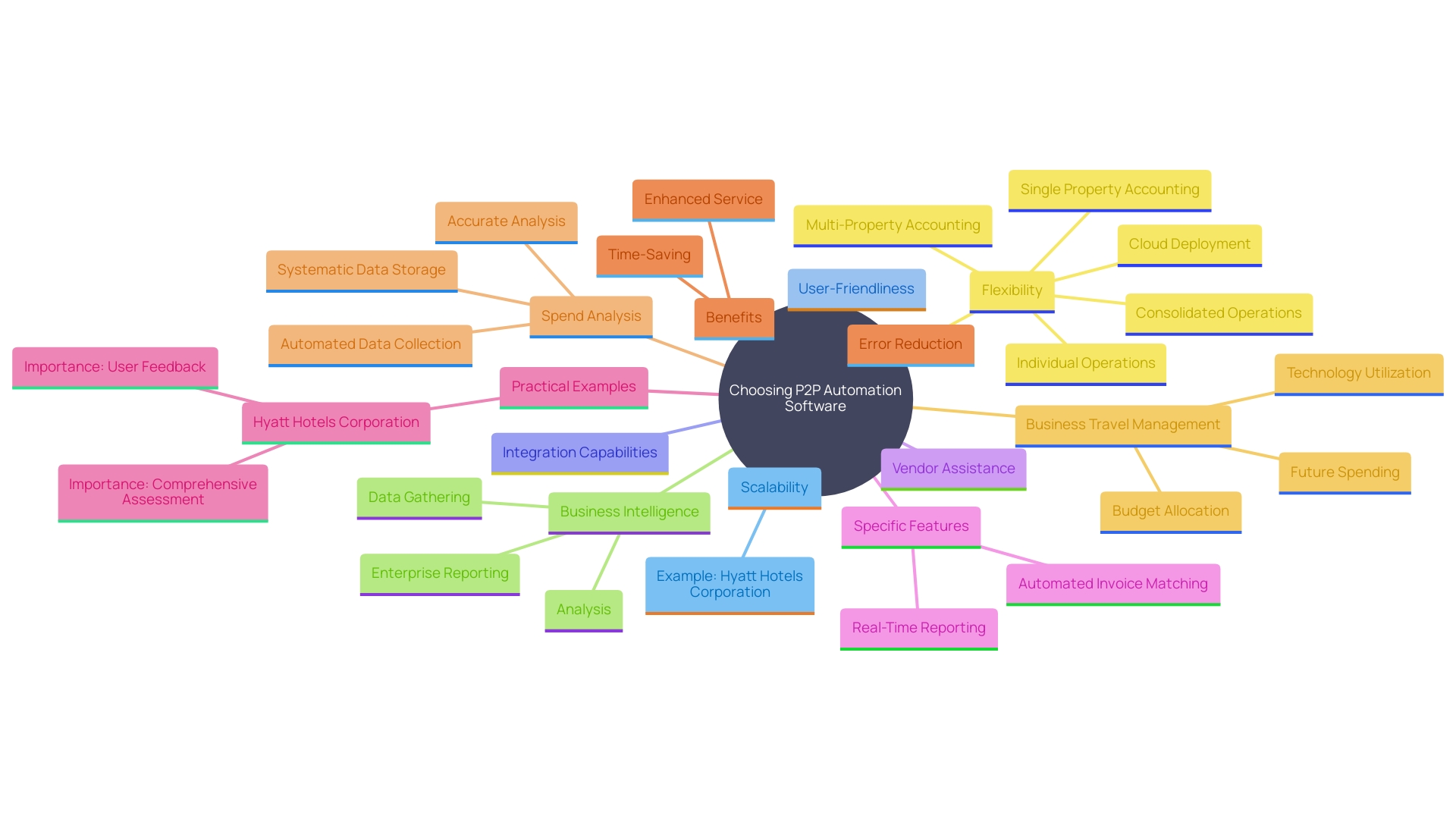
Implementing Procure-to-Pay Automation
Effective execution of P2P systemization requires a well-organized plan, starting with a pilot initiative to evaluate the systemization process in a regulated setting. This approach allows for gathering feedback and making necessary adjustments before a full-scale rollout. A notable example of this is the approach taken by Delivery Hero, a global delivery platform operating in over 70 countries. To address the challenge of employees getting locked out of their accounts, the IT service delivery team led by Dennis Zahrt implemented an automated solution. This pilot program reduced the average recovery time from 35 minutes to a mere few minutes, saving around 200 hours monthly.
Involving stakeholders from the outset is crucial in minimizing resistance to change. This guarantees that the advantages of mechanization are conveyed efficiently. As emphasized by specialists from Optum, a leader in revenue cycle management, mechanization can significantly reduce costs and improve overall operational efficiency. Moreover, the experience of companies more advanced in their technological journey shows a competitive edge, with potential net savings of 13 to 25 percent in administrative expenses and 5 to 11 percent in healthcare costs.
By adhering to these steps and learning from successful case studies, organizations can harness the full potential of P2P automation to redefine their operational methods and achieve substantial efficiency gains.
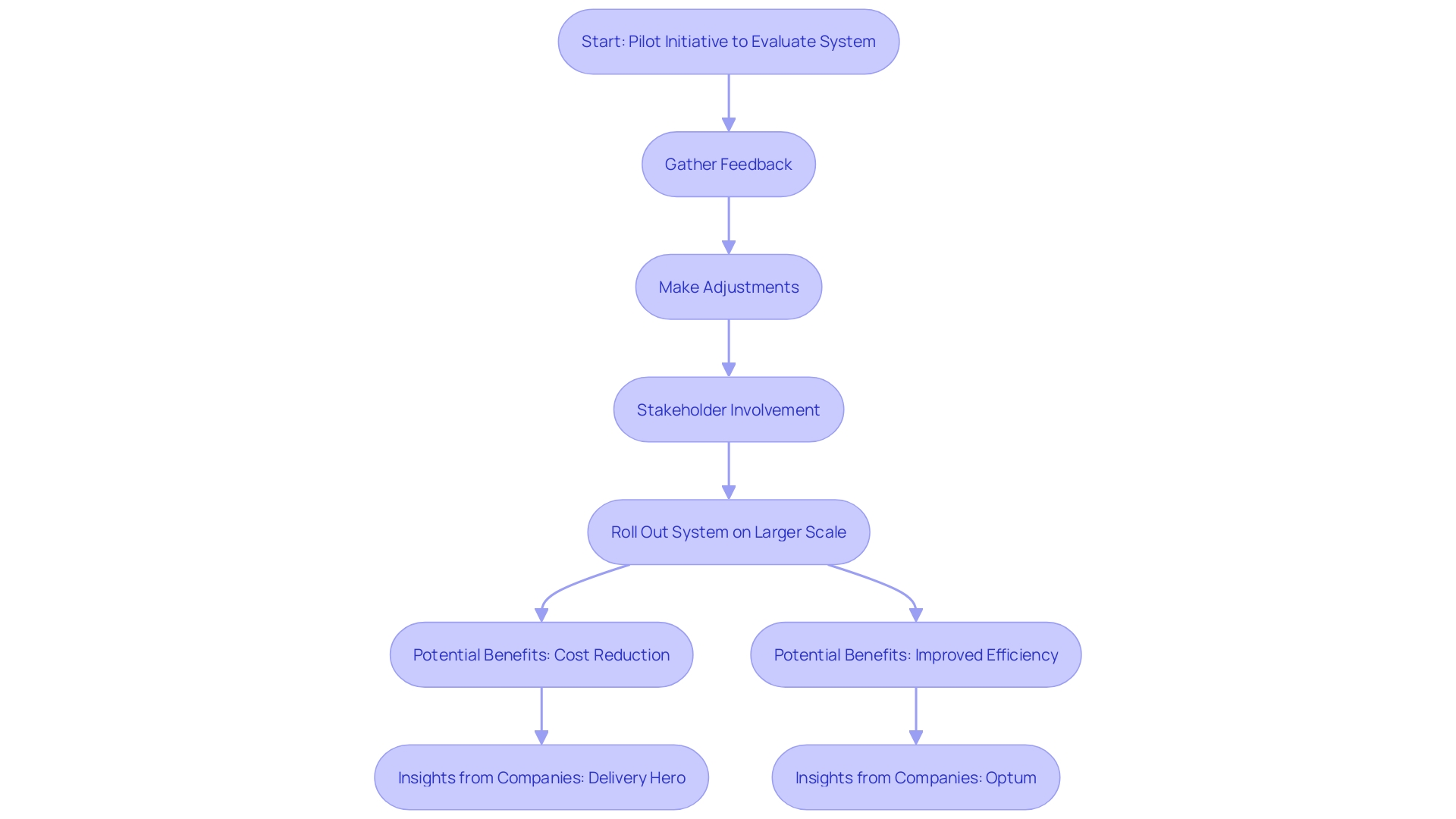
Best Practices for Procure-to-Pay Automation
‘Implementing best practices for automating healthcare and financial systems involves several key steps.’. First, establish clear policies and procedures to direct the automated system, ensuring consistency and reliability. Maintain regular and open communication with suppliers about expectations and any changes to avoid misunderstandings and disruptions.
To maximize system effectiveness, provide ongoing training and support for employees. This will help them adapt to new technologies and workflows, ultimately improving overall efficiency.
Leverage tools like dashboards, inventory trackers, and alerting systems to enhance process efficiency. For instance, dashboards can consolidate data from multiple sources, allowing managers to interpret and act on insights effectively. Alerts can notify managers of any issues that need immediate attention, ensuring prompt action.
Consistently examine data to recognize patterns, inefficiencies, and chances for additional mechanization. This examination is essential for ongoing enhancement and can uncover areas where further mechanization can lead to substantial benefits.
Incorporating robust APIs and ensuring seamless integration with existing systems can further enhance the utility of automated solutions. Companies like Basware and Coupa lead the market in providing such integrated solutions, which help streamline operations and improve data accuracy.
Alongside these technical elements, creating a robust business case is vital for obtaining funding in technological advancements. This involves quantifying potential cost savings, increased efficiency, and improved supplier relationships. Highlighting quick wins and demonstrating the platform’s value can make a compelling case for stakeholders.
Change management is another critical component. Implement a comprehensive strategy that includes clear communication, training, and ongoing support to address concerns and highlight the benefits of the new system. Effective change management can significantly reduce resistance and ensure smoother transitions.
The procurement software market is expected to grow by $5.72 billion over the next four years, driven by the need for real-time solutions and advanced business intelligence. As companies increasingly adopt these technologies, staying ahead with best practices and strategic implementations will be key to maintaining a competitive edge and achieving operational excellence.
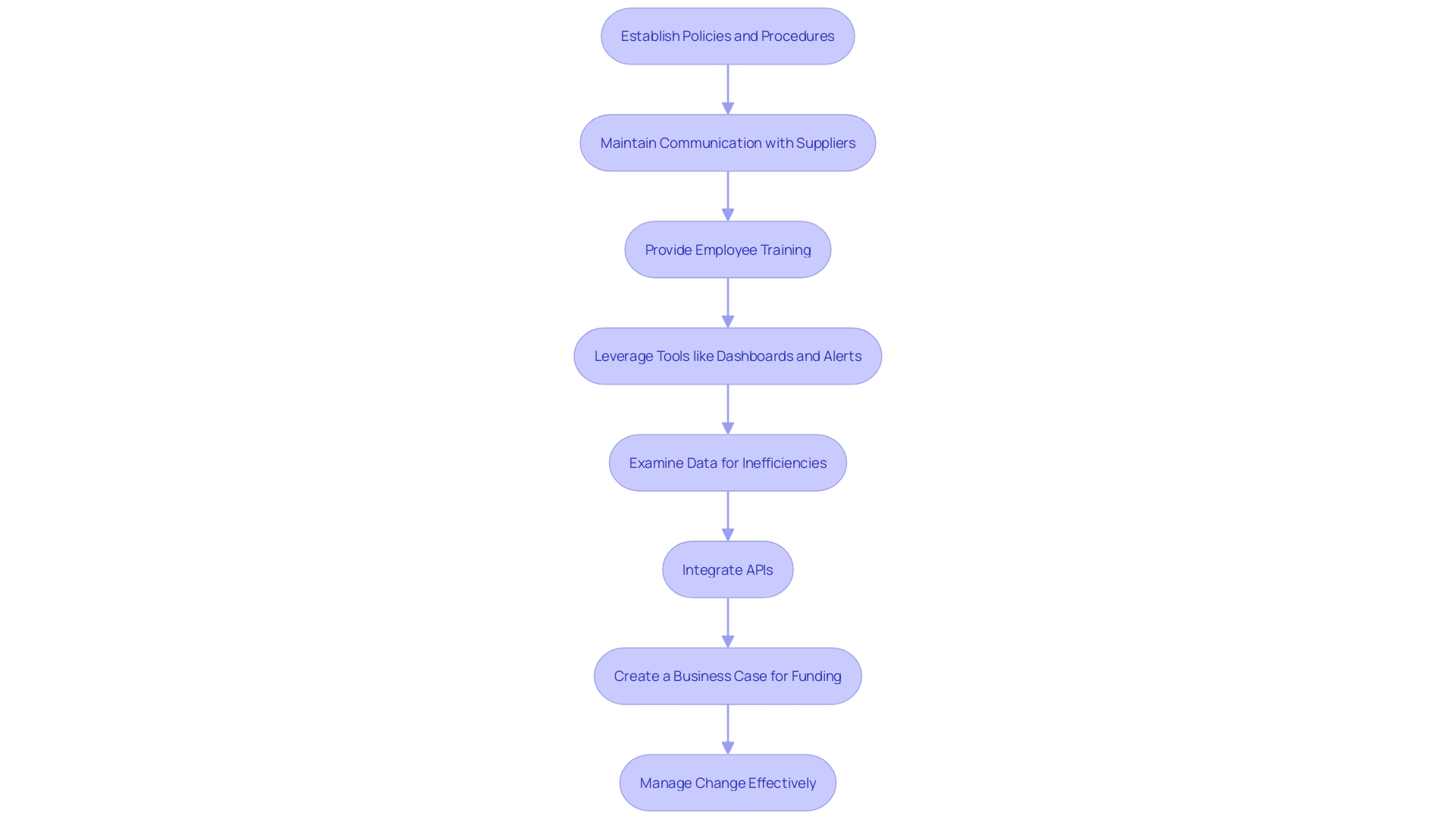
Overcoming Challenges in Procure-to-Pay Automation
Implementing P2P automation presents several challenges, such as employee resistance, integration issues, and data quality concerns. To overcome resistance, it’s crucial to involve employees early in the undertaking and provide comprehensive training. This approach not only addresses resistance but also fosters a collaborative environment, as highlighted by the successful partnership between ADP and PTC, which centralized payroll functions and streamlined processes, resulting in more accurate data for decision-making.
For seamless integration with existing systems, close collaboration with IT teams is essential. This guarantees that the tools are compatible and can function efficiently within the current infrastructure. A recent partnership between Olive Technologies and Procurify emphasizes the importance of bridging gaps between business decision-makers and procurement professionals, enhancing transparency and collaboration in tech purchasing decisions.
Regular assessment of data quality is vital. Establishing protocols for cleaning and maintaining accurate information can significantly improve operational efficiency. According to the Deloitte and Hackett Group surveys, more than 50% of Chief Procurement Officers feel overwhelmed by the increasing complexity and demands of their roles, including data management. By embracing sophisticated data handling methods, like batch processing and real-time processing, entities can optimize the advantages of mechanization and make prompt decisions.
In conclusion, addressing these common challenges in P2P automation requires a multifaceted approach involving employee engagement, seamless integration, and rigorous data quality management. By doing so, organizations can achieve significant improvements in operational efficiency and decision-making.
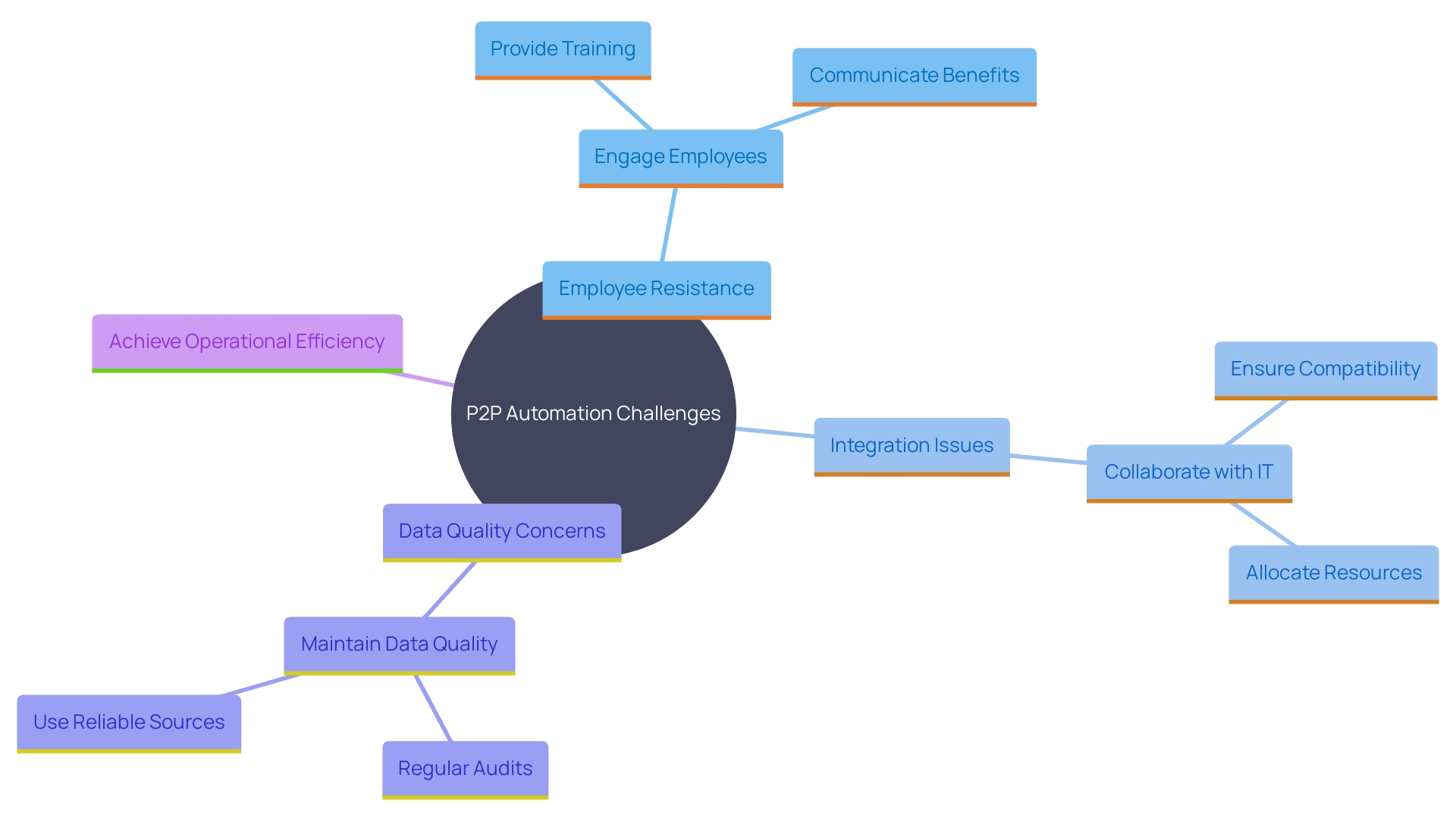
Conclusion
The procure-to-pay (P2P) process is a vital component of organizational efficiency, encompassing every step from needs identification to payment execution. By understanding and optimizing each phase of this cycle, businesses can significantly enhance cash flow management, minimize errors, and foster transparent supplier relationships. The integration of advanced technologies, particularly automation, emerges as a transformative force, streamlining workflows and offering valuable insights that drive strategic decision-making.
The benefits of P2P automation are substantial. Organizations that embrace automation can expect reduced processing times, improved compliance, and enhanced visibility into spending patterns. The incorporation of artificial intelligence and machine learning not only catalyzes business growth but also allows teams to focus on more strategic initiatives, thereby maximizing their operational potential.
However, successful implementation of automation requires careful planning and execution. Selecting the right software, establishing robust protocols, and ensuring seamless integration with existing systems are crucial steps. Organizations should also prioritize ongoing training and communication to mitigate resistance and foster a culture of collaboration.
By addressing common challenges such as data quality and employee engagement, businesses can unlock the full potential of the P2P process.
In a rapidly evolving procurement landscape, organizations that invest in best practices and innovative solutions will not only achieve operational excellence but also maintain a competitive edge. The future of procurement lies in intelligent, data-driven processes that empower organizations to thrive in an increasingly complex environment. Embracing these changes will lead to sustainable business value and enhanced supplier relationships, ensuring long-term success.
Introduction
The insurance industry is on the brink of a transformative era, driven by the integration of artificial intelligence (AI) into claims management. This revolution is not merely about increasing efficiency but also about enhancing accuracy and customer satisfaction. With AI automating repetitive tasks and reducing processing times, insurers like Aflac and Allstate are experiencing faster claim settlements and higher data integrity.
AI’s capabilities extend beyond automation; it engages customers in real-time through sophisticated chatbots and leverages advanced analytics for fraud detection and prevention. However, the path to successful AI implementation is fraught with challenges, including data privacy concerns and the integration of legacy systems. As the industry navigates these complexities, the potential benefits—optimized resource allocation, improved customer service, and minimized human error—are undeniable.
This article delves into the myriad ways AI is reshaping claims processing, from practical applications and fraud prevention to future trends and implementation strategies, offering a comprehensive guide for insurance professionals seeking to harness AI’s full potential.
Benefits of AI in Claims Management
‘The incorporation of AI technologies into management processes is transforming the insurance sector by improving efficiency and precision.’. Automating repetitive tasks significantly reduces processing times, thereby enabling quicker settlement of requests. For instance, Aflac’s partnership with service providers has drastically transformed their request process. Previously, representatives had to manually review each request and form, leading to prolonged processing times. Now, automation allows representatives to perform final accuracy checks, saving considerable time and effort.
AI’s capability to reduce human mistakes guarantees greater information integrity and reliability. As Don Jones, Senior Vice President of Claims Design and Delivery at Allstate, points out, AI can analyze claims trends and data, supporting informed, data-driven decisions. This is especially clear in the management of the first notice of loss (FNOL), where AI can simplify the procedure, making it easier for customers and ensuring precise information transmission.
Moreover, AI enhances customer engagement by providing real-time updates and insights to policyholders through AI-driven chatbots. These systems employ Natural Language Processing (NLP) to comprehend and handle natural language input, enabling more intuitive interactions. This not only improves customer service but also fosters trust and satisfaction among policyholders. As Shawn Crawley, Chief Operating Officer at Sompo International, explains, Ai’s examination of information can identify the seriousness of claims, potential legal action, or fraud, further enhancing the claims management system.
The advantages of AI in risk management are becoming more evident as providers allocate additional resources to AI technologies to enhance customer service and handle the intricate information environment. Despite being in its early stages, the adoption of AI requires experimentation, training, and new operational models. However, the long-term advantages, such as optimized resource allocation and more efficient processes, are undeniable.
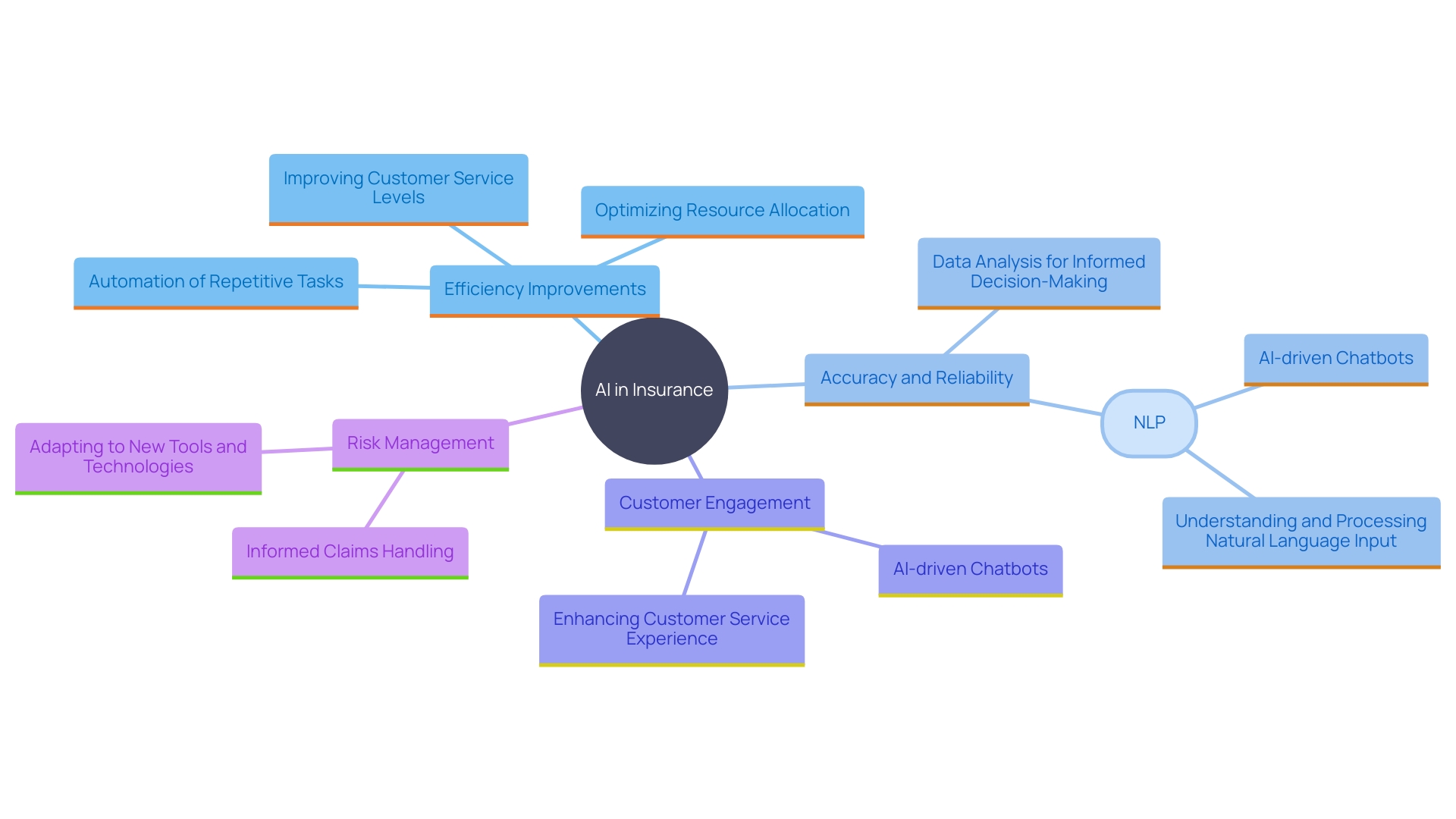
AI Applications in Claims Processing
AI applications in processing requests are revolutionizing the insurance industry by tackling the persistent challenge of managing vast amounts of data. Through natural language processing (NLP), insurers can evaluate submissions more efficiently, enabling more precise and pertinent responses to customer inquiries. Machine learning algorithms further improve this method by forecasting outcomes, which assists in making more informed choices. Image recognition technologies are also crucial, enabling the evaluation of damages through photographs, thus accelerating the process and minimizing manual intervention.
These AI-driven tools revolutionize the management environment by automating information extraction, categorizing requests, and prioritizing them according to complexity or risk. This automation not only improves operational efficiency but also enhances customer service levels by ensuring claims are handled promptly. As Wilde and Dhar have highlighted, the adoption of AI and machine learning offers a solution to the difficulties insurers face with mixed structured and unstructured data, providing ways to manage and process this complex information more effectively.
Furthermore, the sector’s investment in AI technologies keeps expanding, motivated by the necessity to enhance customer service and adjust to the rising complexity and competition in the market. By addressing various phases of the risk management process—such as risk exposure identification, evaluation, estimation, and effect assessment—AI assists firms in achieving a balance between swift, empathetic resolution and protection against fraud and litigation risks.
‘In light of recent regulatory updates, such as New York State’s new guidelines on AI usage in the financial sector, it is clear that while AI offers transformative potential, it must be deployed with clear rules to ensure sustainable digital transformation.’. This regulatory environment emphasizes the significance of using AI responsibly to avoid unjust settlement practices and discrimination, thus maintaining trust and transparency in the insurance industry.
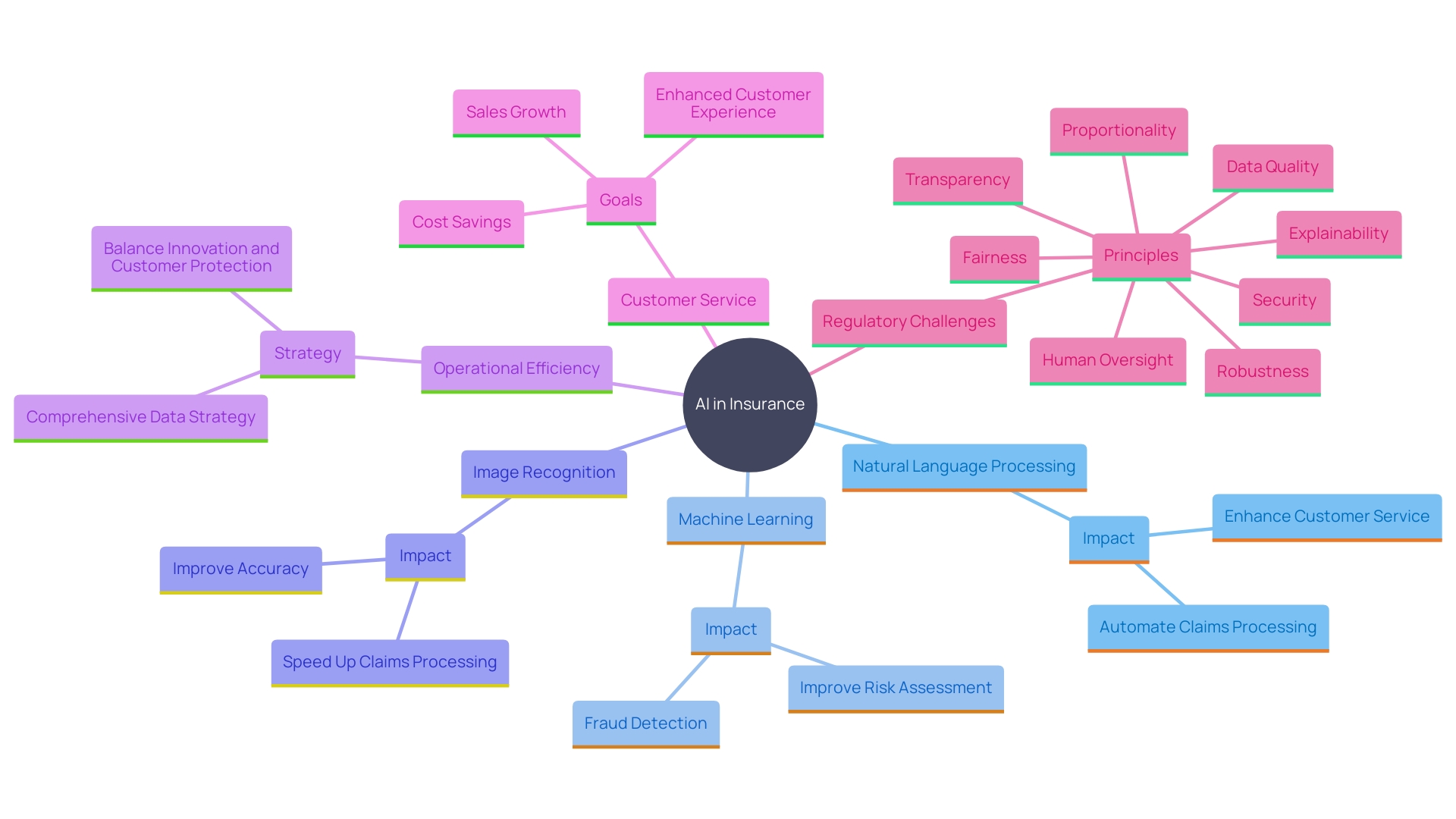
Fraud Detection and Prevention
Artificial intelligence is revolutionizing the way insurers identify and mitigate fraudulent claims. Leveraging advanced analytics and pattern recognition, insurers can now detect anomalies and suspicious activities with unprecedented accuracy. ‘This shift is essential as traditional methods, which depended largely on manual tasks and basic rule-based systems, have become increasingly insufficient against advanced fraudulent activities.’.
AI’s capability to examine extensive quantities of information instantly is changing fraud detection into a more streamlined and impactful operation. Machine learning models continuously evolve, learning from past data to enhance their predictive capabilities. ‘This not only enables immediate fraud identification but also assists in stopping fraud before it happens, thus conserving insurers significant financial resources and protecting the integrity of the claims framework.’.
For instance, companies that have incorporated AI into their operations have reported significant improvements in various metrics. According to Capgemini, insurers using AI have achieved faster processing times, reduced expenses, and better fraud detection rates compared to their counterparts. This is particularly relevant as underwriters, who spend over 41% of their time on administrative tasks, can now redirect their efforts towards core responsibilities like risk assessment and premium calculation.
The demand for AI in fraud detection is on the rise globally, driven by the need for real-time detection, regulatory compliance, and the expectation of a seamless customer experience. As the insurance industry continues to navigate this digital era, AI stands as a pivotal tool in enhancing operational efficiency and maintaining financial stability.
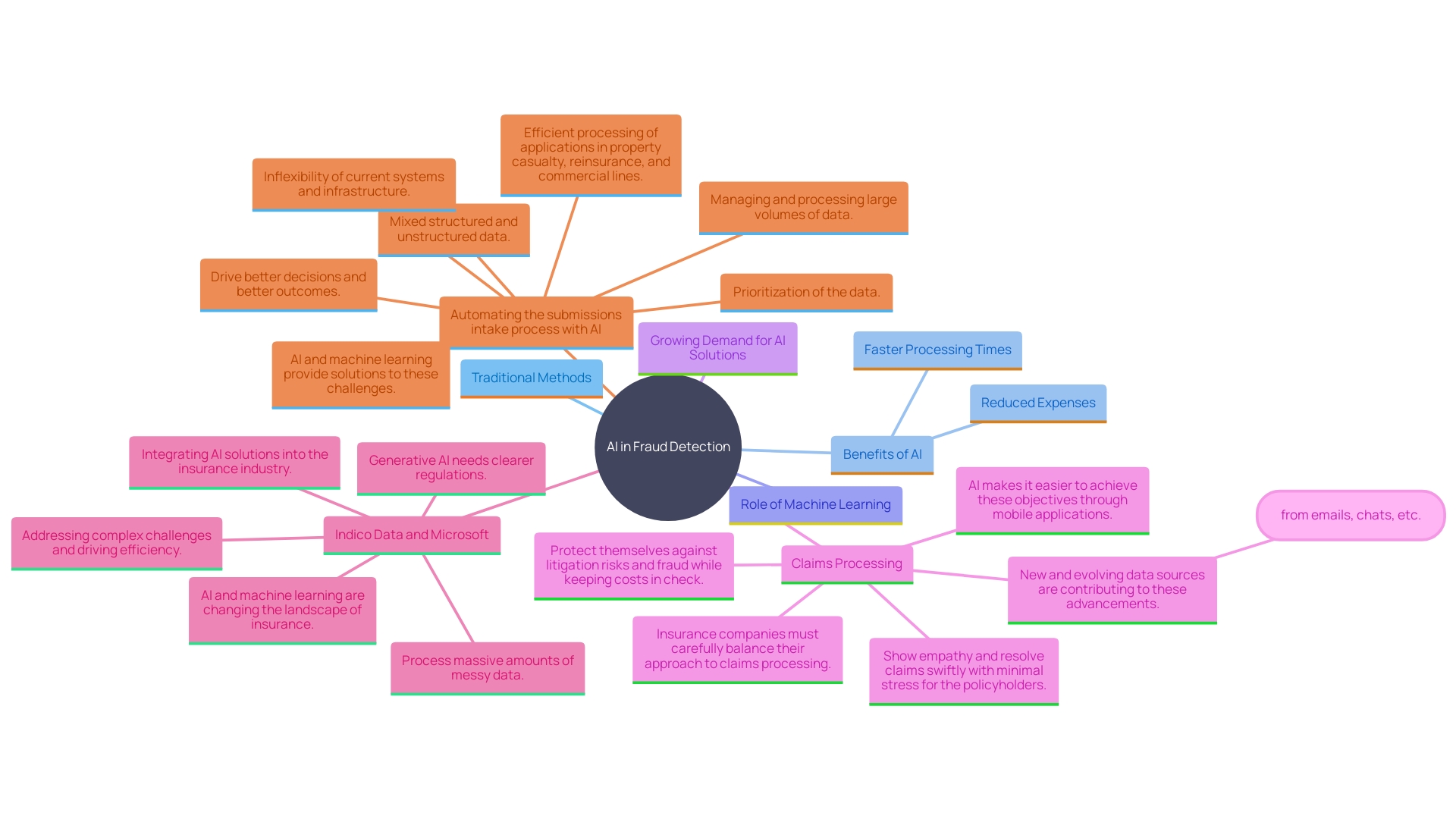
Implementation Strategies for AI in Claims Processing
Effective execution of AI in processing requests necessitates a clear plan that starts with a comprehensive evaluation of existing procedures and the identification of particular challenges that AI can resolve. This step is crucial for ensuring that the AI solutions selected are tailored to the organization’s unique challenges, much like the Digital Technology Assessment Checklist (DTAC) used to evaluate new technologies. Working together with IT and analytics groups is crucial to guarantee that the AI tools selected are both efficient and adhere to industry standards, such as those specified by New York’s Department of Financial Services to avoid the improper use of AI in processing requests.
Continuous training and change management efforts are equally vital. Ensuring staff are well-versed in new technologies not only facilitates a smoother transition but also maximizes the benefits of AI. As Rasheed Walker, an apprentice at Sedgwick, notes, integrating AI into early career programs and fostering an environment of continuous improvement can lead to significant efficiency gains and innovation. Furthermore, Ai’s role in handling substantial amounts of varied information, as emphasized by industry specialists Wilde and Dhar, highlights its potential to enhance decisions and results in claims processing.
Ultimately, the harmonized collaboration between people, AI, and automation within a connected enterprise ecosystem is key to accelerating transformative growth in the insurance industry. This approach empowers employees, enhances customer service, and continually raises industry benchmarks.
Challenges and Limitations of AI in Claims Processing
While AI presents numerous opportunities, there are also challenges to consider. Data privacy and security concerns must be addressed to comply with regulations and protect customer information. For example, Retail Bank partnered with a synthetic information provider to reduce risks when testing AI solutions, adhering to the information minimization principle and decreasing security threats. Additionally, the complexity of integrating AI with legacy systems can pose significant hurdles. Traditional insurers often struggle with the inflexibility of their existing infrastructure, which can hinder the efficient processing of applications and data. AI can streamline this process, but it’s crucial to ensure that the technology is compatible with current systems.
Organizations must also be aware of the potential for bias in AI algorithms, necessitating ongoing monitoring and adjustments to ensure fair outcomes. The recent case of UnitedHealthcare’s alleged misuse of AI to deny critical health coverage underscores the importance of ethical AI deployment. To prevent such issues, continuous oversight and adherence to regulatory guidelines, like those set forth by New York’s Department of Financial Services, are essential. These measures help safeguard against unfair practices and ensure that AI technologies are used responsibly and effectively in the sector.

Future Trends and Opportunities
The future of AI in insurance processing is incredibly promising, marked by significant advancements in technology and methodology. Generative AI, a branch of artificial intelligence, is poised to transform the industry by improving the customer experience and speeding up the resolution. For example, during the initial Notice of Loss intake, generative AI can enhance the evaluation of policy coverage, extract essential information, and identify knowledge gaps, making the procedure more efficient and precise.
The combination of AI with blockchain technology further improves transparency and security in processing requests. Blockchain’s unchangeable ledger offers a reliable account of all exchanges, which, when paired with Ai’s analytical abilities, guarantees a more secure and efficient processing system. This technological synergy not only speeds up transactions but also builds greater trust with policyholders.
Additionally, predictive analytics driven by AI will become more widespread, allowing insurers to anticipate trends in requests and modify their strategies in advance. By examining extensive information sets, AI can recognize trends and forecast future requests, enabling insurers to reduce risks and enhance their operations.
The sector is already witnessing a surge in demand for data-driven decision-making, with advanced analytics tools empowering providers to extract valuable insights from their data repositories. This capability enhances underwriting accuracy, improves risk management, and reduces fraud, ultimately leading to better profitability and customer satisfaction.
Insurers must balance innovation with regulatory compliance and customer protection. As noted in recent industry reports, the adoption of AI requires careful consideration of principles such as transparency, fairness, and human oversight to ensure ethical and responsible implementation.
In summary, the integration of AI and blockchain, coupled with the rise of predictive analytics, is set to transform the insurance claims process, making it more efficient, transparent, and customer-centric.
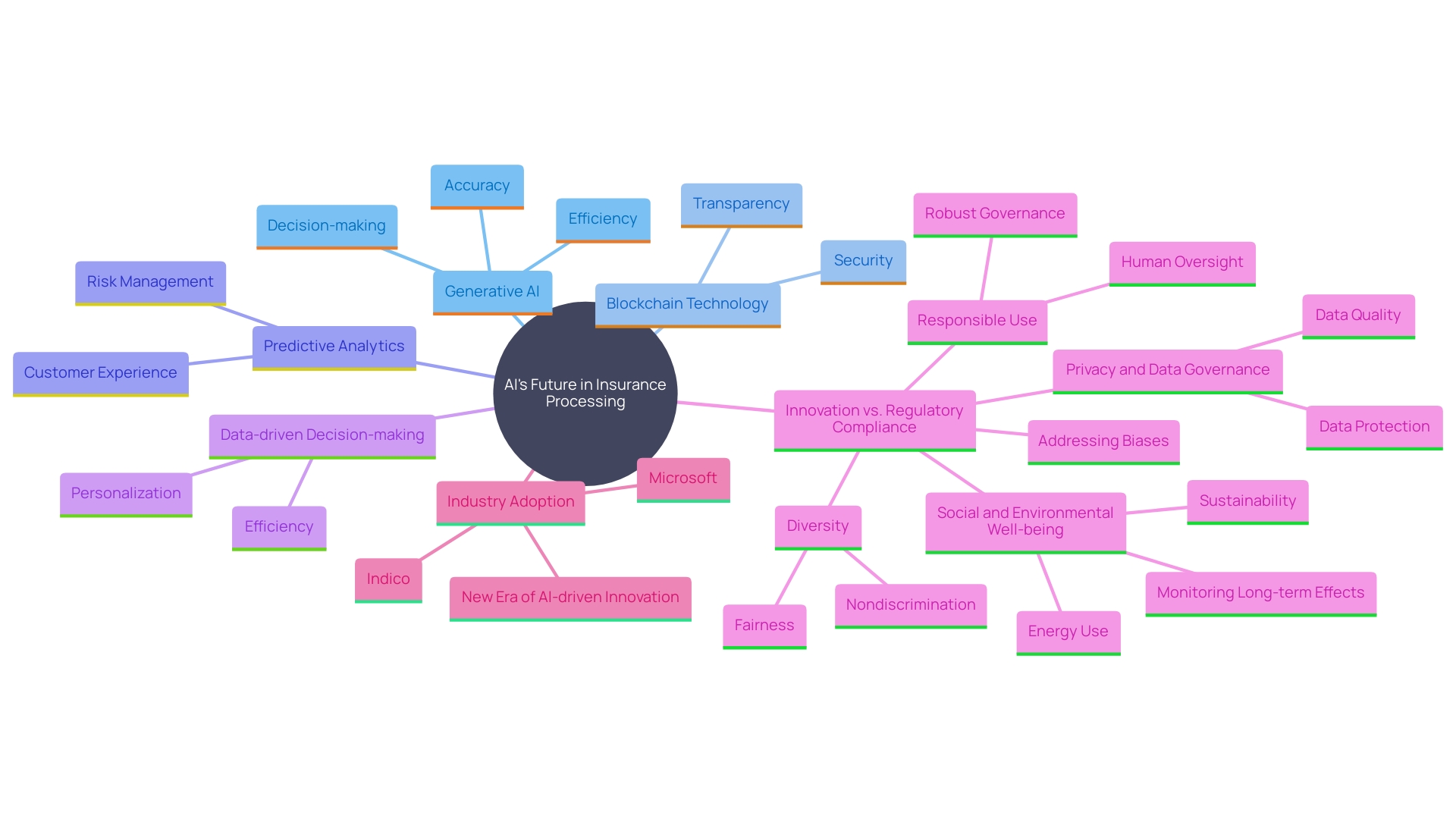
Conclusion
The integration of artificial intelligence in claims management is revolutionizing the insurance industry by enhancing efficiency, accuracy, and customer satisfaction. Insurers like Aflac and Allstate are harnessing AI to automate repetitive tasks, which significantly reduces processing times and improves data integrity. This transformation not only accelerates claims settlements but also fosters real-time engagement with customers.
AI technologies, such as natural language processing and image recognition, streamline data management, allowing for quicker damage assessments and more accurate claim predictions. Moreover, AI is pivotal in fraud detection, enabling insurers to identify suspicious activities and prevent fraudulent claims effectively.
Despite these advancements, challenges remain. Organizations must address data privacy concerns, potential algorithm biases, and compatibility issues with legacy systems. Ongoing training and change management are crucial for maximizing the benefits of AI.
The future of AI in claims processing holds great promise, with innovations like generative AI and blockchain enhancing security and transparency. Insurers must balance these technological advancements with ethical considerations to maintain trust and ensure responsible implementation.
In conclusion, the potential of AI in claims management is substantial. By strategically investing in AI technologies, insurers can create a more efficient and customer-centric claims process, ultimately leading to improved service delivery and satisfaction. Embracing AI responsibly is essential for unlocking its full potential for all stakeholders involved.
Introduction
Navigating the complexities of modern supply chain management requires more than just traditional methods. With challenges such as manual processes, lack of visibility, and inefficient communication, many organizations find themselves grappling with delays, increased costs, and errors. However, a transformative shift is on the horizon.
Robotic Process Automation (RPA) is revolutionizing the supply chain landscape by automating repetitive tasks, enhancing accuracy, and enabling faster decision-making. This article delves into the pressing challenges of traditional supply chain management, elucidates the benefits and key applications of RPA, and offers best practices for its implementation. Additionally, it explores the synergistic potential of combining RPA with Artificial Intelligence (AI) to create advanced, resilient supply chains.
Discover how leveraging these technologies can elevate operational efficiency, reduce risks, and provide a strategic advantage in today’s dynamic market.
Challenges in Traditional Supply Chain Management
Conventional logistics management often struggles with manual procedures, absence of transparency, and ineffective communication. These issues lead to delays, increased costs, and errors that hinder overall productivity. Data silos, where information isn’t shared across departments, lead to poor decision-making and a reactive approach to logistical challenges. Based on recent surveys, merely 60% of companies possess thorough insight into their tier-one suppliers, emphasizing a notable deficiency in logistical intelligence. Moreover, fewer than a quarter of organizations have formal procedures to address procurement issues at the board level, leaving firms vulnerable to risks and interruptions.
On the positive side, 73% of companies report progress on dual-sourcing strategies, and 60% are regionalizing their logistics to mitigate risks. This shift towards resilience is also seen in the implementation of advanced planning and scheduling (APS) systems, with two-thirds of respondents making headway. These systems enhance planning accuracy, enable rapid responses to disruptions, and improve overall resilience. As Melissa Twiningdavis, Senior Managing Director of Supply Chain Operations at Accenture, notes, “In today’s environment, the challenge is to drive cost efficiency while continuing to embed and accelerate resiliency.”
Companies like OnProcess are leading the transformation in supply chain operations by leveraging domain talent, data, and processes to create end-to-end solutions. ‘This emphasis on logistics operations has become an essential source of competitive edge, highlighting the necessity for thorough risk management and proactive strategies to navigate the intricacies of contemporary logistics.’.
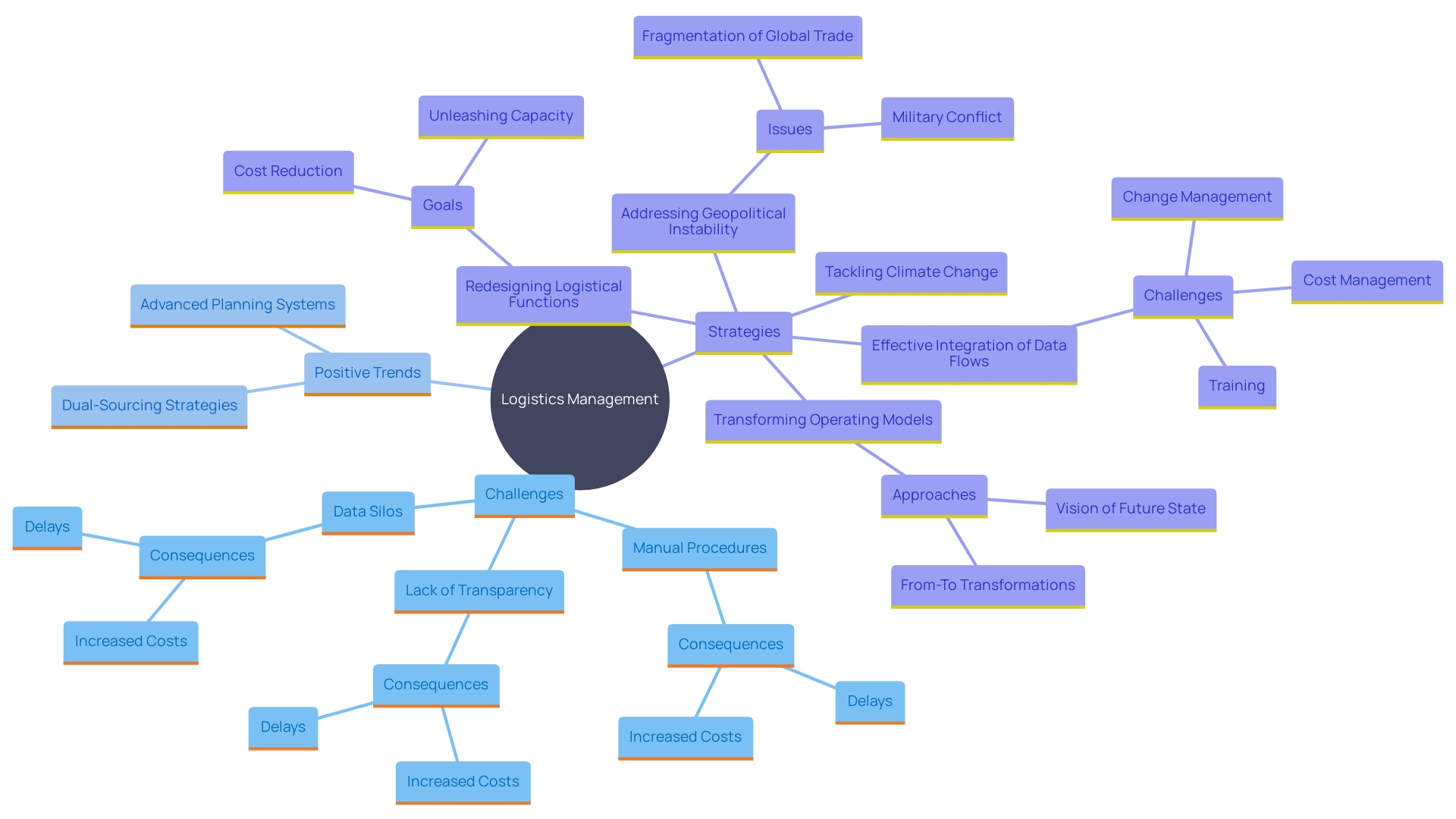
Benefits of RPA in Supply Chain Management
Robotic Process Automation (RPA) provides transformative advantages in logistics management, driving increased precision, lowered operational expenses, and improved process speed. By automating repetitive and rule-based tasks, RPA significantly minimizes human error and liberates employees to concentrate on strategic initiatives. For instance, St. James Winery in Missouri leveraged automation to address labor shortages and improve production efficiency, resulting in higher margins and faster production speeds.
Furthermore, RPA offers real-time information access, which is essential for improved decision-making and quick reactions to market changes. “As stated by Steve Murphy from Panorama Consulting Group, the pace of information transfer in logistics has changed significantly, improving information precision and operational velocity.”. This evolution, coupled with the ability of RPA to handle data swiftly, ensures that goods move quicker from receiving purchase orders to shipping.
As worldwide distribution networks encounter persistent issues like geopolitical tensions and strict regulations, the implementation of RPA is becoming essential. The Capgemini Research Institute underscores the significance of robust and effective logistics networks, stressing that technologies such as RPA are crucial in managing these challenges. Additionally, the growing demand for automation is evident, with companies planning to increase their investment significantly over the next five years, as noted by industry experts.
In summary, RPA not only improves operational efficiency but also offers a strategic edge in navigating the dynamic environment of global logistics.
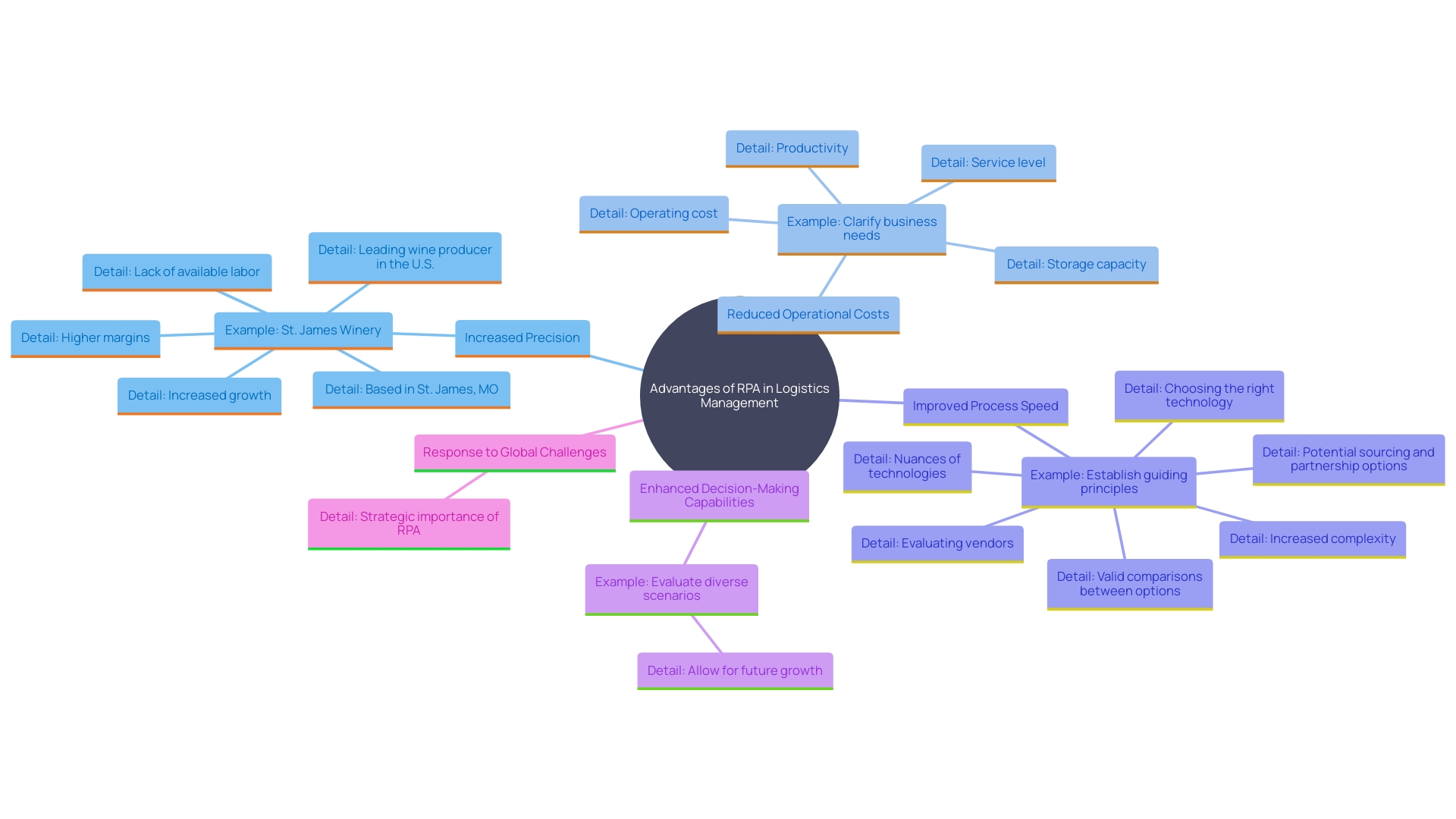
Key Applications of RPA in Supply Chain
RPA can transform logistics operations by automating order processing, enhancing inventory management, and improving shipment tracking. For instance, automated storage and retrieval systems (AS/RS) provide real-time visibility of inventory, dramatically reducing product damage and waste by minimizing manual handling. This shift has more than doubled capacity for some organizations, showcasing how RPA can transform previously manual operations into efficient automated workflows.
In the automotive sector, overseeing the accuracy and responsiveness of resources has become essential. Firms such as Renault have embraced a digital strategy to manage logistical tensions, highlighting the significance of a Strategic Operations and Planning (S&OP) depth of 24 months to alleviate component crises. This highlights how RPA can enhance operational efficiency and ensure timely responses to market demands.
Additionally, the integration of AI and robotics within warehouses has significantly advanced inventory management. Modern tracking systems with RFID technology streamline the flow of goods from receiving to shipping, ensuring accuracy and speed. With AI investments on the rise, companies are achieving substantial revenue increases, demonstrating the financial benefits of adopting RPA technologies.
Overall, the implementation of RPA in logistics enhances workflows, decreases lead times, and satisfies customer needs effectively, presenting a strong argument for its broad adoption.
![]()
Best Practices for Implementing RPA in Supply Chain
Effectively executing RPA in the logistics network requires a calculated and carefully planned method. Begin with a thorough process assessment to identify areas ripe for automation, such as repetitive tasks and data-driven operations. Engaging stakeholders from different departments is crucial to ensure alignment and mitigate resistance to change. St. James Winery, for instance, successfully navigated these challenges by involving various teams early in the automation process, resulting in higher margins and operational efficiency.
Establishing clear metrics for success is vital. For example, metrics could include reduced processing times, error rates, and cost savings. Monitoring these metrics continuously will refine the RPA implementation over time, ensuring maximum impact. According to a recent global survey of 1,639 automation professionals by UiPath, organizations that set clear performance indicators saw a significant improvement in their automation initiatives.
Moreover, leveraging the expertise of professionals and integrating advanced technologies like AI can enhance decision-making processes. As mentioned by Melissa Twiningdavis, Senior Managing Director of Logistics Operations at Accenture, the emphasis on logistical processes has become a crucial source of competitive edge. By integrating domain expertise, information, and processes, organizations can successfully transform their operations.
To illustrate, only a few companies have progressed to the advanced phases of digital transformation, using intelligent workflows to orchestrate logistics processes. This highlights the importance of adopting a deliberate approach to transformation, recognizing the value of employee buy-in and proper data encapsulation. As digital transformation continues to evolve, it fundamentally changes how organizations create value within their distribution networks, making it essential to stay ahead of technological advancements.

Combining RPA with AI for Advanced Supply Chain Automation
Combining RPA with Artificial Intelligence (AI) can greatly improve logistics efficiency and resilience. While RPA streamlines repetitive tasks, AI provides advanced information analysis capabilities, promoting more intelligent decision-making. Renault’s logistics digitalization journey exemplifies this synergy. By establishing a comprehensive information lake and allocating a substantial part of their IT budget to structuring, Renault has built a strong base for integrating AI. This has facilitated the creation of an advanced control tower that accurately oversees factory resources, as detailed by Ludovic Doudard, General Manager Process Engineering Logistics at Renault.
AI’s impact extends beyond data analysis. “AI simulation platforms, such as those emphasized by Michel Morvan, Co-founder and Executive Chairman of Cosmo Tech, offer managers with insight into the possible effects of choices, enhancing trade-offs between profitability, service levels, and sustainability.”. These platforms enable the modeling of logistics behavior under different scenarios, assisting companies in predicting interruptions and adjusting as needed.
The benefits of integrating AI and RPA are quantifiable. According to McKinsey, businesses employing AI and machine learning in their logistics can lower expenses by 10%. Additionally, AI-driven demand forecasting and inventory management can lower inventory carrying expenses by 20% and minimize stockouts by 50%, improving overall system resilience.
Renault’s commitment to AI is further evidenced by their ambitious goal to generate 45 million euros in digital value through AI projects, supported by the Dataiku platform. This initiative highlights the transformative potential of AI in logistics management. By leveraging both RPA and AI, businesses can create more agile, responsive, and efficient supply chains, capable of navigating the complexities of the modern market.
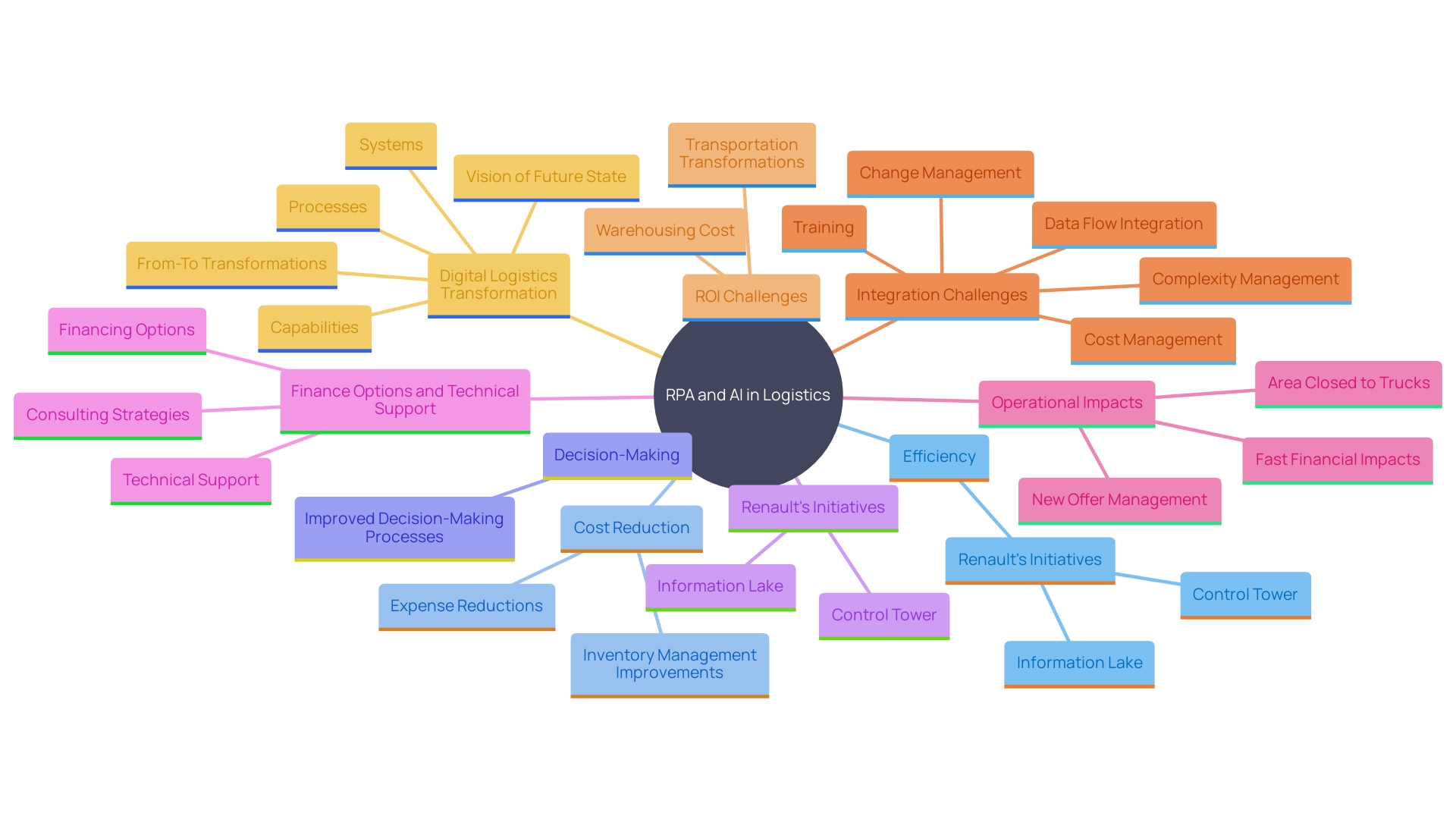
Conclusion
The challenges facing traditional supply chain management are significant, marked by issues like manual processes, lack of visibility, and inefficient communication. These hurdles can lead to delays, increased costs, and errors that compromise productivity. However, a proactive approach is emerging, with organizations increasingly adopting technologies such as Robotic Process Automation (RPA) to enhance operational efficiency and resilience.
By automating repetitive tasks and improving data access, RPA not only minimizes human error but also empowers teams to focus on strategic initiatives.
The applications of RPA in supply chain functions are vast, ranging from automating order processing to enhancing inventory management. Companies that have embraced RPA are witnessing transformative changes, such as improved shipment tracking and better responsiveness to market demands. The integration of RPA with Artificial Intelligence (AI) further amplifies these benefits, enabling smarter decision-making and advanced data analysis.
This combination fosters a supply chain environment that is both agile and resilient, adept at navigating the complexities of a dynamic market landscape.
Implementing RPA requires a strategic approach, beginning with a thorough assessment of processes to identify automation opportunities. Engaging stakeholders and establishing clear metrics for success are critical steps in this journey. Companies that prioritize these best practices are better positioned to realize the full potential of RPA, leading to enhanced operational efficiency and competitive advantage.
As the landscape of supply chain management continues to evolve, embracing these innovative technologies will be essential for organizations aiming to thrive in an increasingly complex environment.
